| Lufthansa City | Paris (CDG) → Munich (MUC) | A320neo | Business | 17/07/2025 | Short review - 3.9/5 |
| Lufthansa | Munich (MUC) → New Delhi (DEL) | A380-800 | Business | 17/07/2025 | Short review - 4.1/5 |
| IndiGo | New Delhi (DEL) → Jaipur (JAI) | A320-200 | Economy | 18/07/2025 | Short review - 3.3/5 |
| Air India | Jaipur (JAI) → Mumbai (BOM) | A320neo | Premium Economy | 24/07/2025 | Short review - 3.9/5 |
| Air India | Mumbai (BOM) → New Delhi (DEL) | 787-9 | Premium Economy | 25/07/2025 | Short review - 4.3/5 |
| Air India | New Delhi (DEL) → Phuket (HKT) | A320neo | Premium Economy | 26/07/2025 | Short review - 3.3/5 |
| Thai Airways | Phuket (HKT) → Bangkok (BKK) | A320-200 | Economy | 06/08/2025 | Short review - 3.3/5 |
| Shanghai Airlines | Bangkok (BKK) → Shanghai (PVG) | 737 MAX 8 | Economy | 09/08/2025 | Short review - 3.7/5 |
| Lufthansa | Shanghai (PVG) → Munich (MUC) | A350-900 | Business | 11/08/2025 | Current review |
| Lufthansa | Munich (MUC) → Paris (CDG) | A320-200 | Business | 12/08/2025 | Short review - 4/5 |
| Lufthansa City | Paris (CDG) → Munich (MUC) | A320neo | Business | 17/07/2025 | Short review - 3.9/5 |
| Lufthansa | Munich (MUC) → New Delhi (DEL) | A380-800 | Business | 17/07/2025 | Short review - 4.1/5 |
| IndiGo | New Delhi (DEL) → Jaipur (JAI) | A320-200 | Economy | 18/07/2025 | Short review - 3.3/5 |
| Air India | Jaipur (JAI) → Mumbai (BOM) | A320neo | Premium Economy | 24/07/2025 | Short review - 3.9/5 |
| Air India | Mumbai (BOM) → New Delhi (DEL) | 787-9 | Premium Economy | 25/07/2025 | Short review - 4.3/5 |
| Air India | New Delhi (DEL) → Phuket (HKT) | A320neo | Premium Economy | 26/07/2025 | Short review - 3.3/5 |
| Thai Airways | Phuket (HKT) → Bangkok (BKK) | A320-200 | Economy | 06/08/2025 | Short review - 3.3/5 |
| Shanghai Airlines | Bangkok (BKK) → Shanghai (PVG) | 737 MAX 8 | Economy | 09/08/2025 | Short review - 3.7/5 |
| Lufthansa | Shanghai (PVG) → Munich (MUC) | A350-900 | Business | 11/08/2025 | Current review |
| Lufthansa | Munich (MUC) → Paris (CDG) | A320-200 | Business | 12/08/2025 | Short review - 4/5 |
First unveiled in 2017, Lufthansa's Allegris concept has had quite a turbulent journey before becoming a reality. After years of delays and revisions, the project was officially named “Allegris” in 2022 and finally entered commercial service in 2024. Designed as Lufthansa Group's new signature product, Allegris represents a complete overhaul of all four travel classes—First Class, Business Class, Premium Economy, and Economy—featuring brand-new seats and a harmonized design, backed by a total investment of €2.5 billion.
However, behind the triumphant announcement, the program faced numerous setbacks: mounting delays, seat certification issues, technical adjustments, and rising market expectations. As of today—over a year since its launch—only ten Munich-based Airbus A350-900s are equipped with the new cabins, with future installations planned for upcoming Airbus A350-900/-1000s, Boeing 787-9s, Boeing 777-9s, and the retrofit of the Boeing 747-8 fleet. Dreamliner deliveries, however, remain on hold due to certification problems linked to the Business Class seat.
It was aboard one of these rare Allegris-equipped Airbus A350s, on a flight from Shanghai to Munich, that I had the opportunity to experience Lufthansa's brand-new Business Class firsthand.
Among the four redesigned classes within the Allegris program, Business Class is arguably the most ambitious—and perhaps the most complex—product Lufthansa has ever created, if not any airline. Staying true to its “Truly Yours” promise, it stands out by offering no fewer than five different seat types within the same cabin, tailored to suit the needs and preferences of every traveler. While most competitors opt for a single seat model, Lufthansa embraces variety: Business Suite, Privacy Window Seat, Extra-Long Bed Seat, Extra Space “Throne” Seat, and the standard Business Class seat. This diversity provides passengers with a wealth of options, though it can also be somewhat confusing for both travelers and cabin crew.
The Allegris-equipped Airbus A350-900 features 38 Business Class seats, all with direct aisle access. The cabin layout includes eight Business Suites, ten Privacy Window Seats, four Extra-Long Bed Seats, four Extra Space “Throne” Seats, and twelve standard seats.
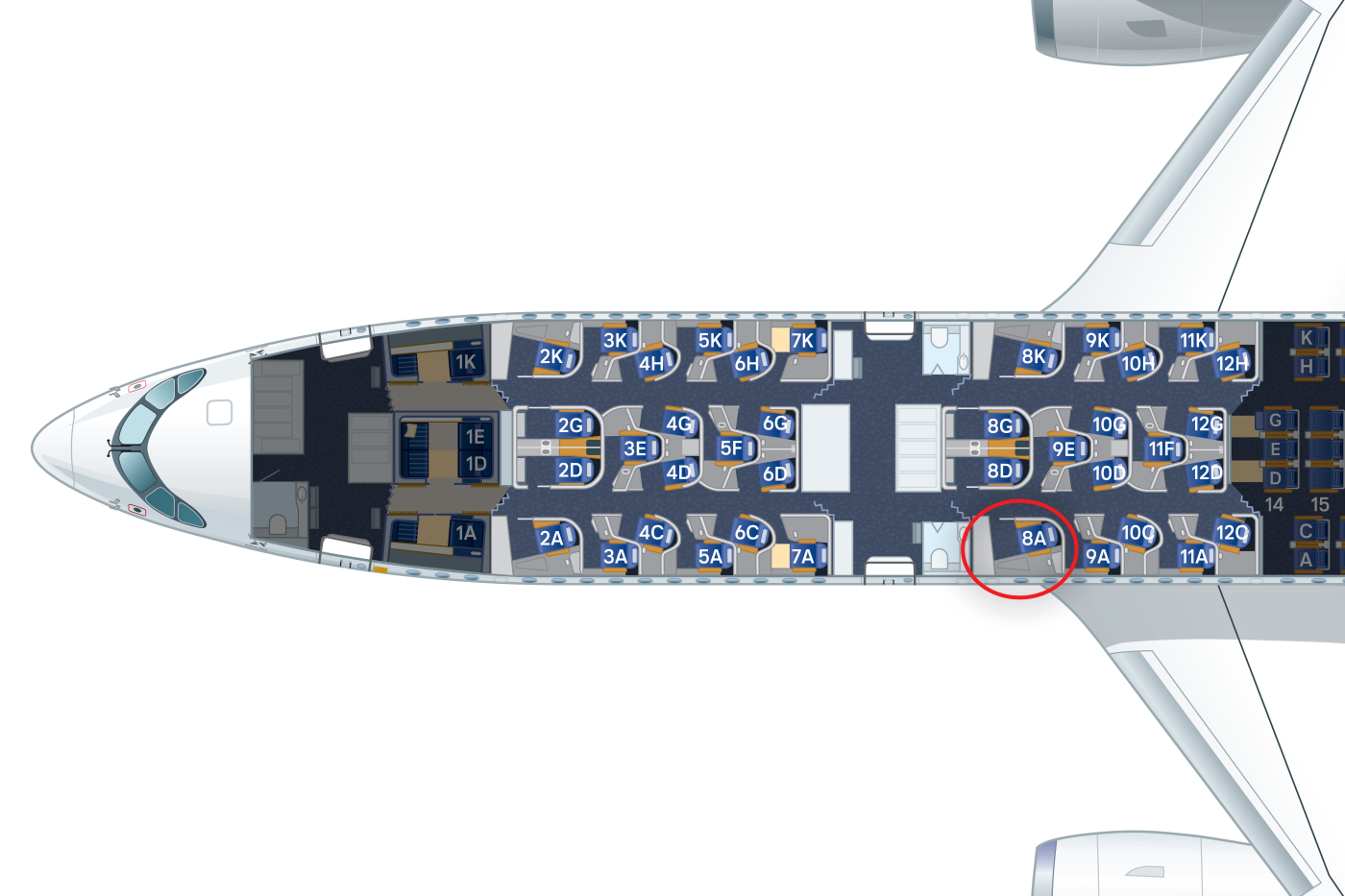
For this flight, I had the chance to try the most exclusive product in the range: the Business Class Suite. Offered as a paid upgrade for €600 above the standard fare, the Suite offers more generous space, enhanced privacy, and several exclusive features. On the A350-900, the eight Business Suites are located in rows 2 and 8, divided into four Solo Suites (2A, 2K, 8A, 8K) and four Duo Suites (2D, 2G, 8D, 8G).
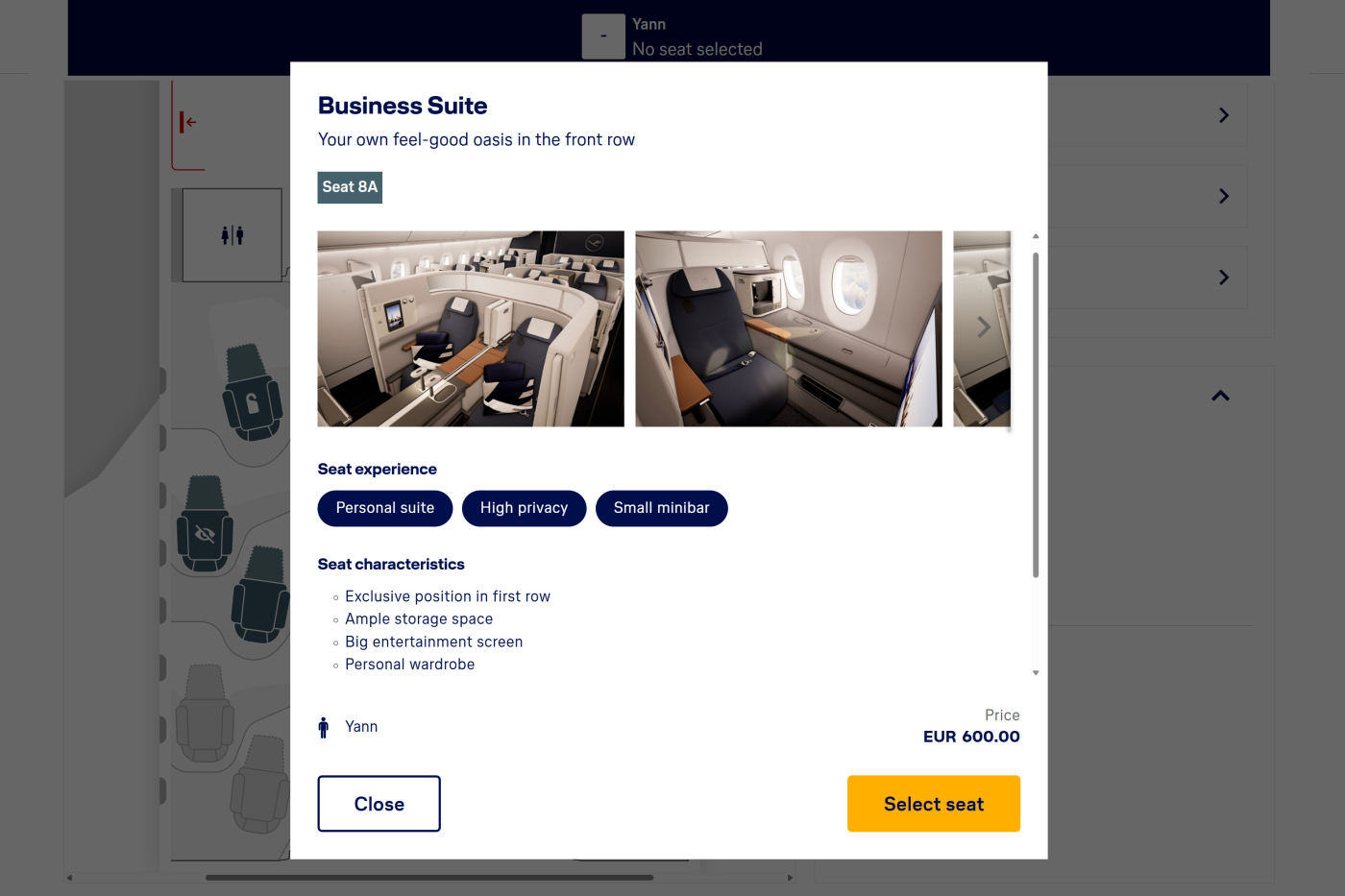
Although these seats are not automatically offered to HON Circle or Senator members and remain payable even during online check-in, I managed to secure one without paying the surcharge. By not selecting a seat in advance and waiting until online check-in opened—when all standard free seats had already been taken—the system automatically assigned me seat 8A, a Solo Suite.
At Shanghai Pudong, Lufthansa operates from Terminal 2. I met up at Gate D61, right in the heart of this impressive terminal.
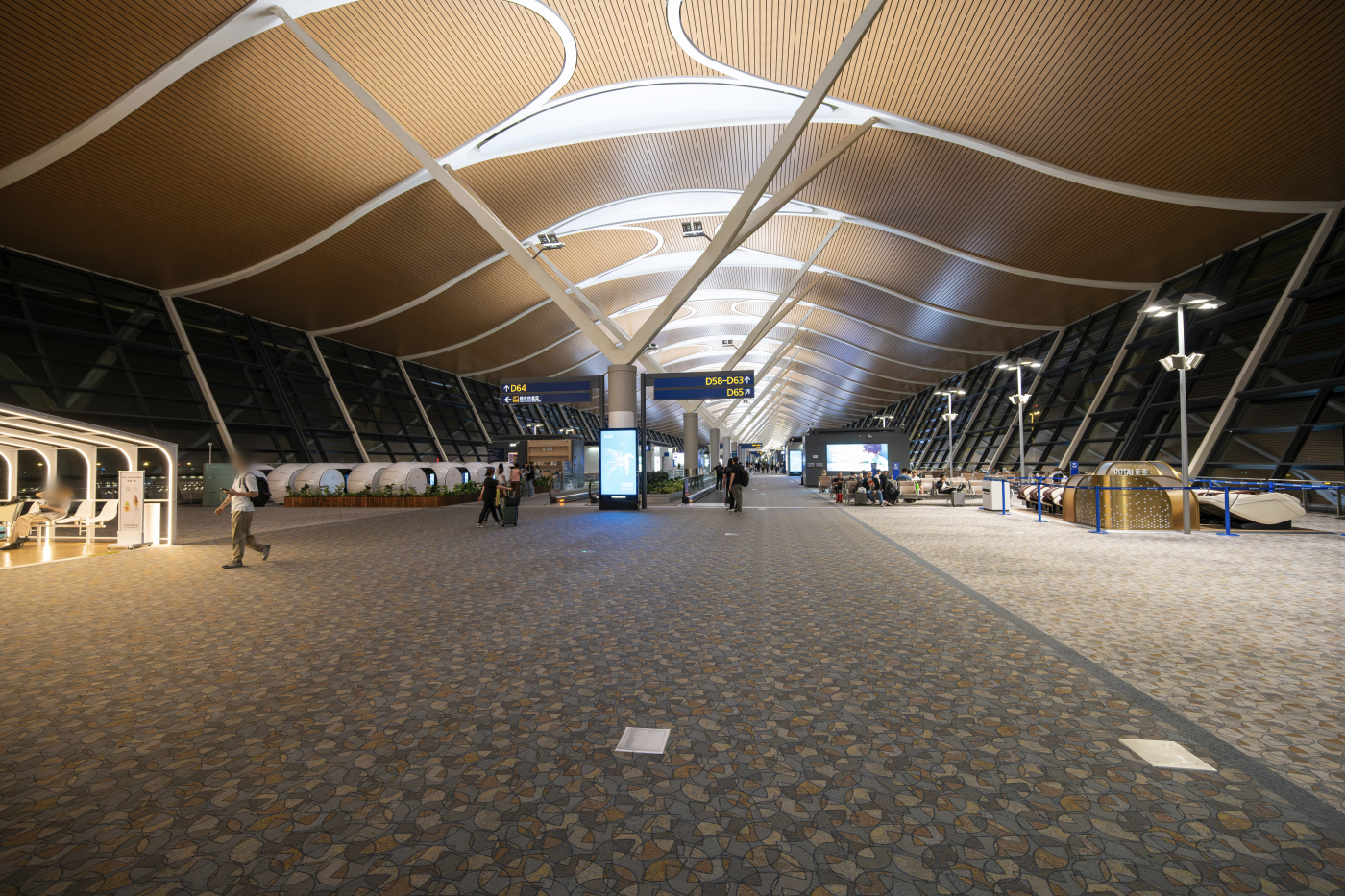
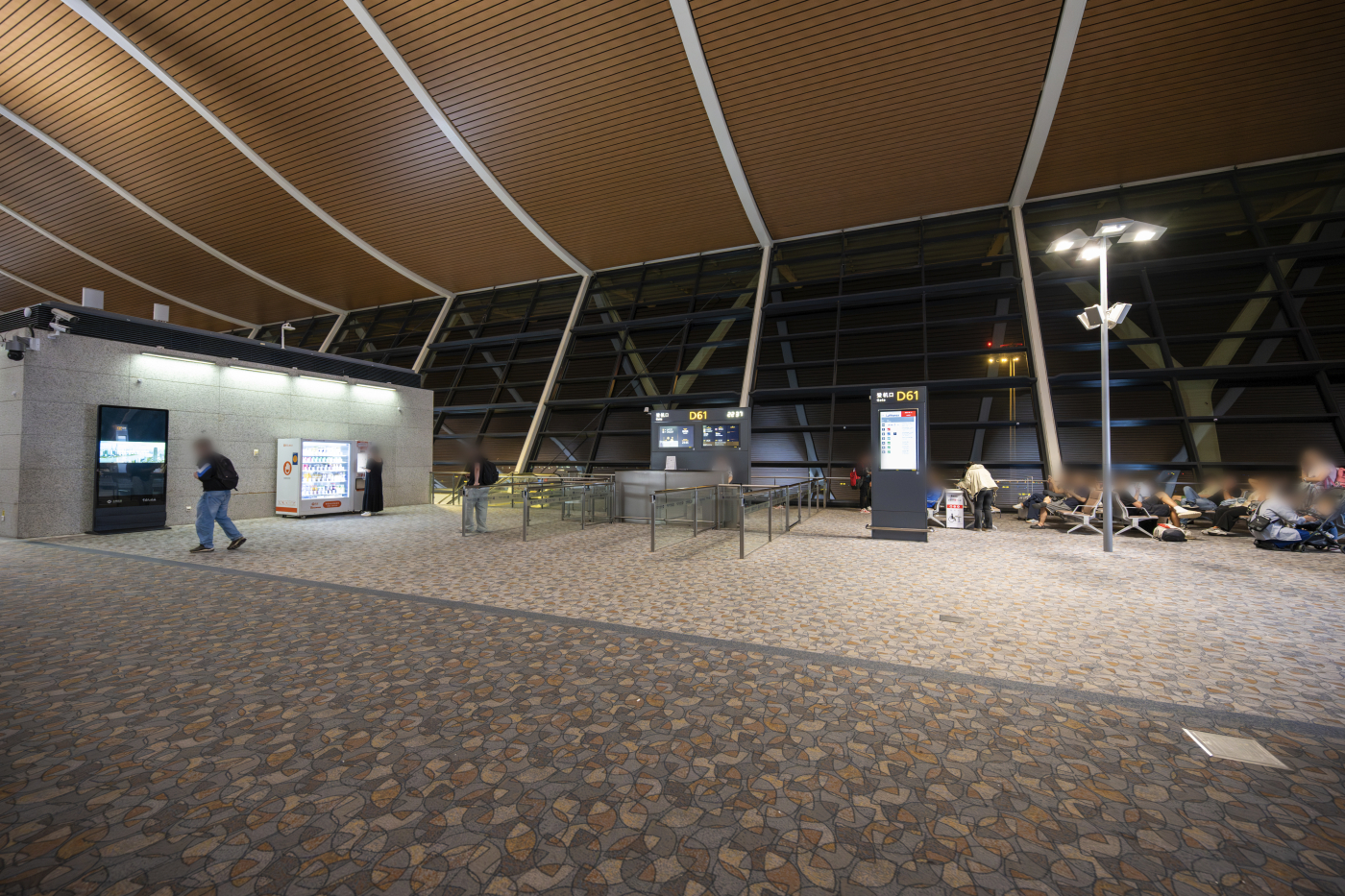
Waiting for me was D-AIXS, the Airbus A350-941 that would take me to Munich that night. Delivered at the end of 2023 and named after the German city of Gelsenkirchen, this aircraft is the second A350 in the fleet to feature the Allegris cabin.
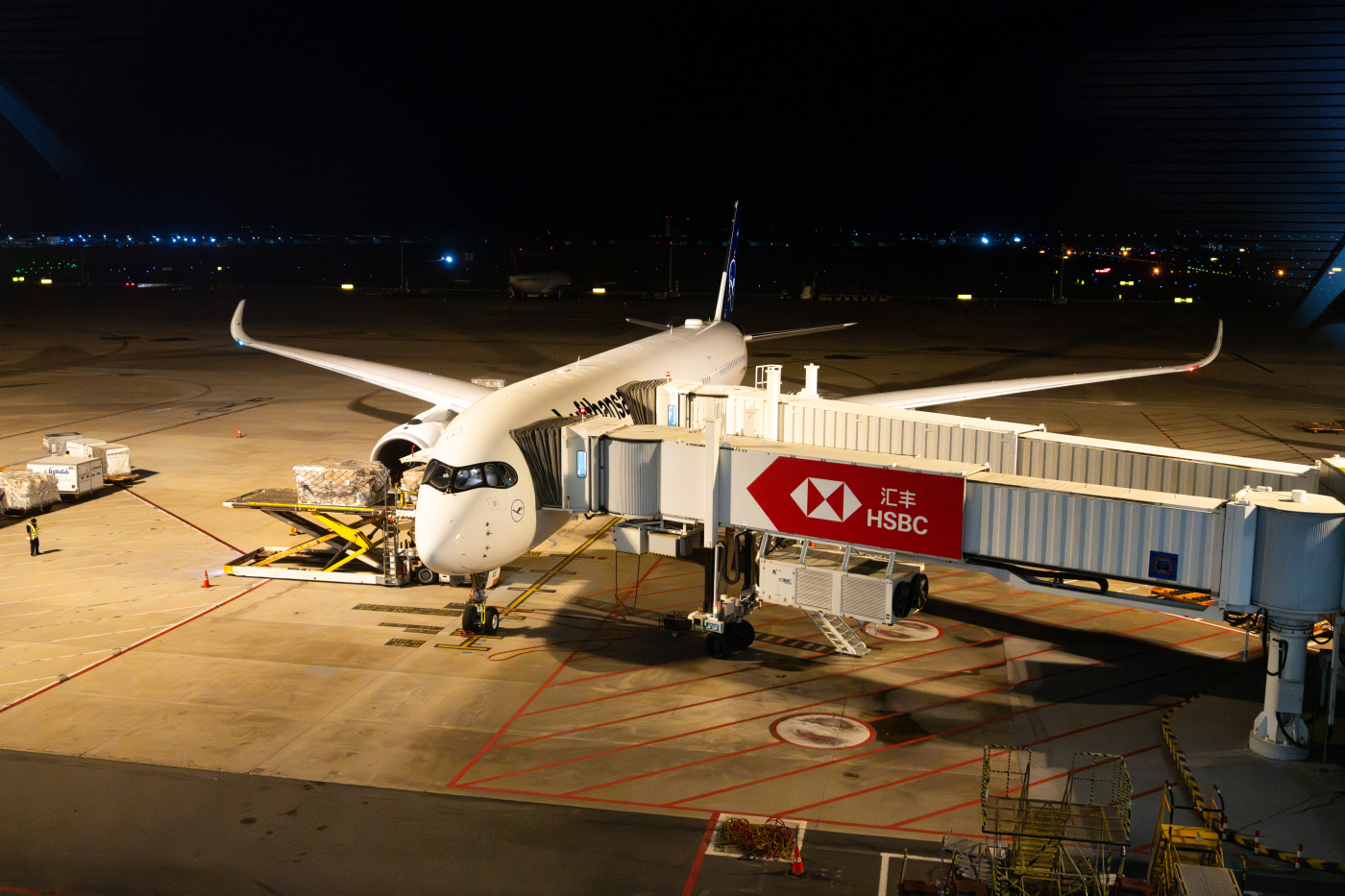
Boarding proceeded smoothly, organized by priority groups. I was among the first to board, allowing me to enjoy a cabin that was still empty.


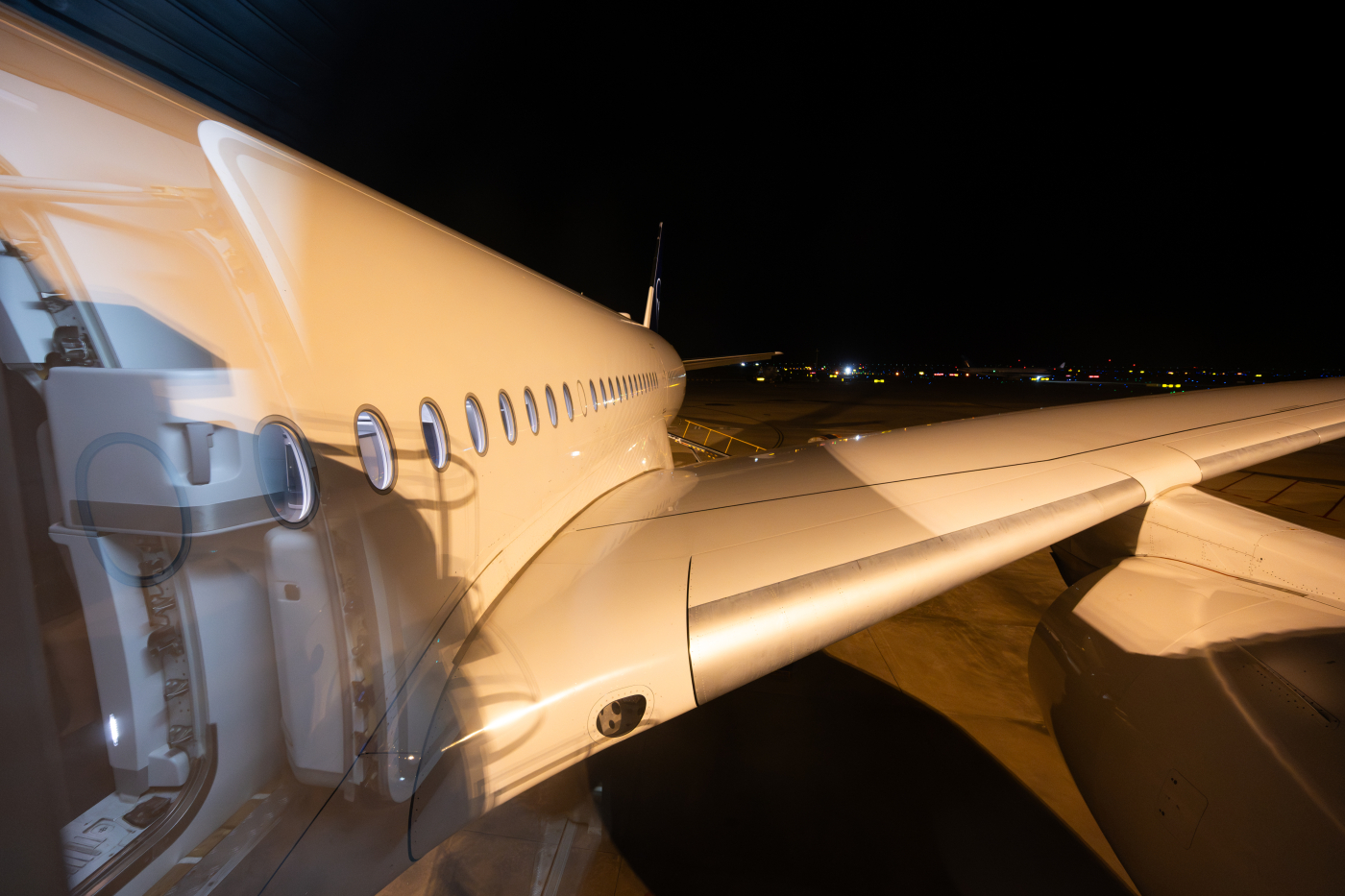
Welcome aboard the Allegris Business Class on this Airbus A350-900. For this flight, I was seated in the second Business Class cabin, slightly smaller than the first.

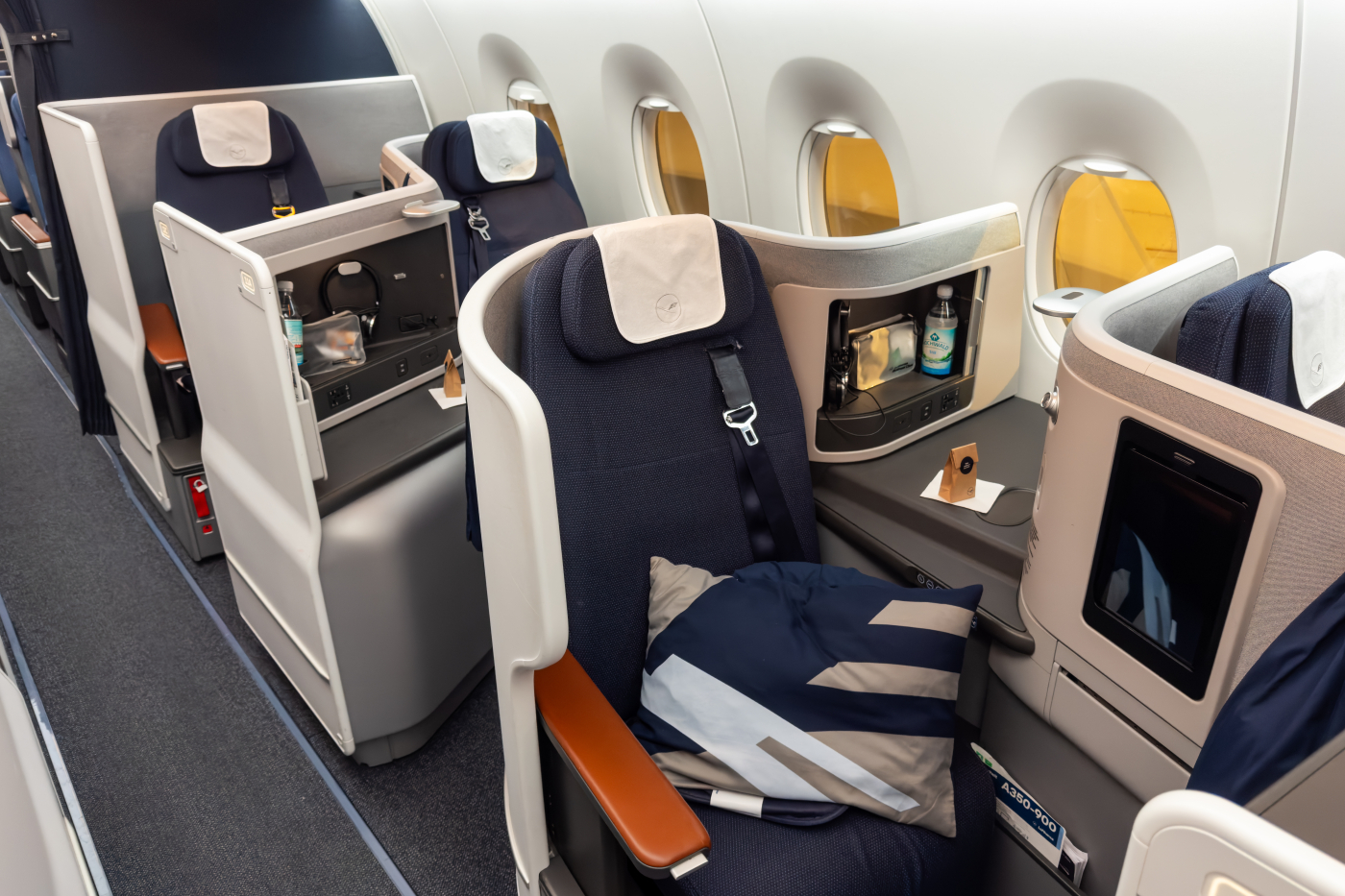
My seat for the flight was 8A, one of the aircraft's four Solo Suites.
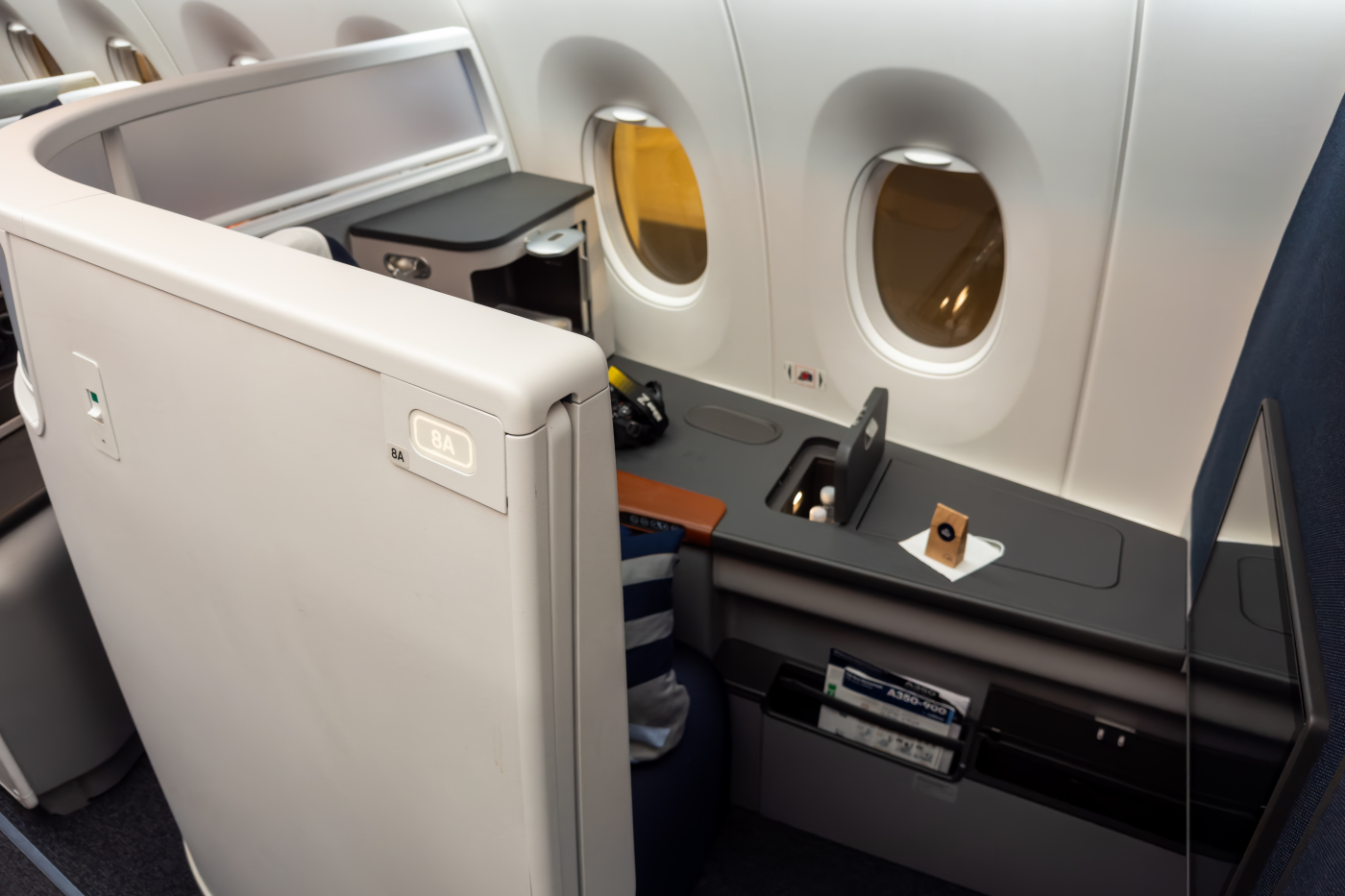
Upon arriving at my seat, the first impression was striking: generous space and remarkable privacy. The Suite's side panels, nearly 1.4 meters high, rise well above the industry standard, creating a cocoon almost entirely separated from the rest of the cabin. The Suite covers approximately 2.5 square meters of floor space and offers a comfortable seat about 53 cm wide.
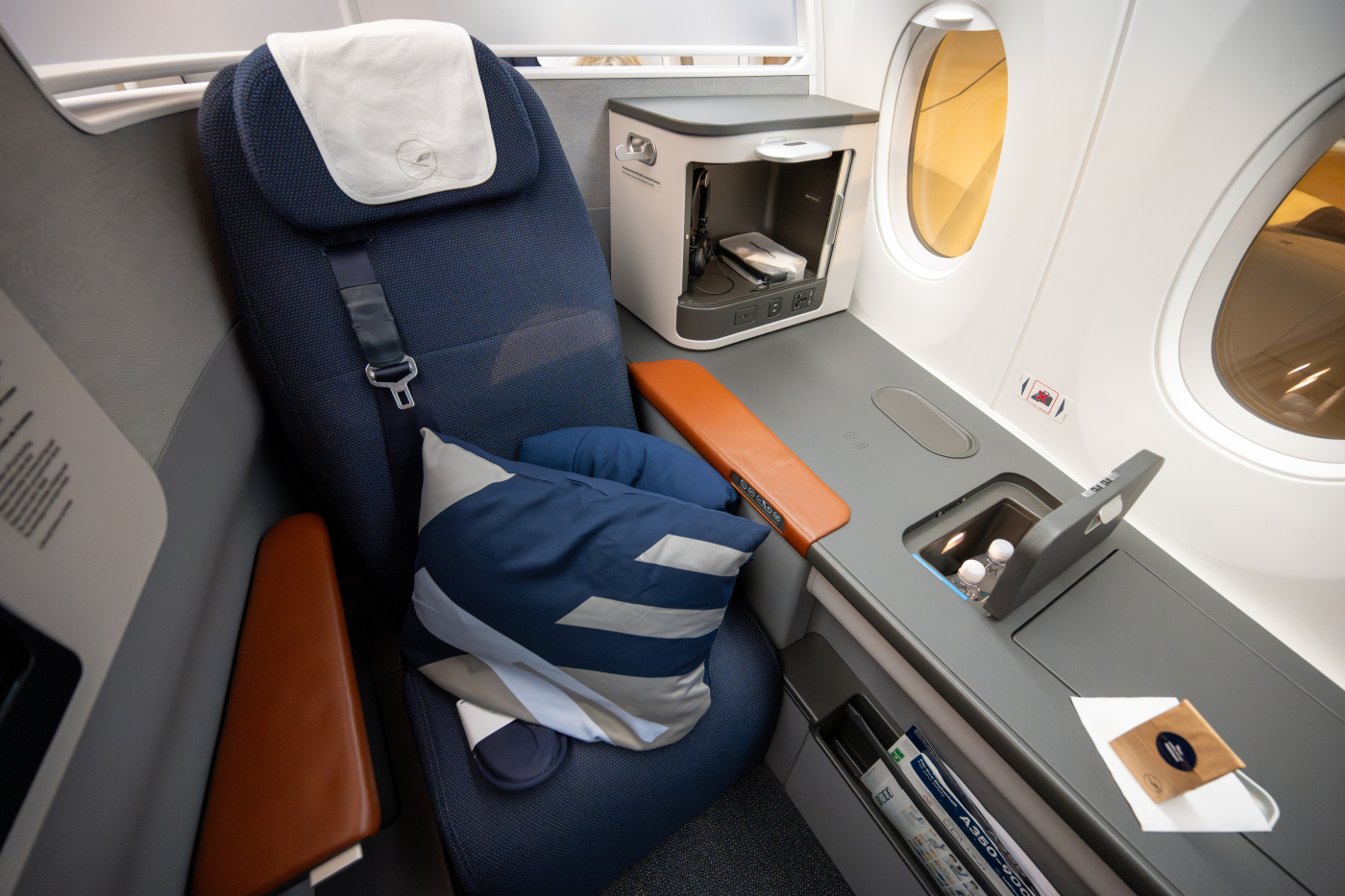
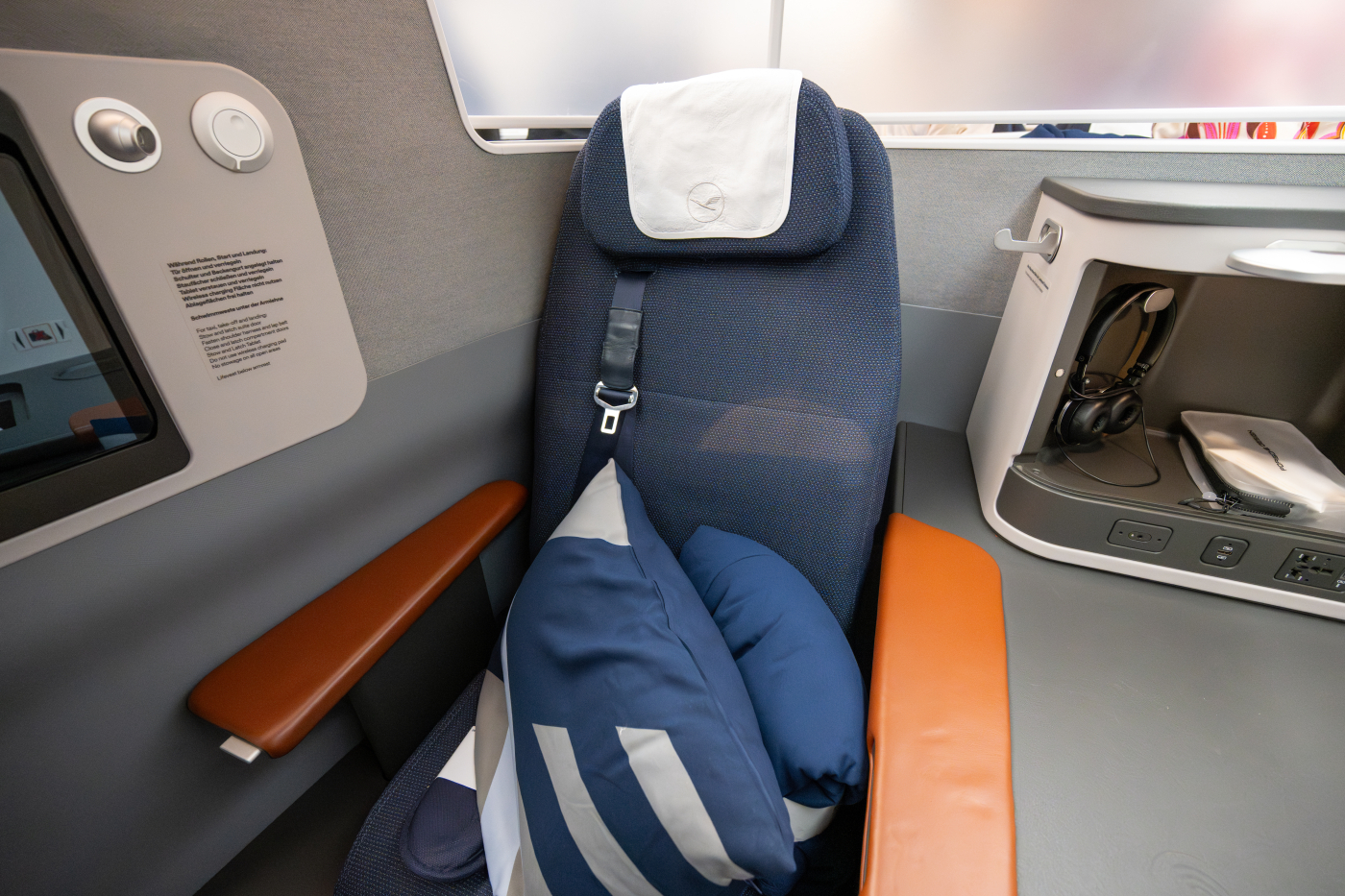
Being a window seat, this Suite benefits from a large side console.
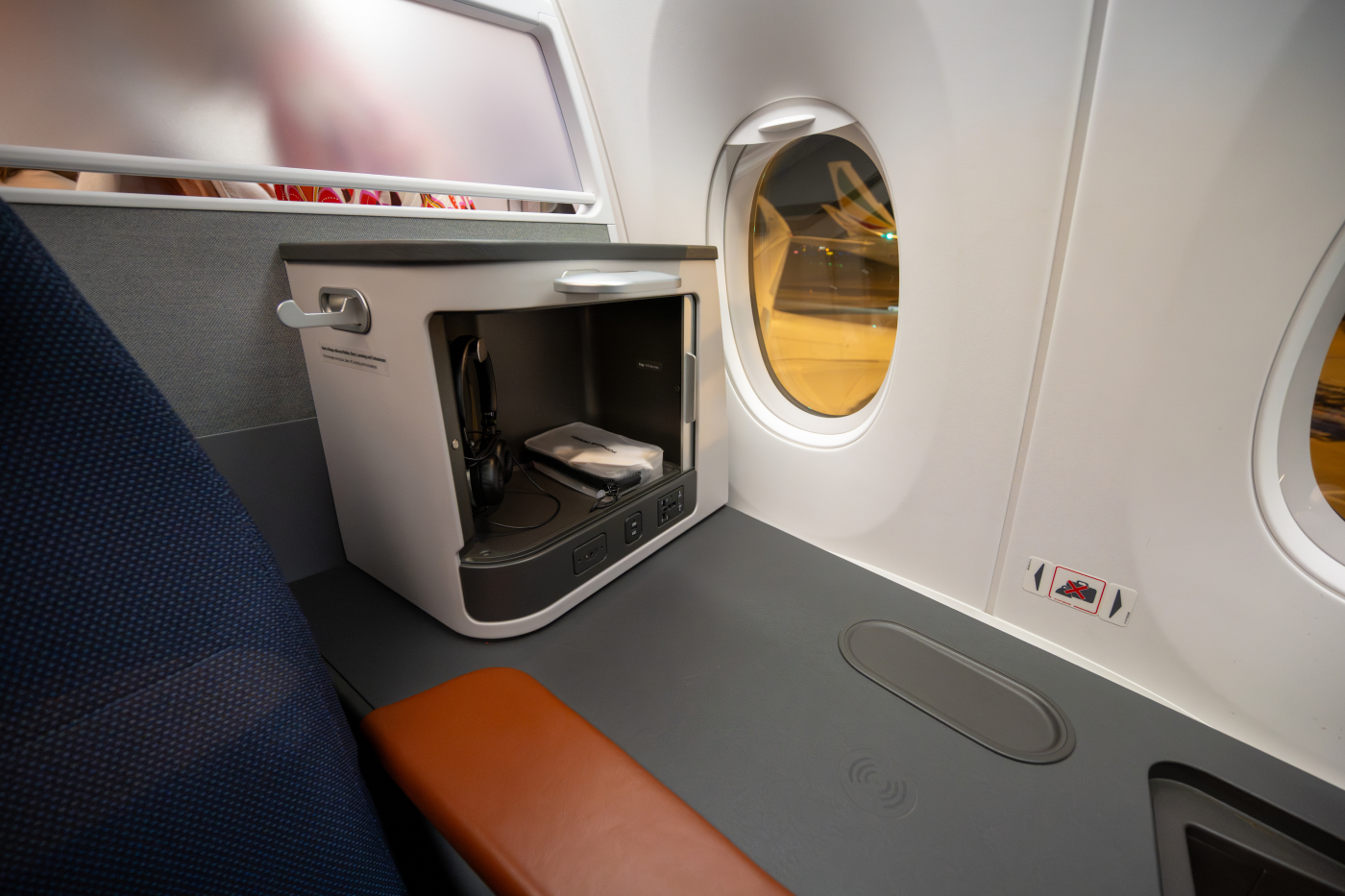
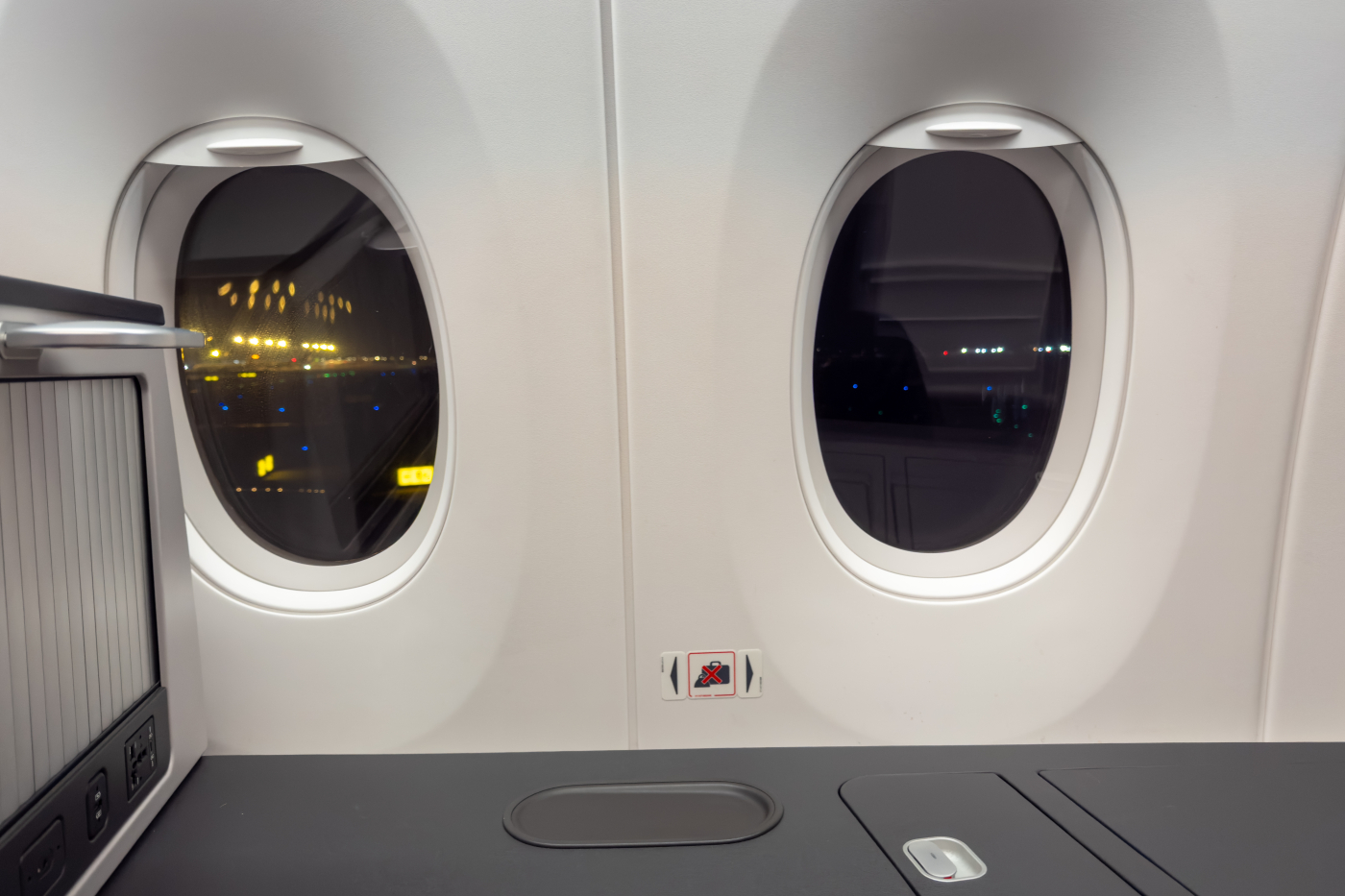
On the console, there is first a closable compartment, equipped with ambient lighting, which houses the headphones and an amenity kit.
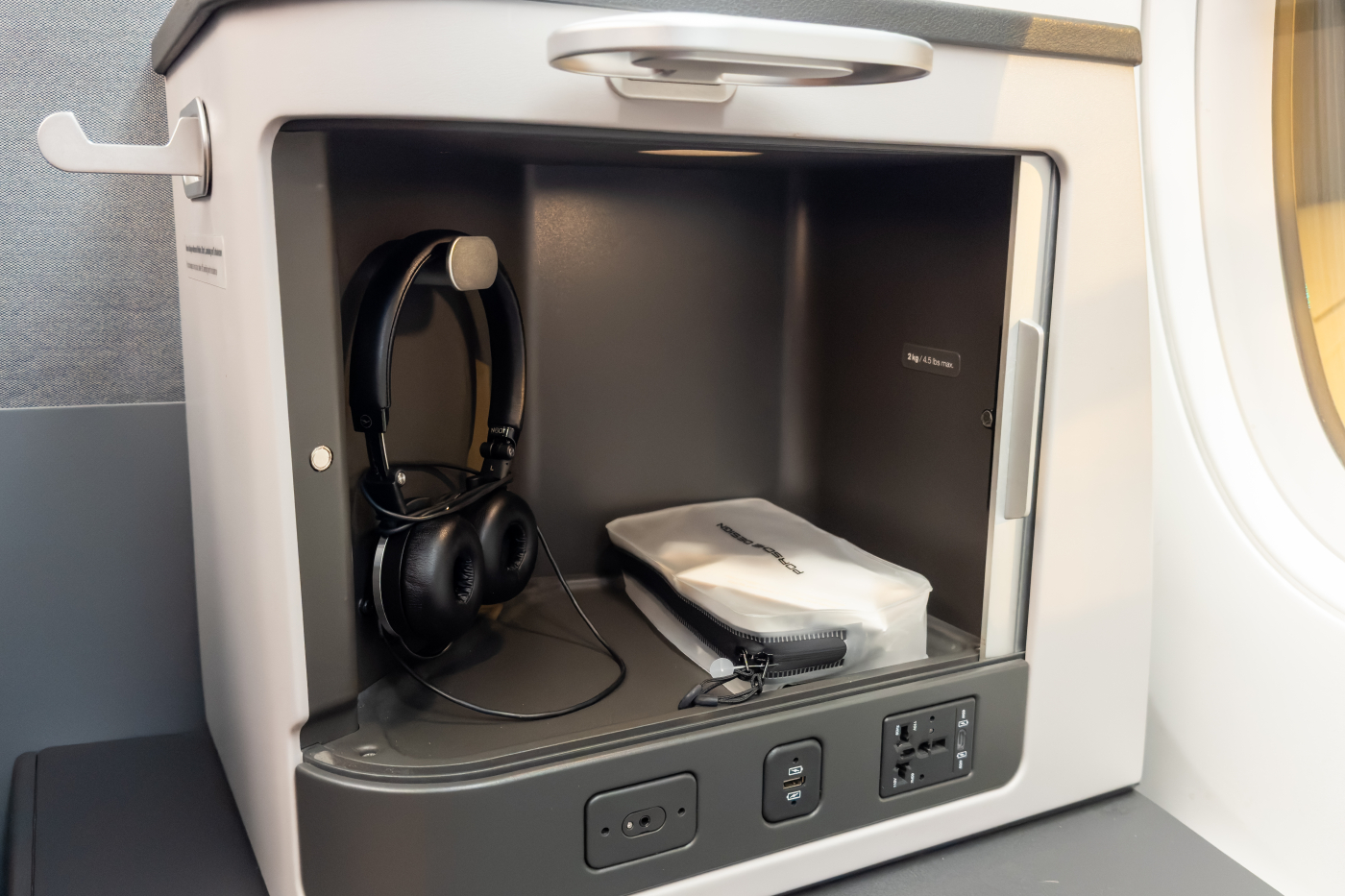

This module also consolidates all the essential connectivity: a universal power outlet, a USB-A port, a USB-C port with fast charging (60 W), and a headphone jack for connecting your own headset in addition to the one already integrated inside.
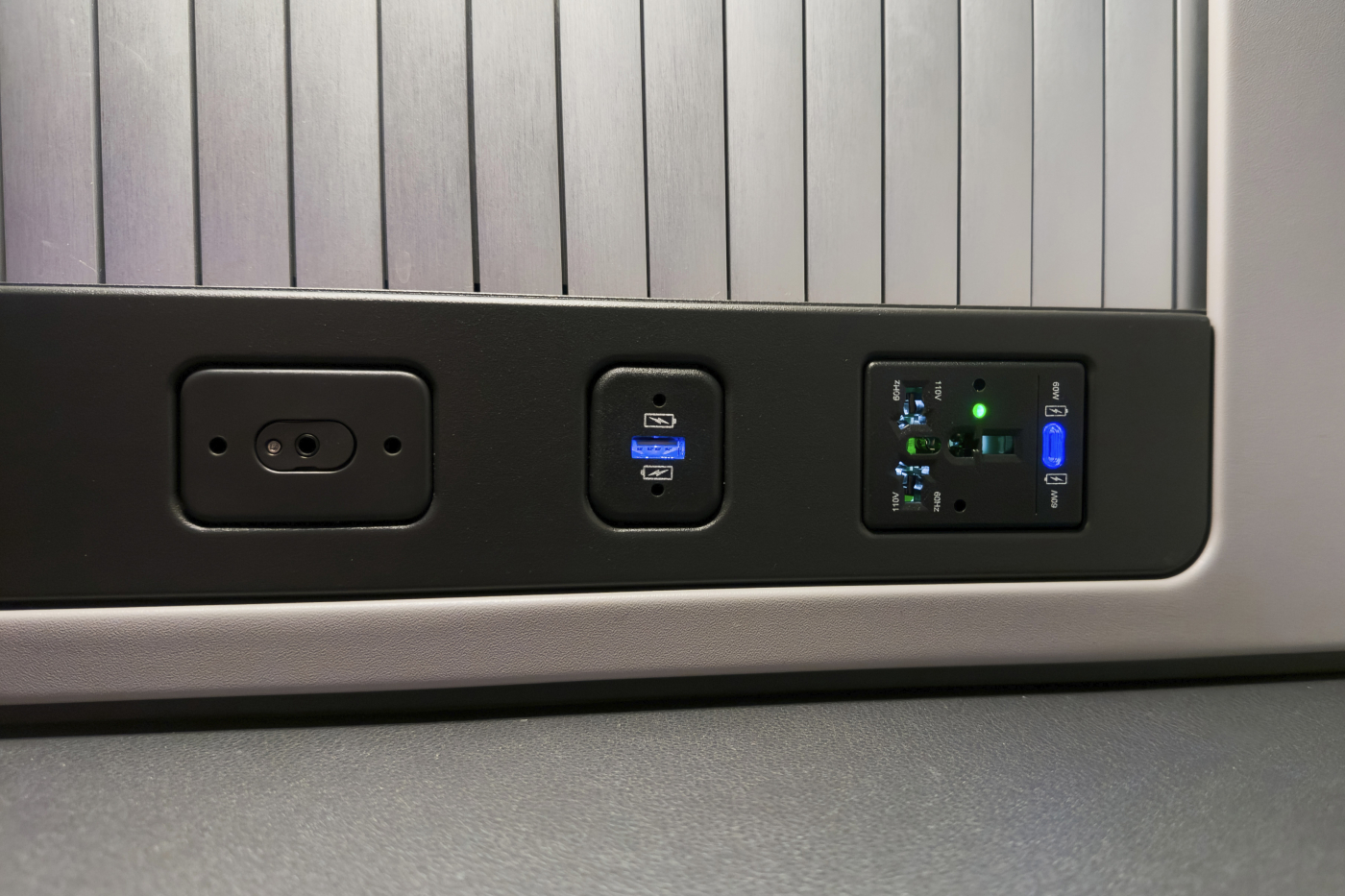
On the console's surface, a built-in wireless charger allows you to charge your smartphone, while a dedicated space provides a secure spot for a glass.
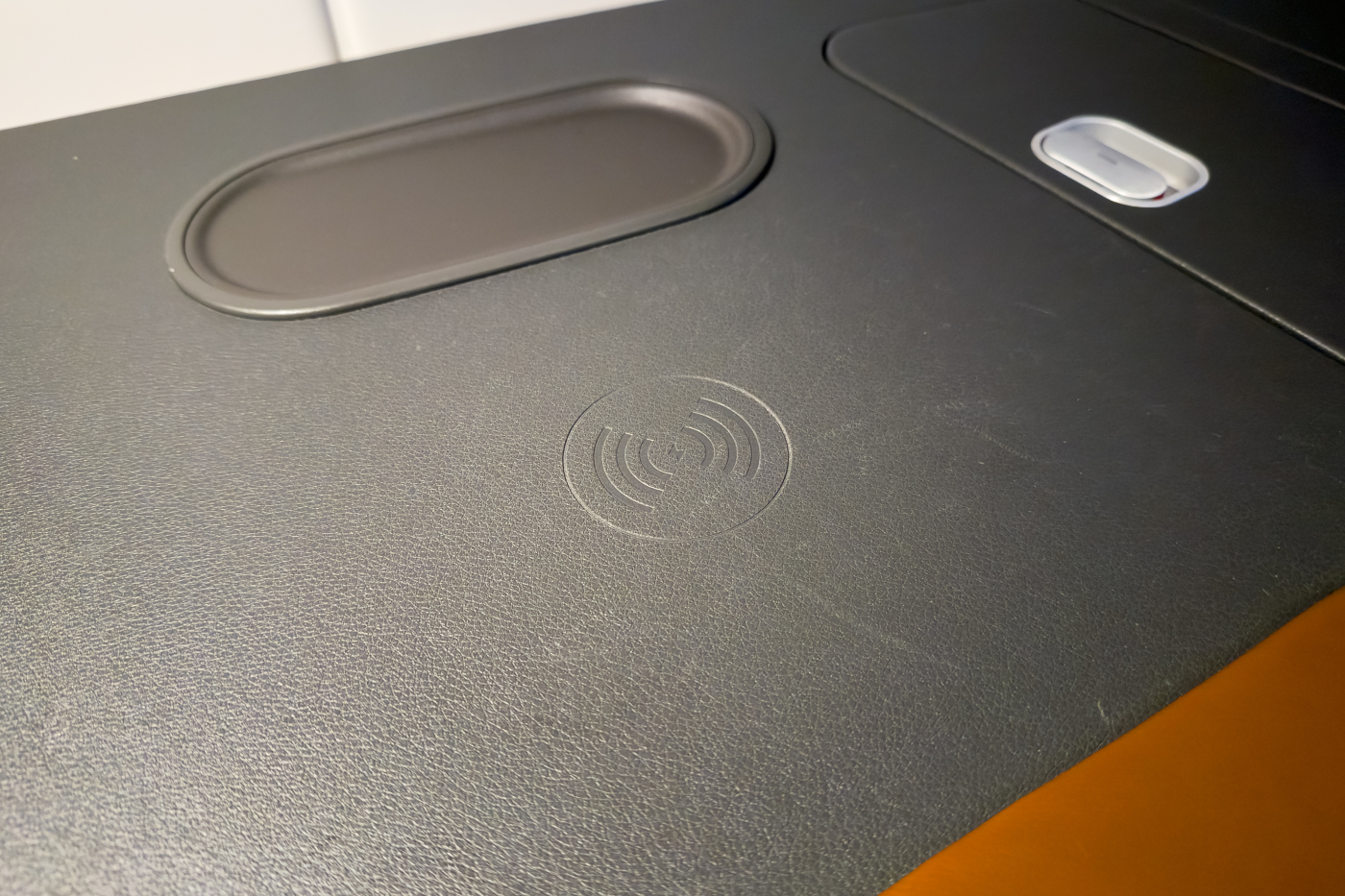

Two additional storage compartments complete the side area: one larger compartment easily accommodates personal items, while the other serves as a mini-bar, stocked with two small bottles of water.
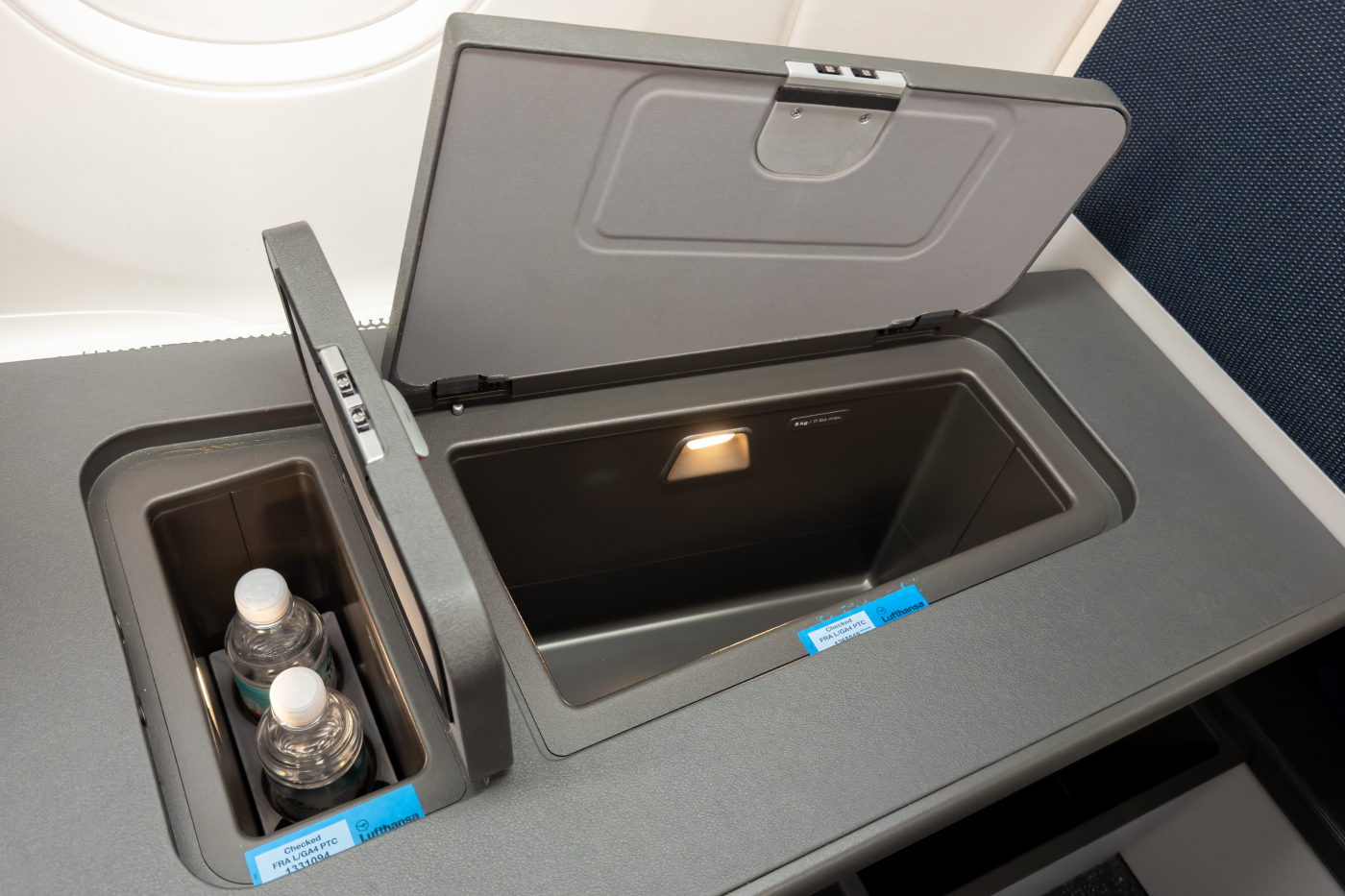

Facing the seat is the main entertainment screen: a massive 24-inch 4K display offering excellent brightness and good responsiveness.
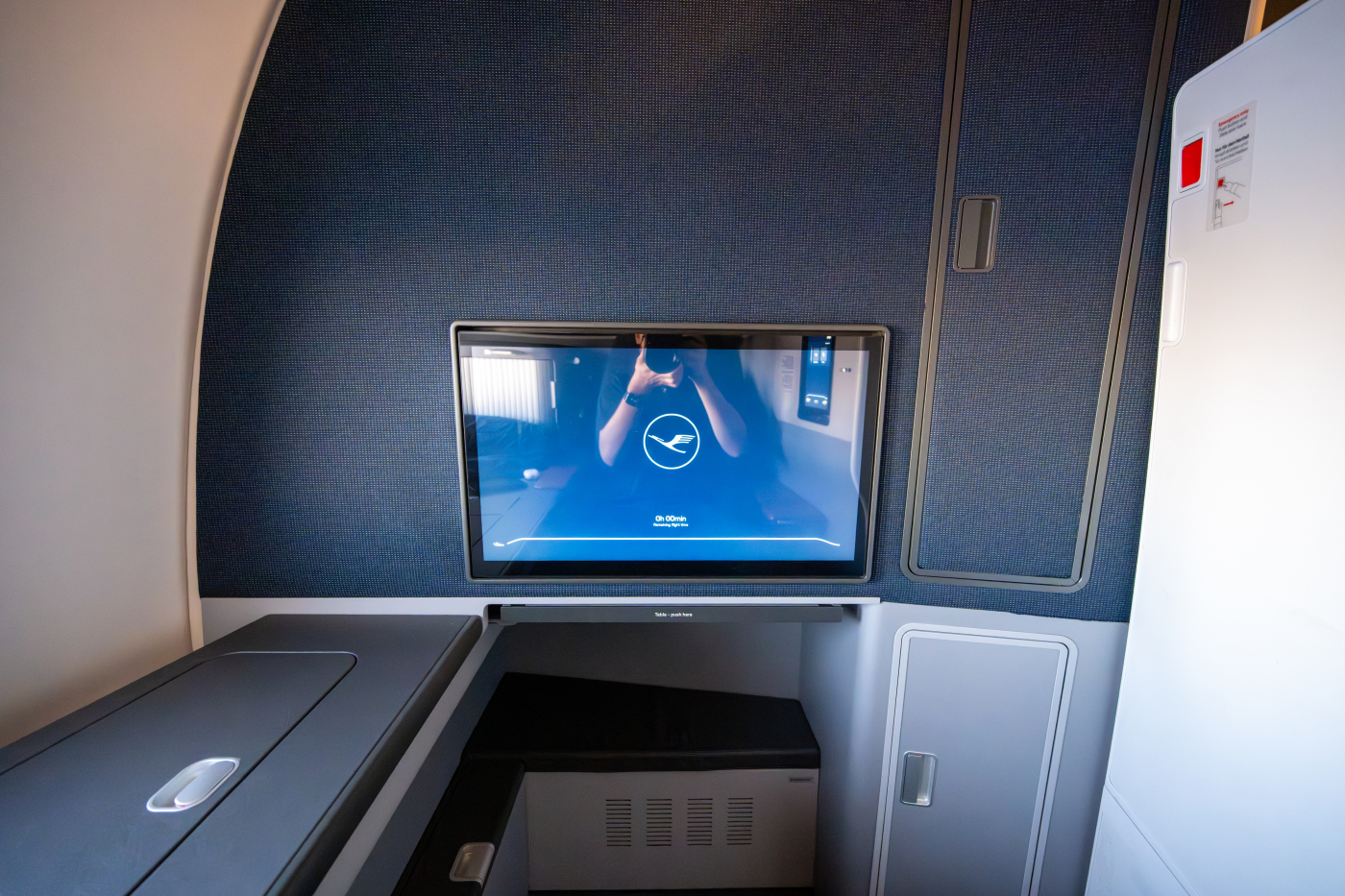
Just below, the table is neatly stowed when not in use. It slides out from beneath the screen toward the seat and unfolds to form a comfortably sized surface, while also being able to slide back partially to free aisle access without fully stowing it.
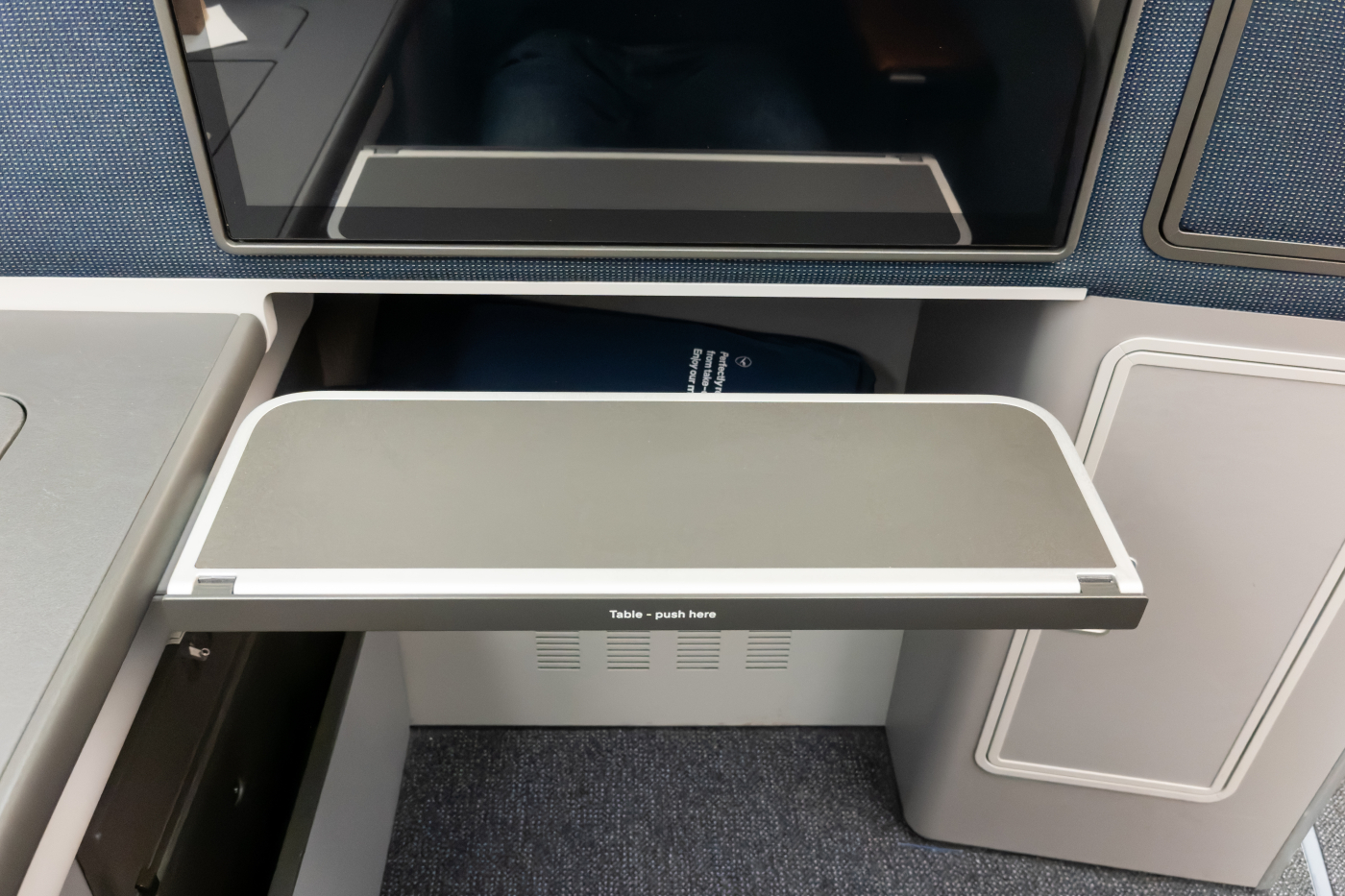

Under the table, a footrest and additional storage space are integrated.
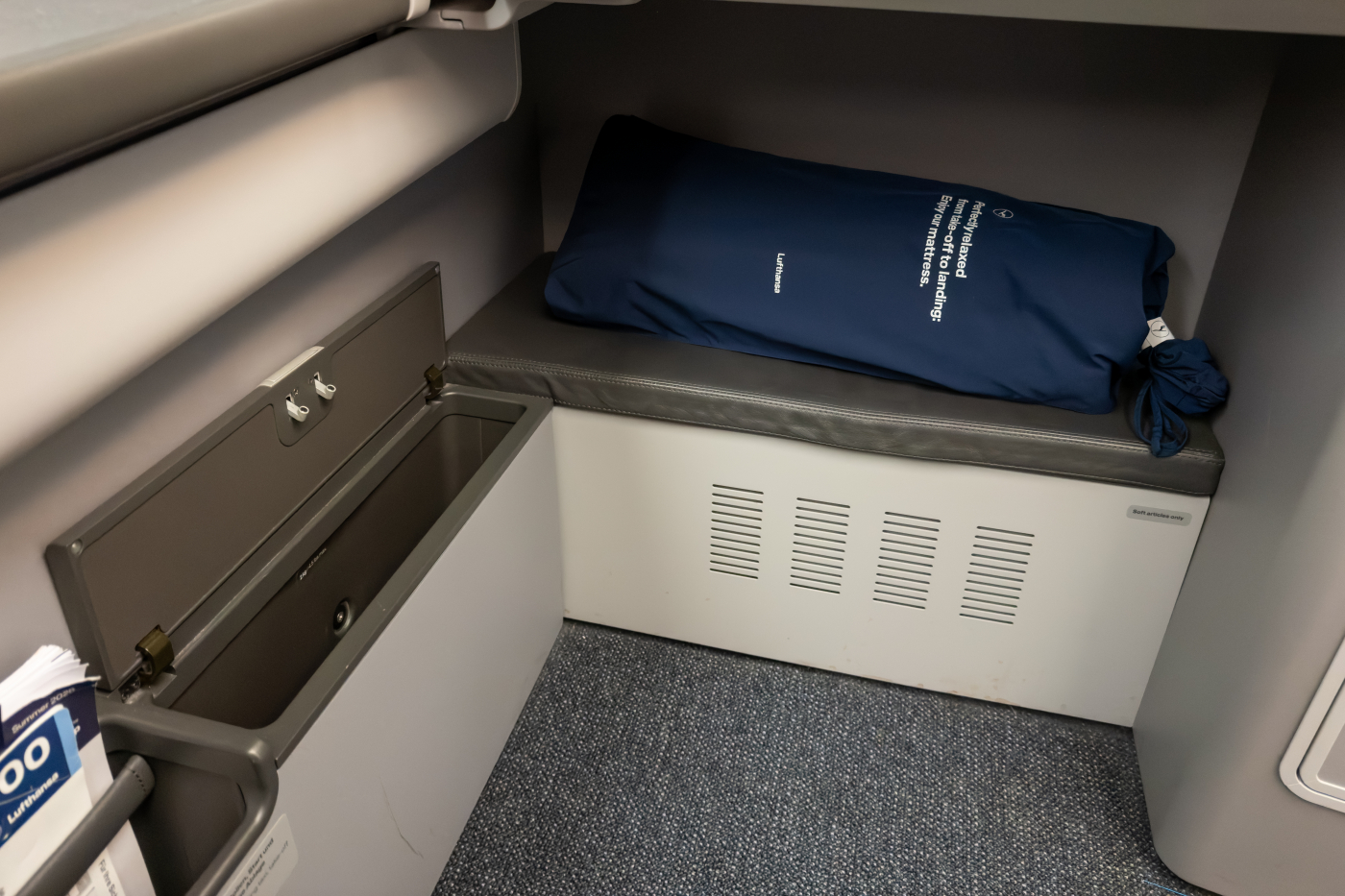
There is also a magazine holder, containing two safety cards – one for the aircraft, the other specific to the Suite's emergency door – as well as the onboard sales catalog.
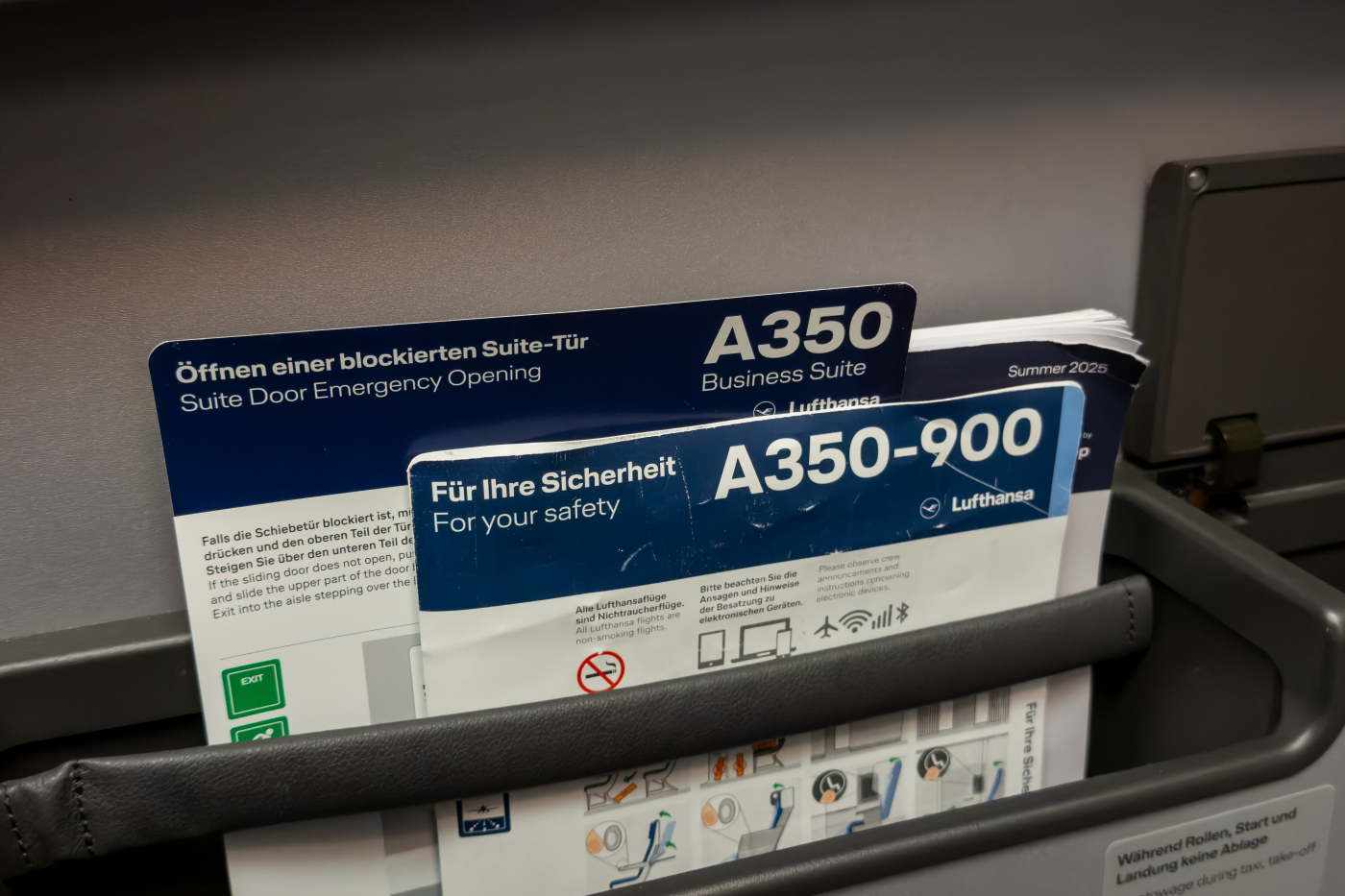
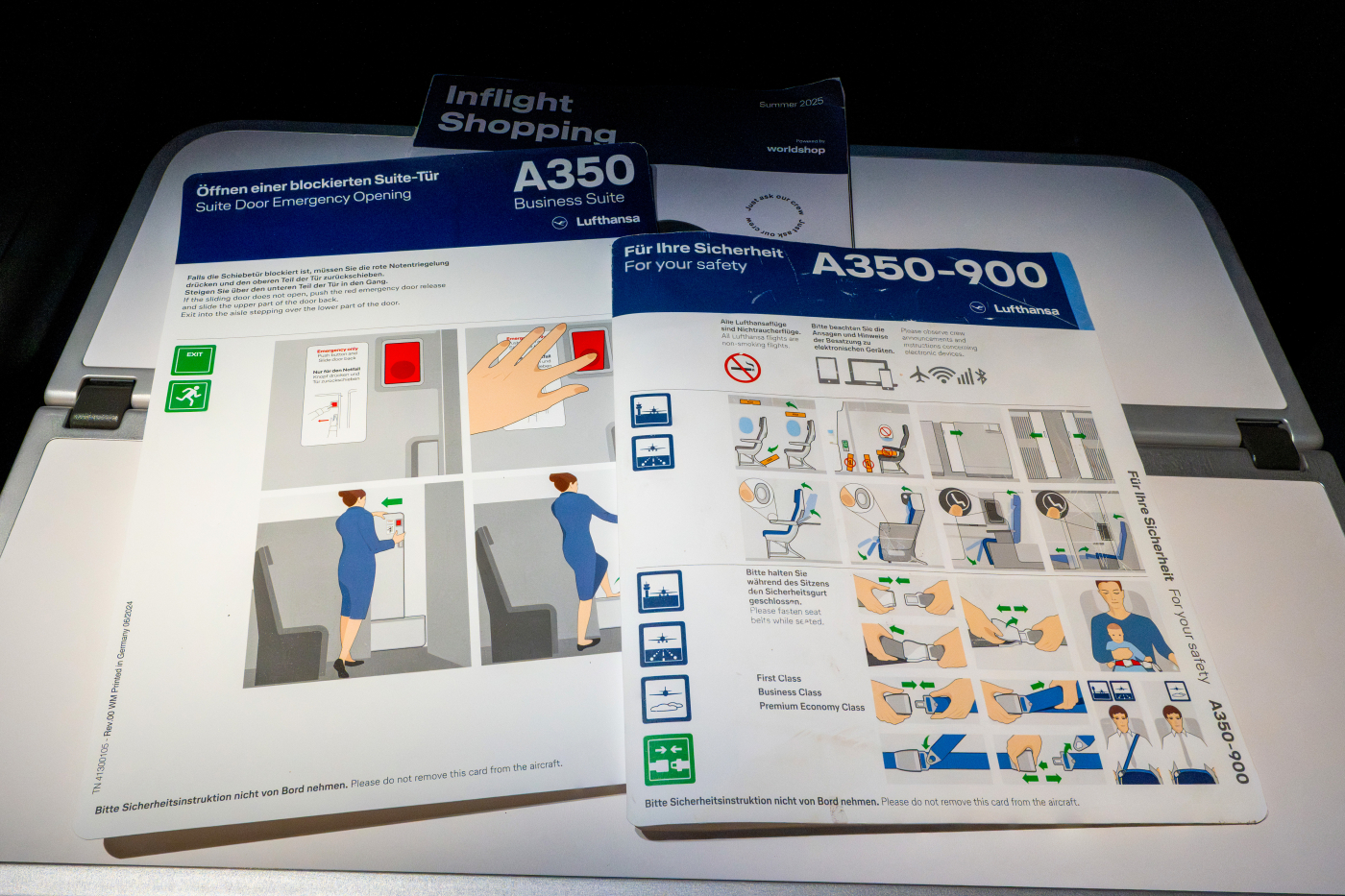
To the right of the screen, a small vertical wardrobe, equipped with a full-height mirror and a hanger, allows a jacket or garment to be hung.
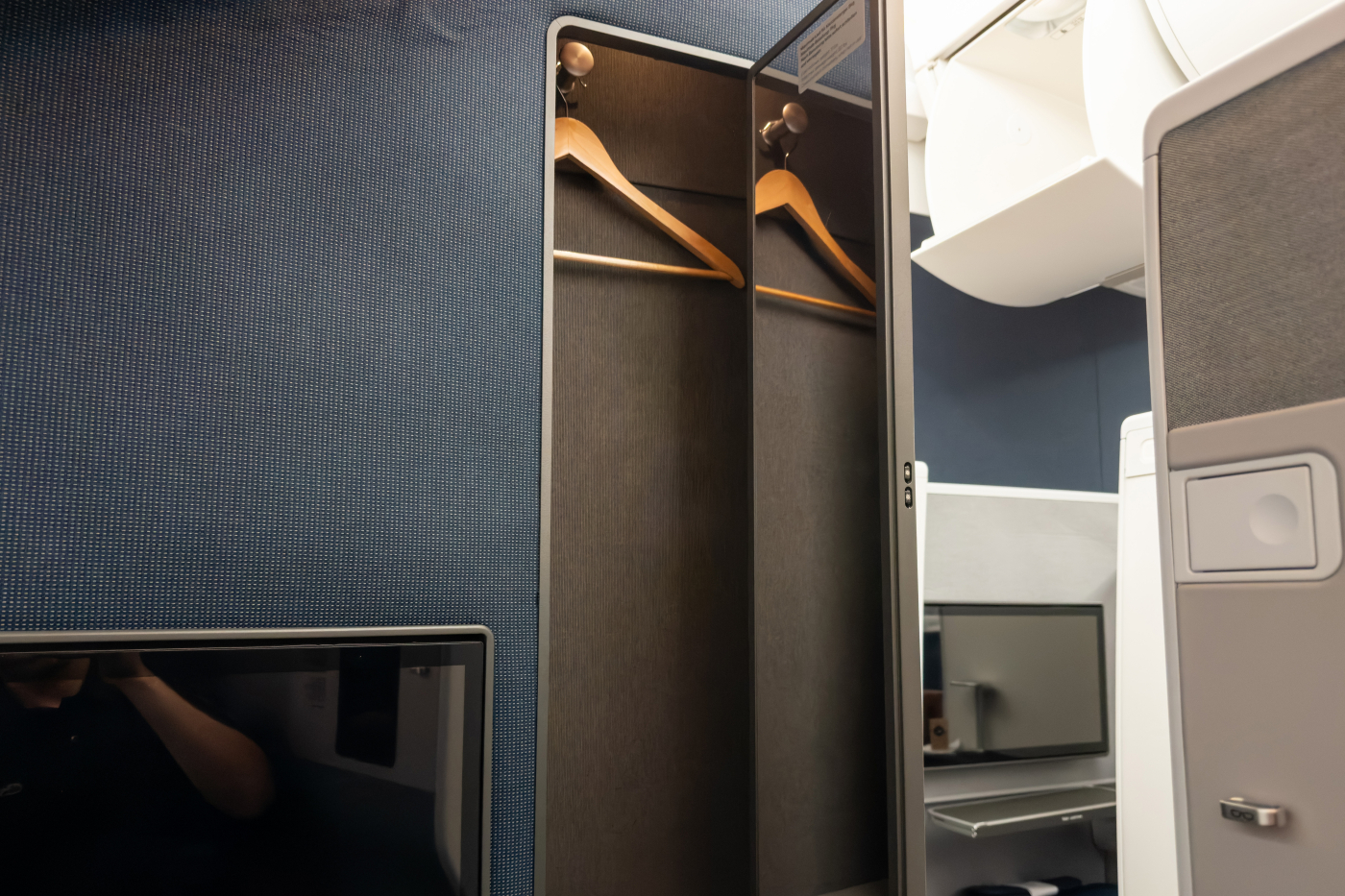
Below it, a larger compartment can accommodate a bag.
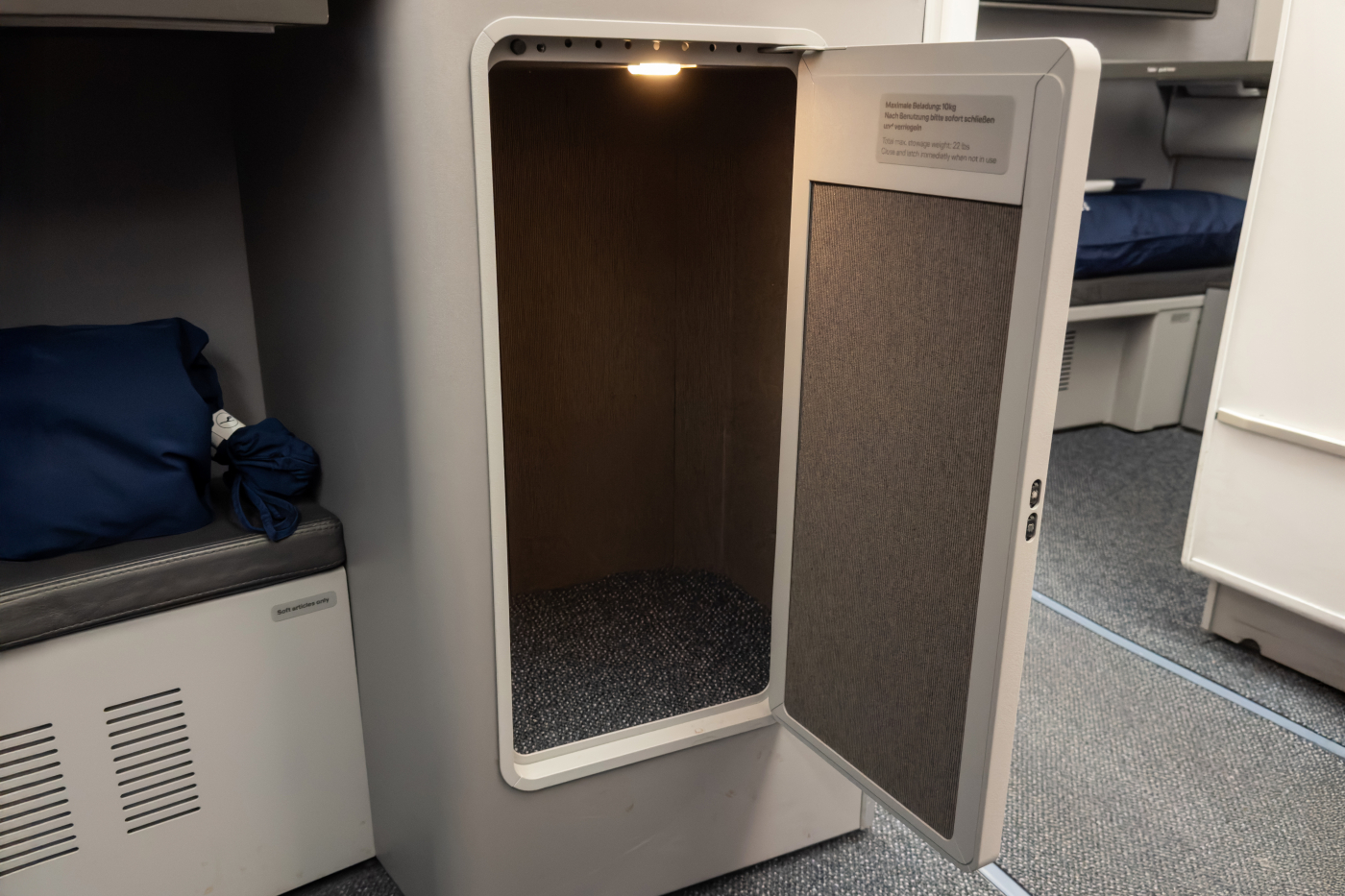
On the right side of the seat, a multifunction touchscreen – the Control Panel – consolidates the controls for the screen, the seat, and various lighting options. It also includes a glasses holder, an individual air vent, and an adjustable reading light.
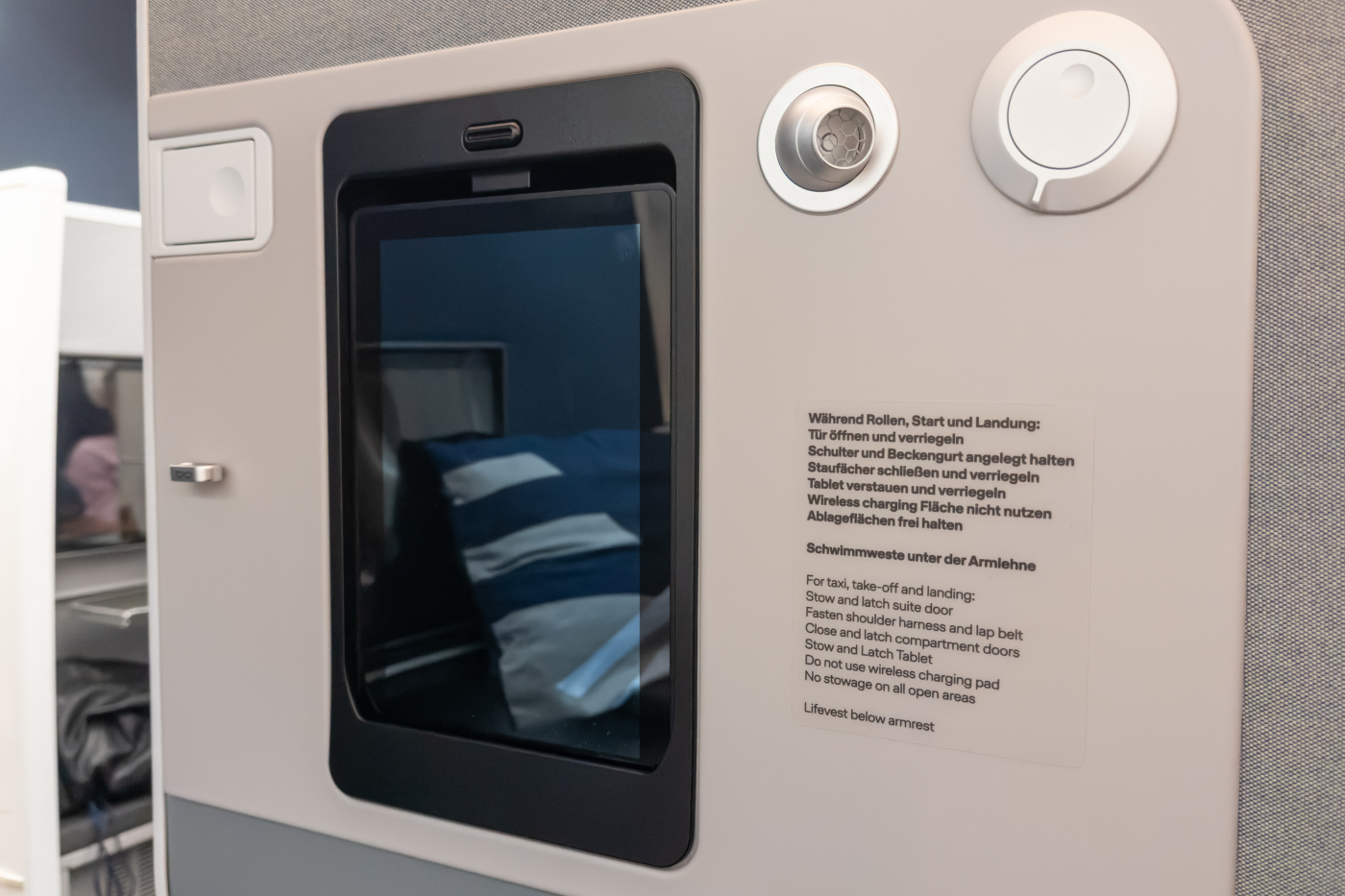
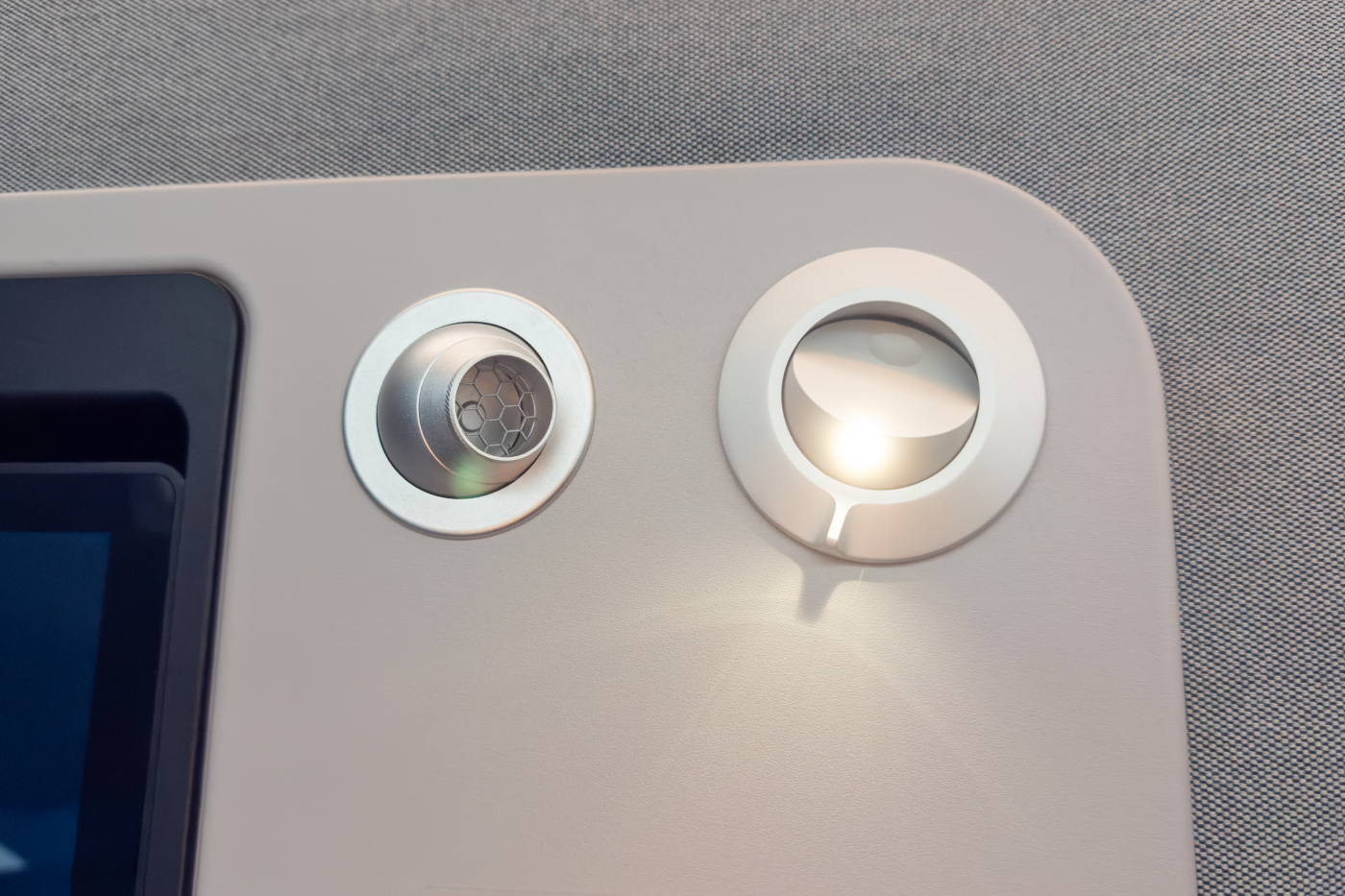
Below it, the armrest is height-adjustable and can be fully lowered.
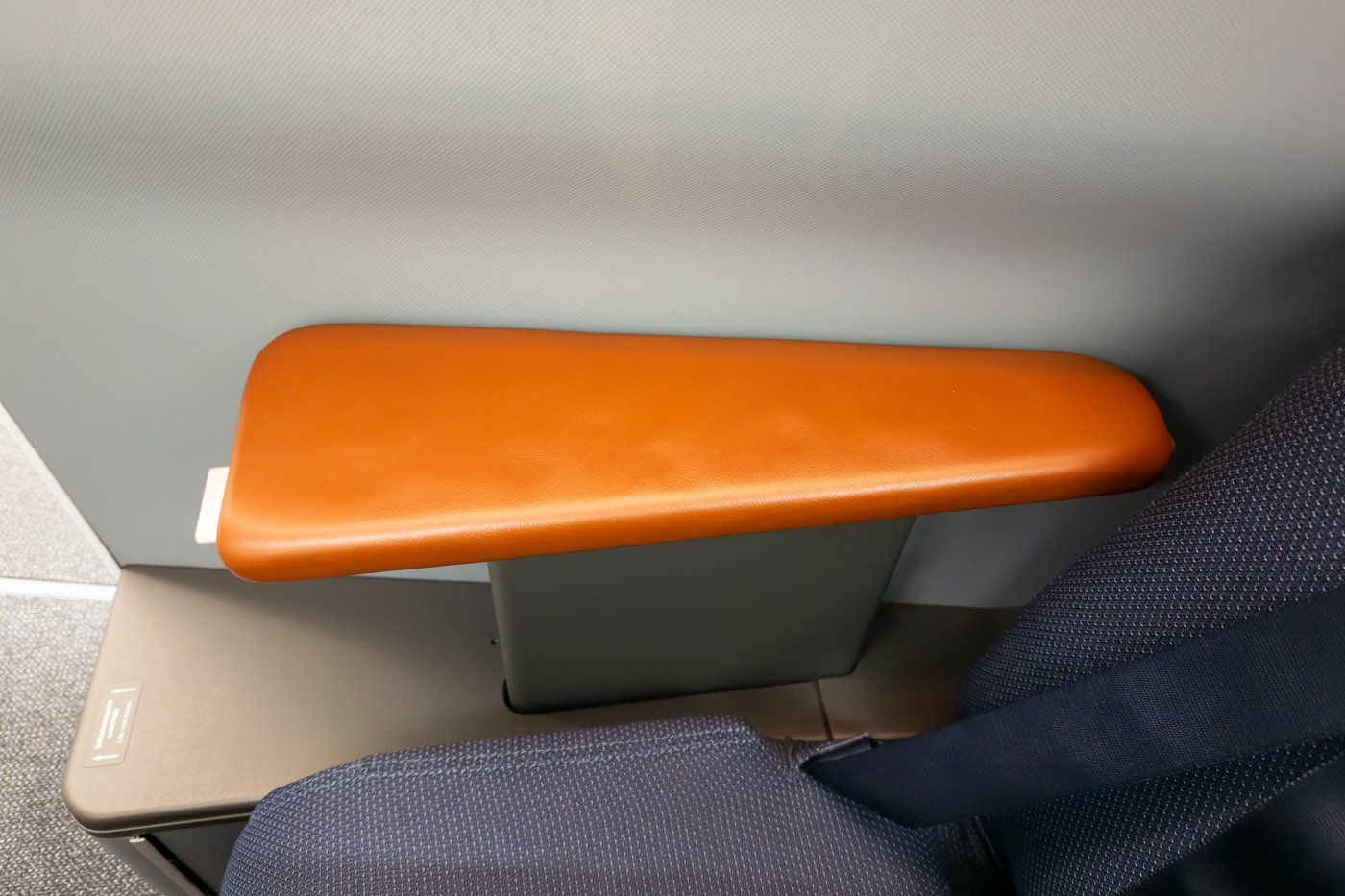
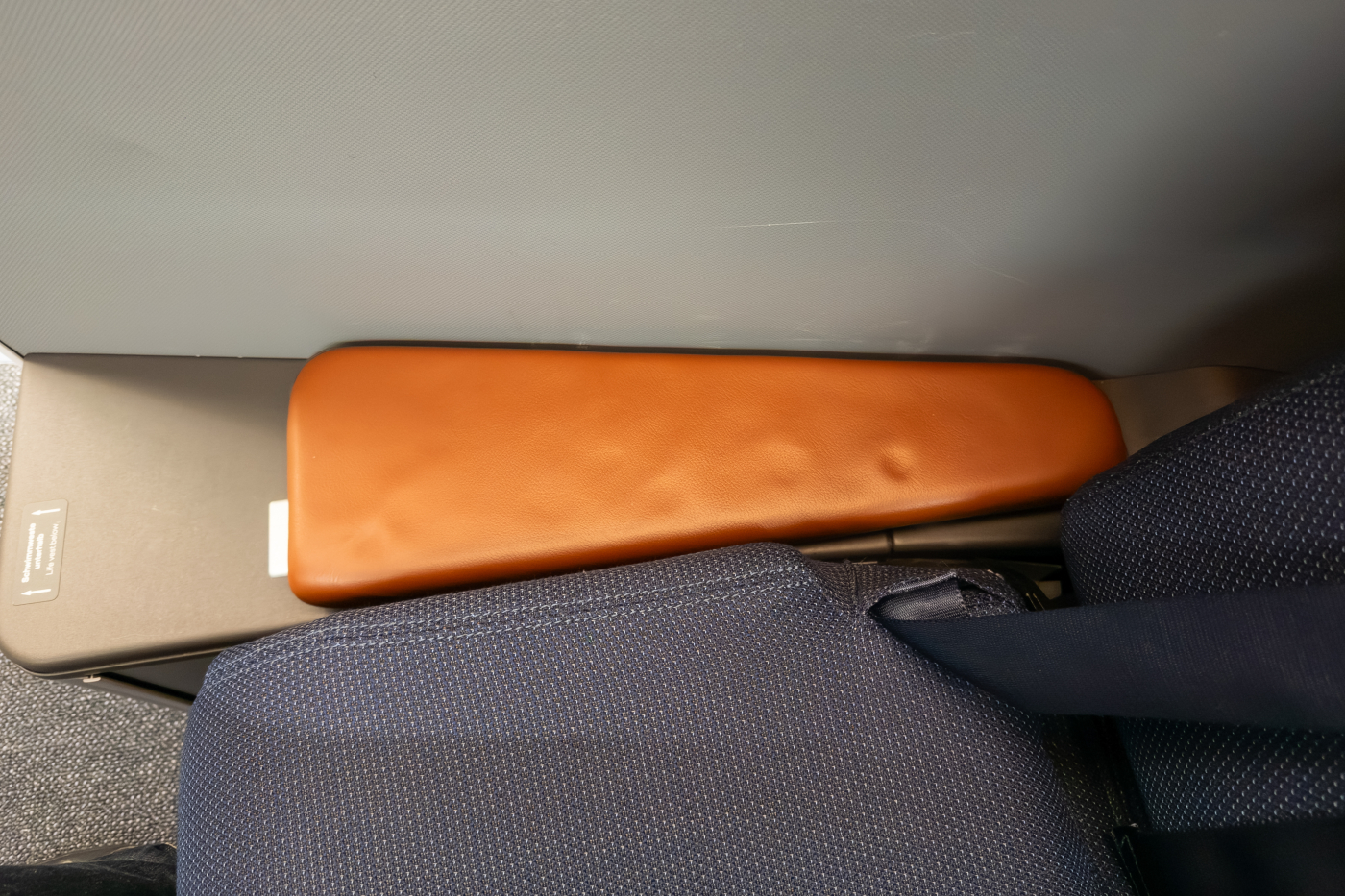
On the left side of the seat, quick-access controls allow adjustment of seat recline and firmness, complementing the options available on the Control Panel.
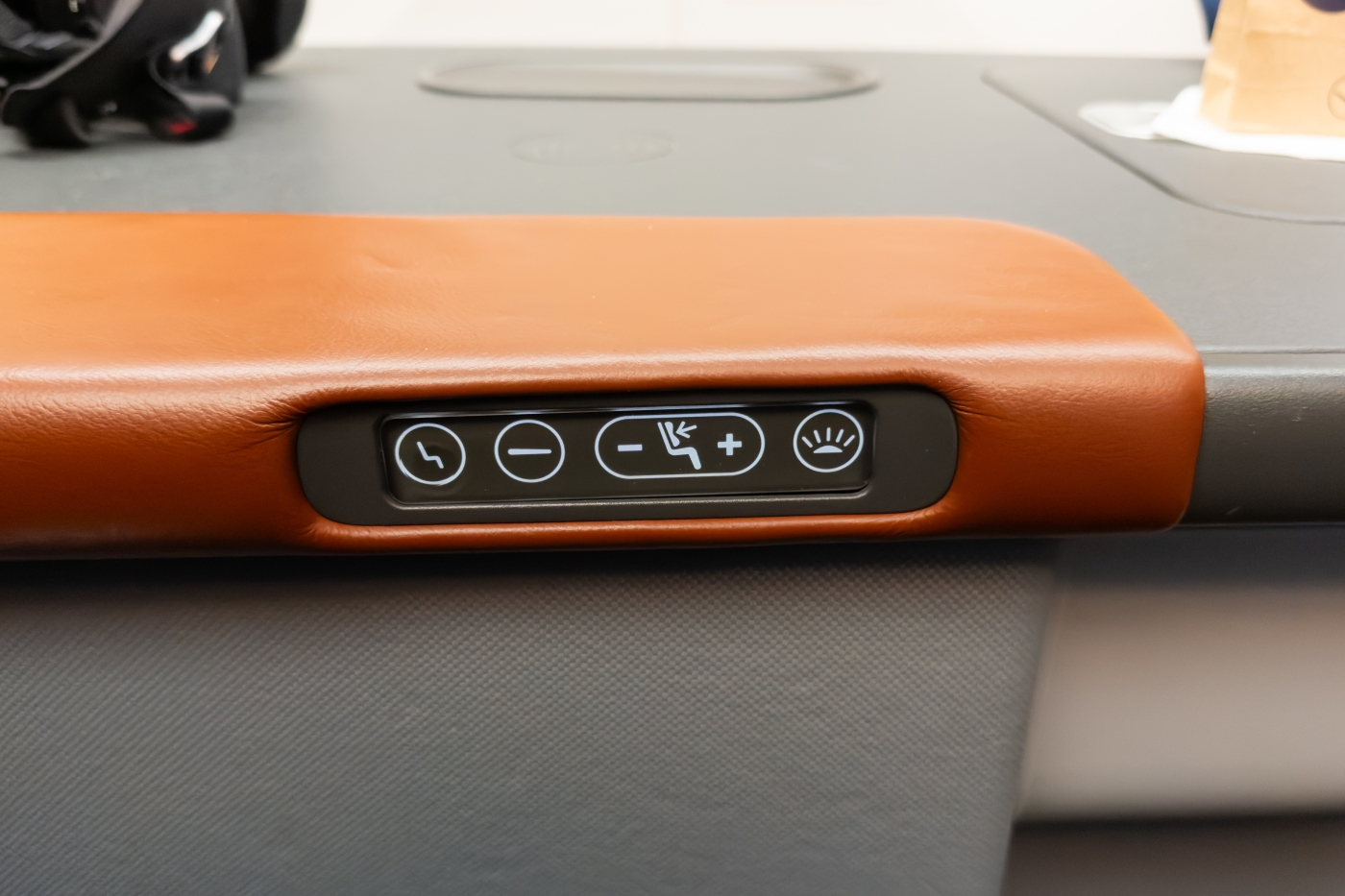
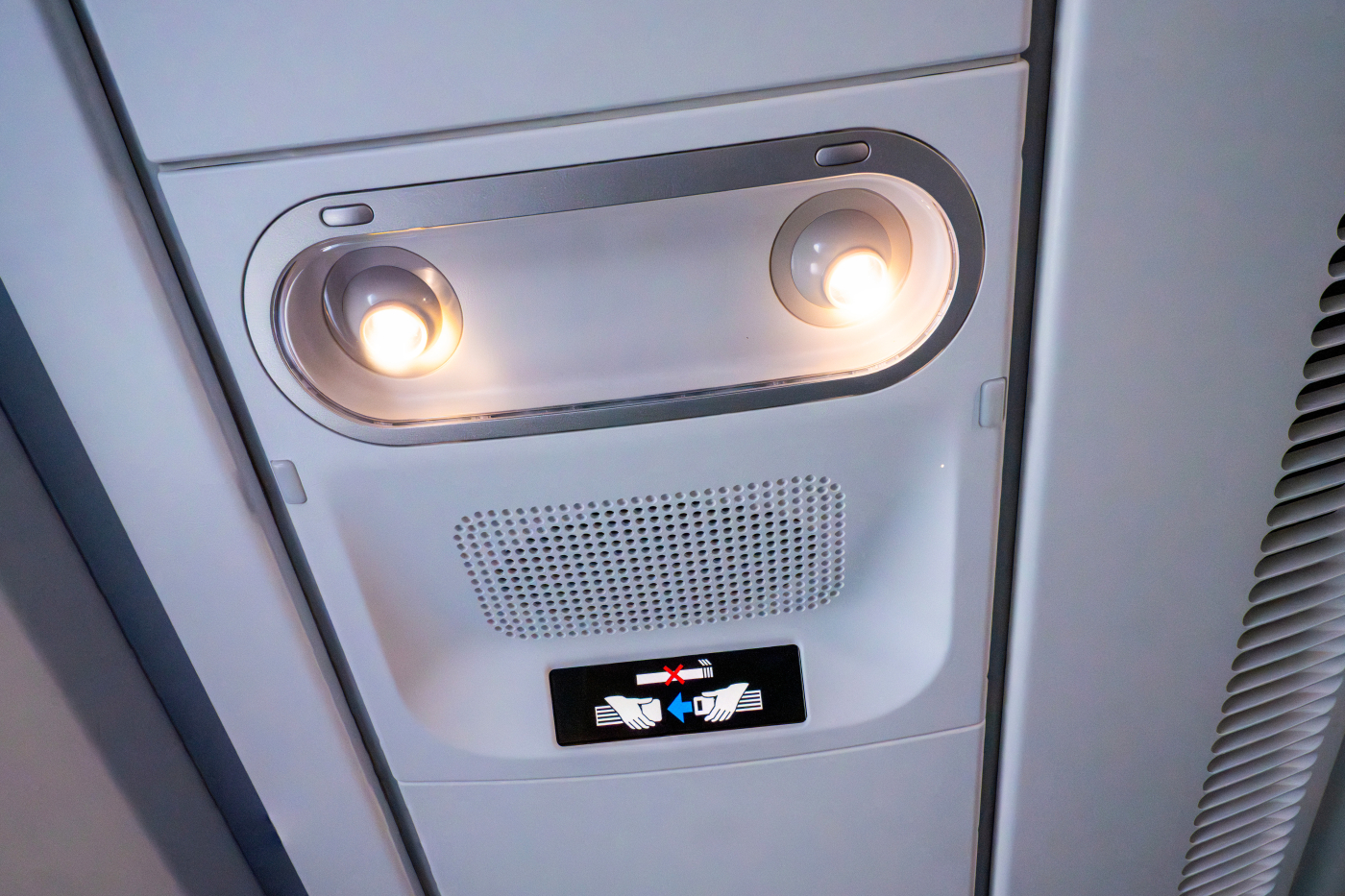
But the true highlight of this Suite – as its name suggests – is the sliding door, which allows complete isolation from the rest of the cabin. When closed, it transforms the space into a personal cocoon, comparable to some First-Class experiences. The only drawback: the mechanism lacks firmness, and the door tends to slightly open during turbulence or abrupt movements.
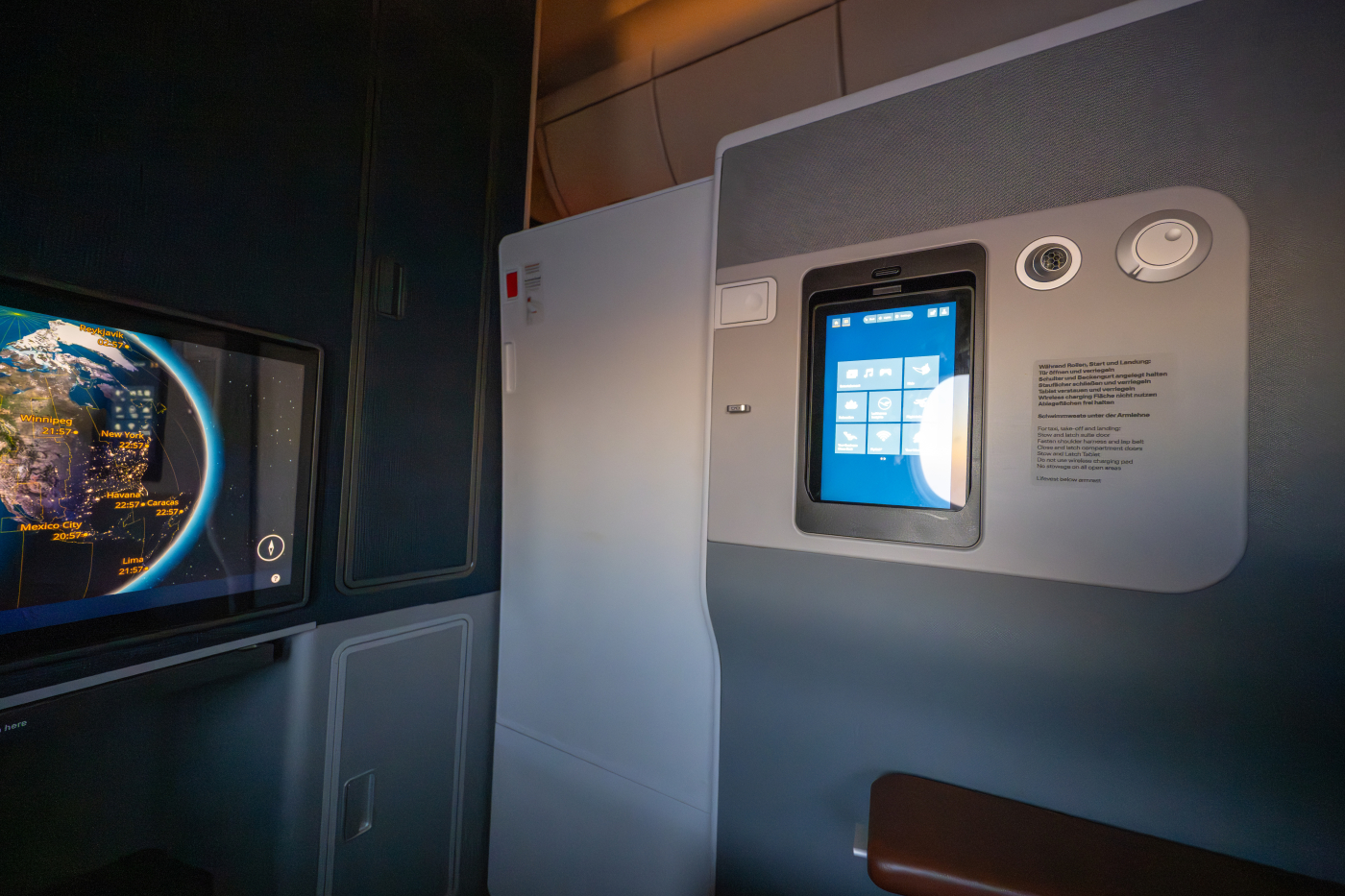
When it comes to sleeping, the seat fully reclines into a flat bed, offering a two-meter-long sleeping surface. With the provided mattress topper, it delivers reasonable comfort for a long-haul flight.
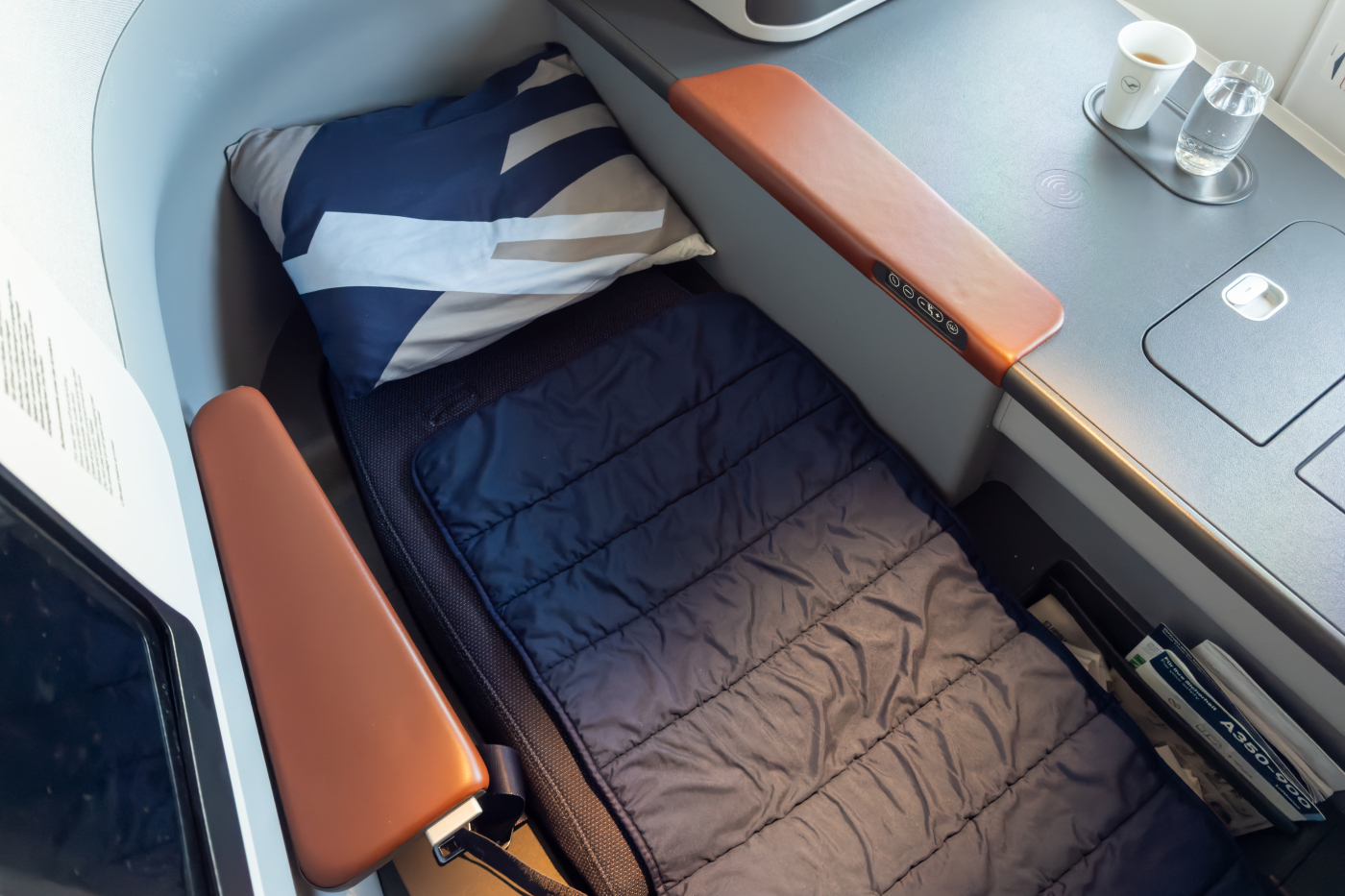

Upon taking their seat, each passenger finds a soft pillow, a thick duvet, a pair of slippers, and a mattress topper designed to enhance comfort when lying down.
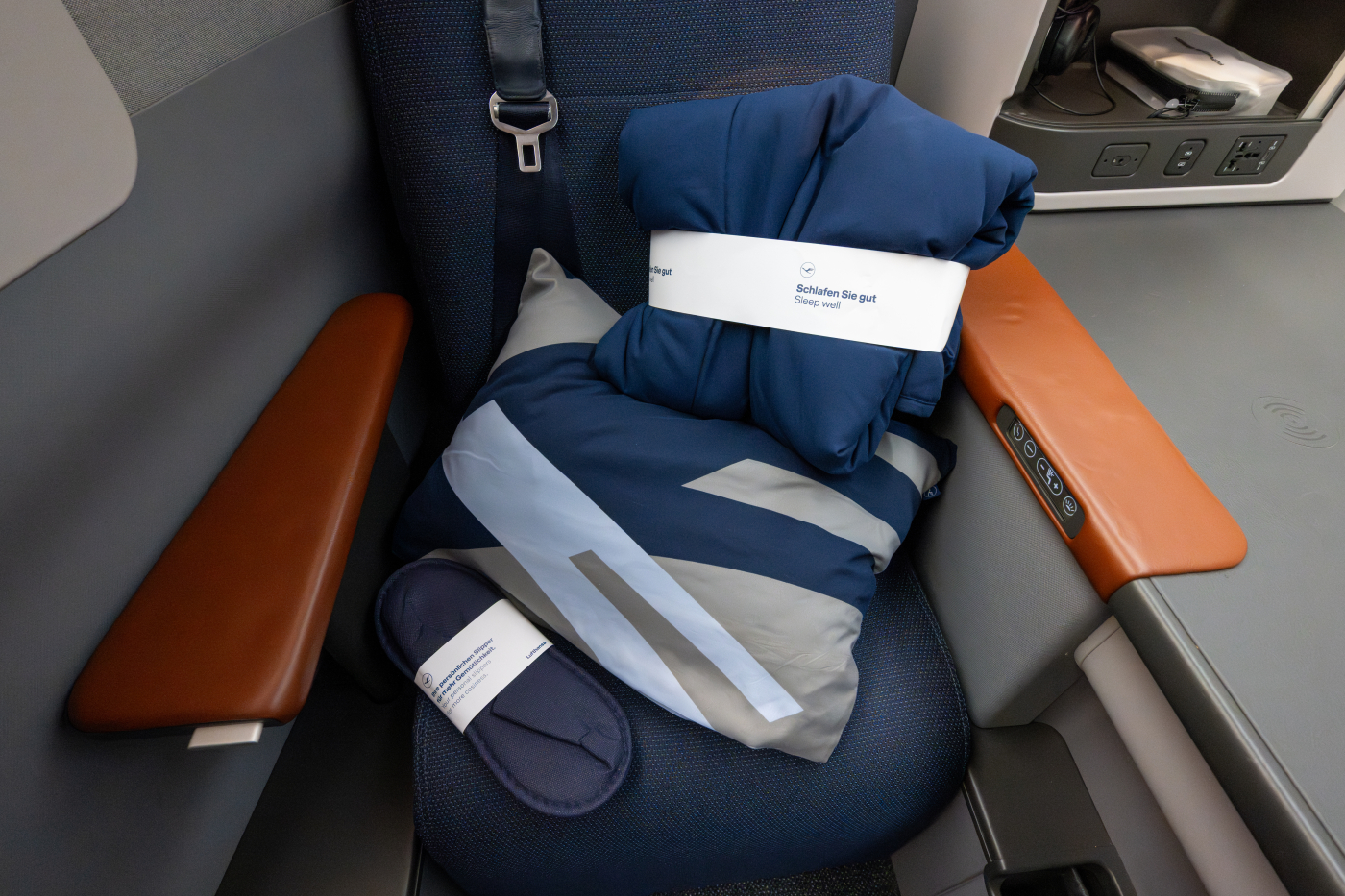
A Porsche Design amenity kit is also provided at every seat. It contains all the essentials for a long-haul flight: socks, an eye mask, a toothbrush and toothpaste, earplugs, a headset cover, a mint, as well as L'Occitane skincare products – a hand cream and a lip balm.


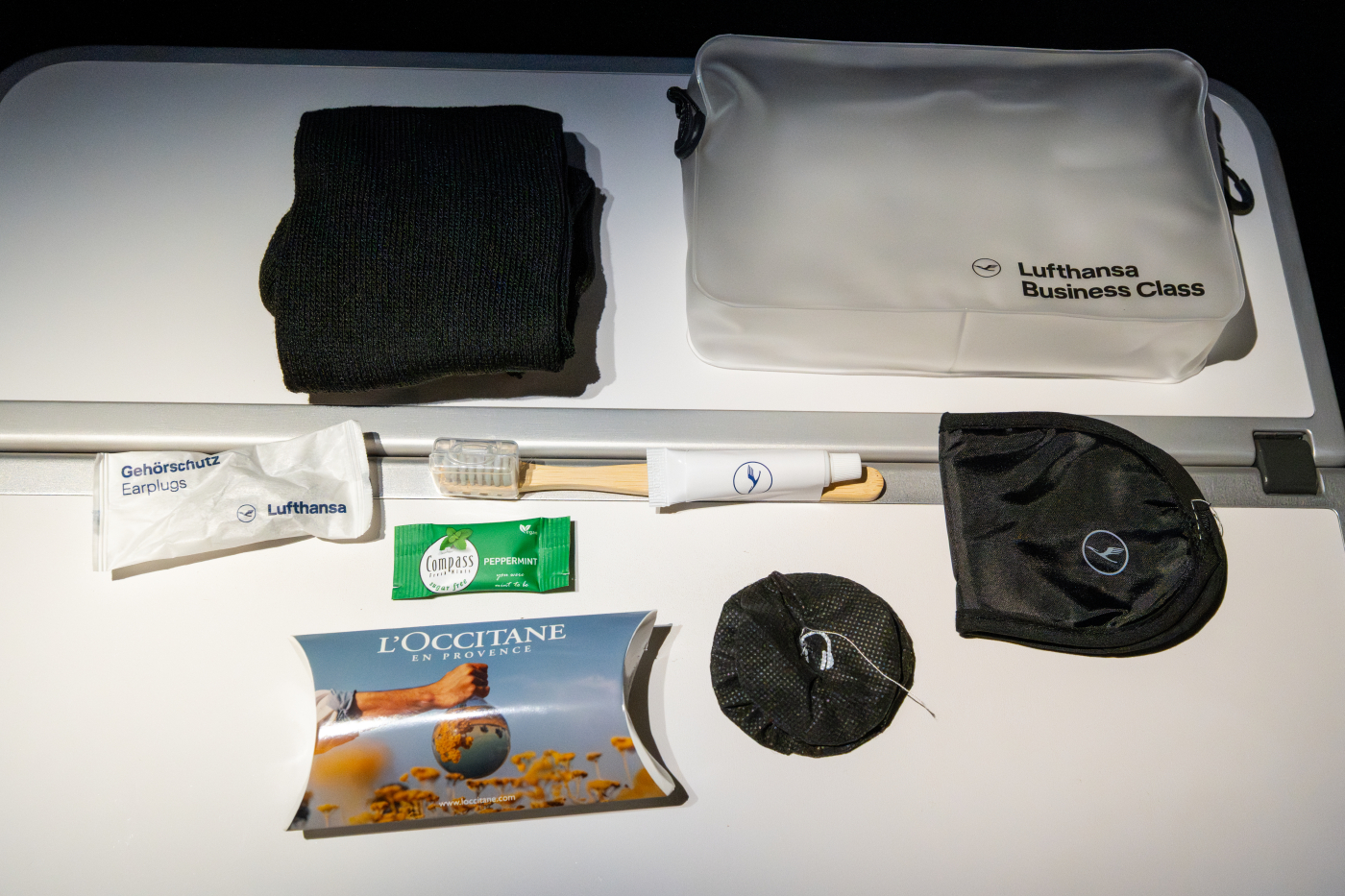
Shortly before departure, the crew offers each passenger a top pyjama, available in two sizes (S/M and L/XL), for a more comfortable rest during the flight.
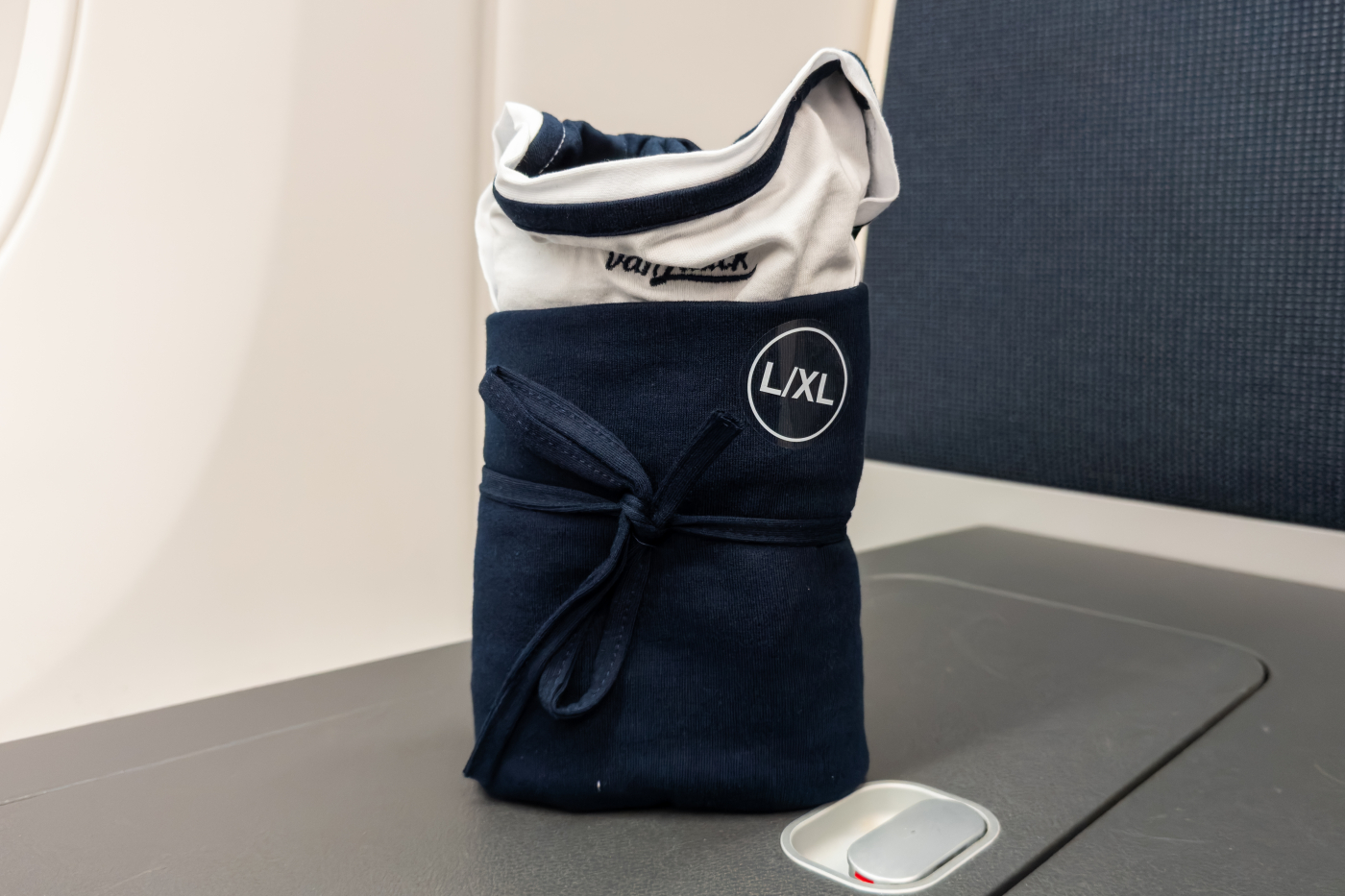
The lavatories, featuring a sleek and elegant design, combine brown leather and wood finishes with a white sink.
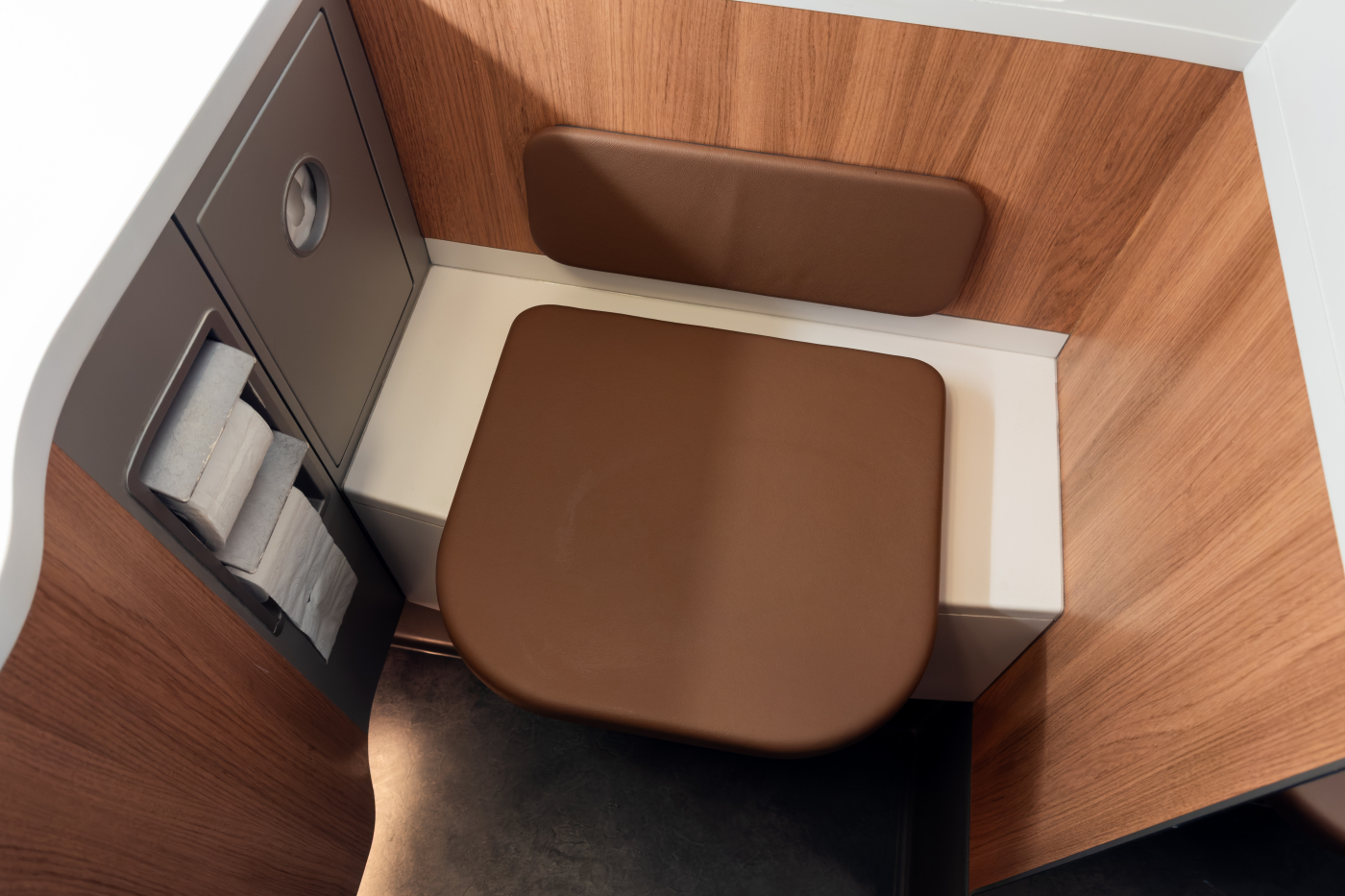
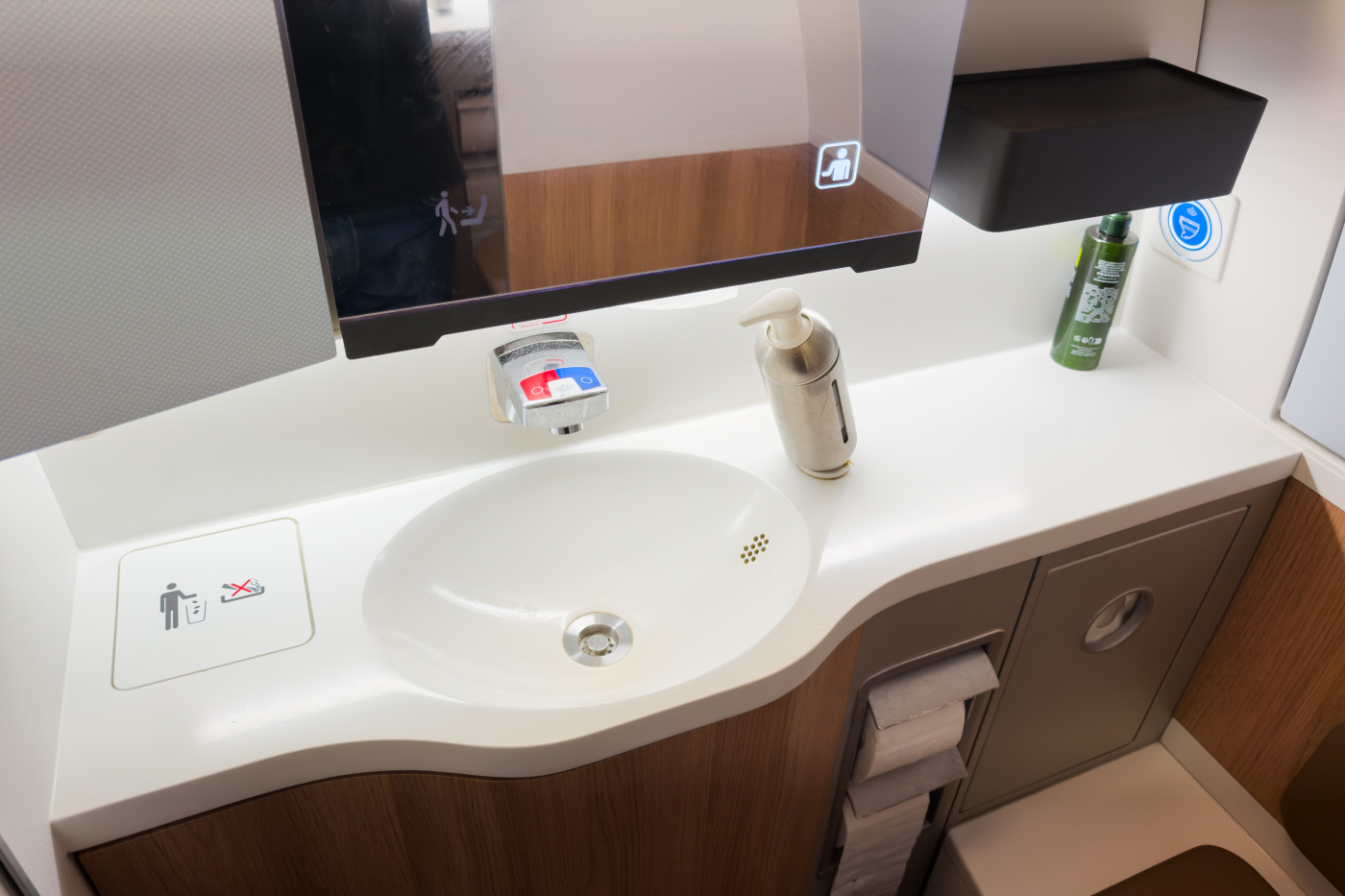
They are stocked with moisturizers, mouthwash, and refreshing wipes, complementing the amenities found in the personal kit.
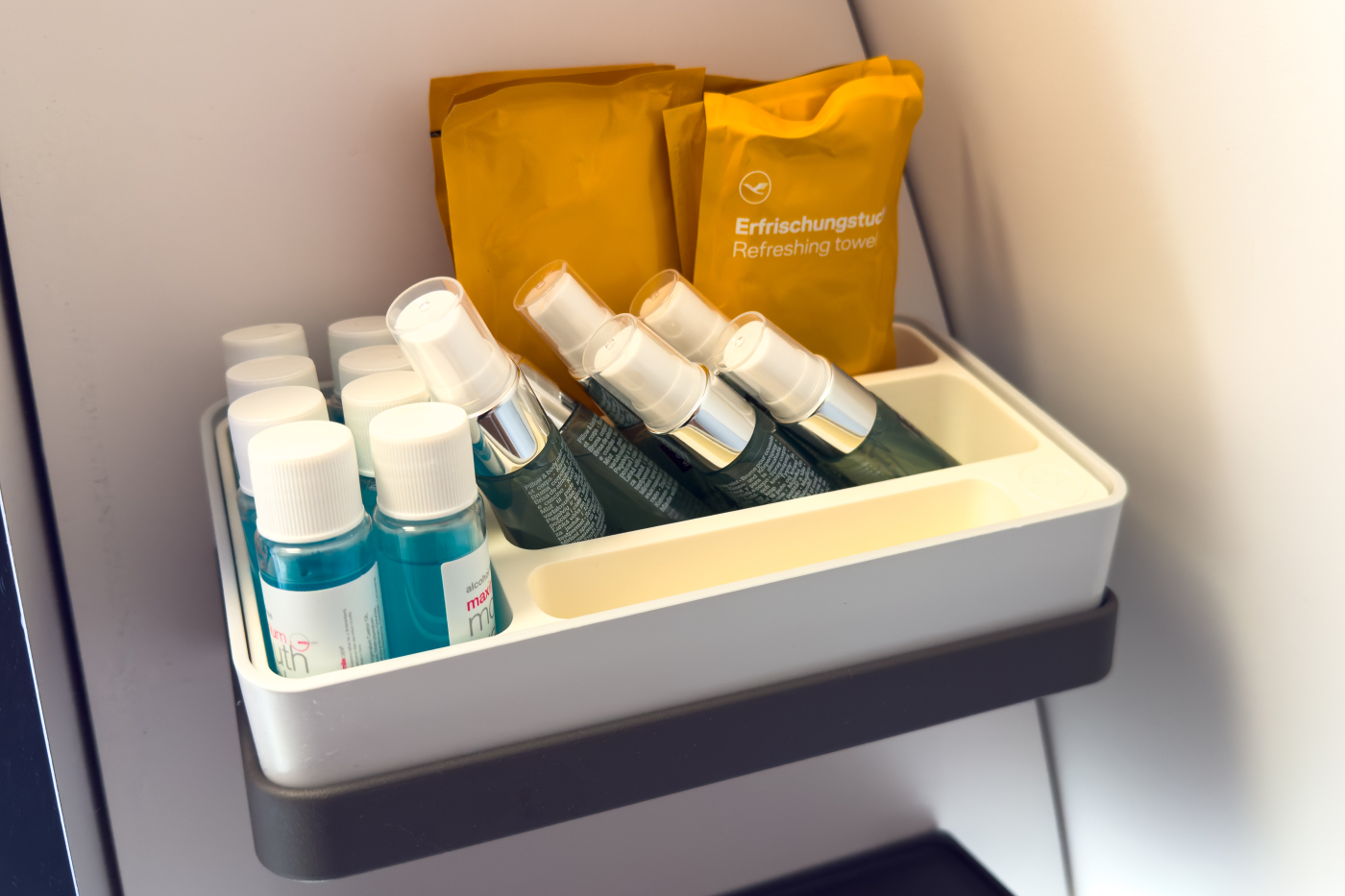
Upon boarding, passengers are offered a welcome drink. Options include sparkling wine, Lufthansa's signature AVIONIC cocktail, the Shanghai Magic cocktail, or simply a glass of water. These are accompanied by a selection of nuts and peanuts.
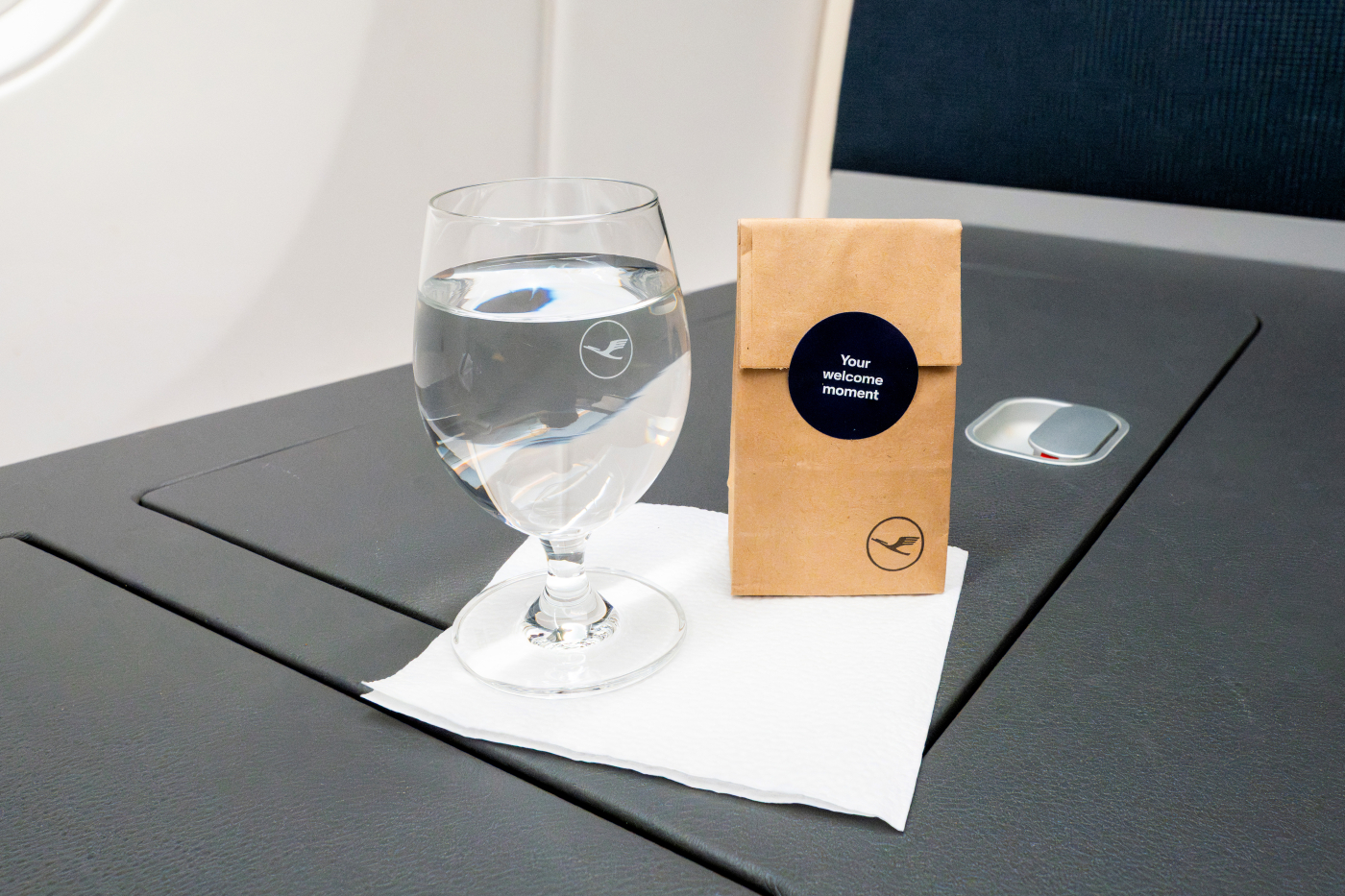
Before takeoff, the menu is distributed to passengers. It outlines the options for both dinner and breakfast, with some dishes developed in collaboration with the Michelin-starred restaurant at the Jing An Shangri-La Hotel in Shanghai.
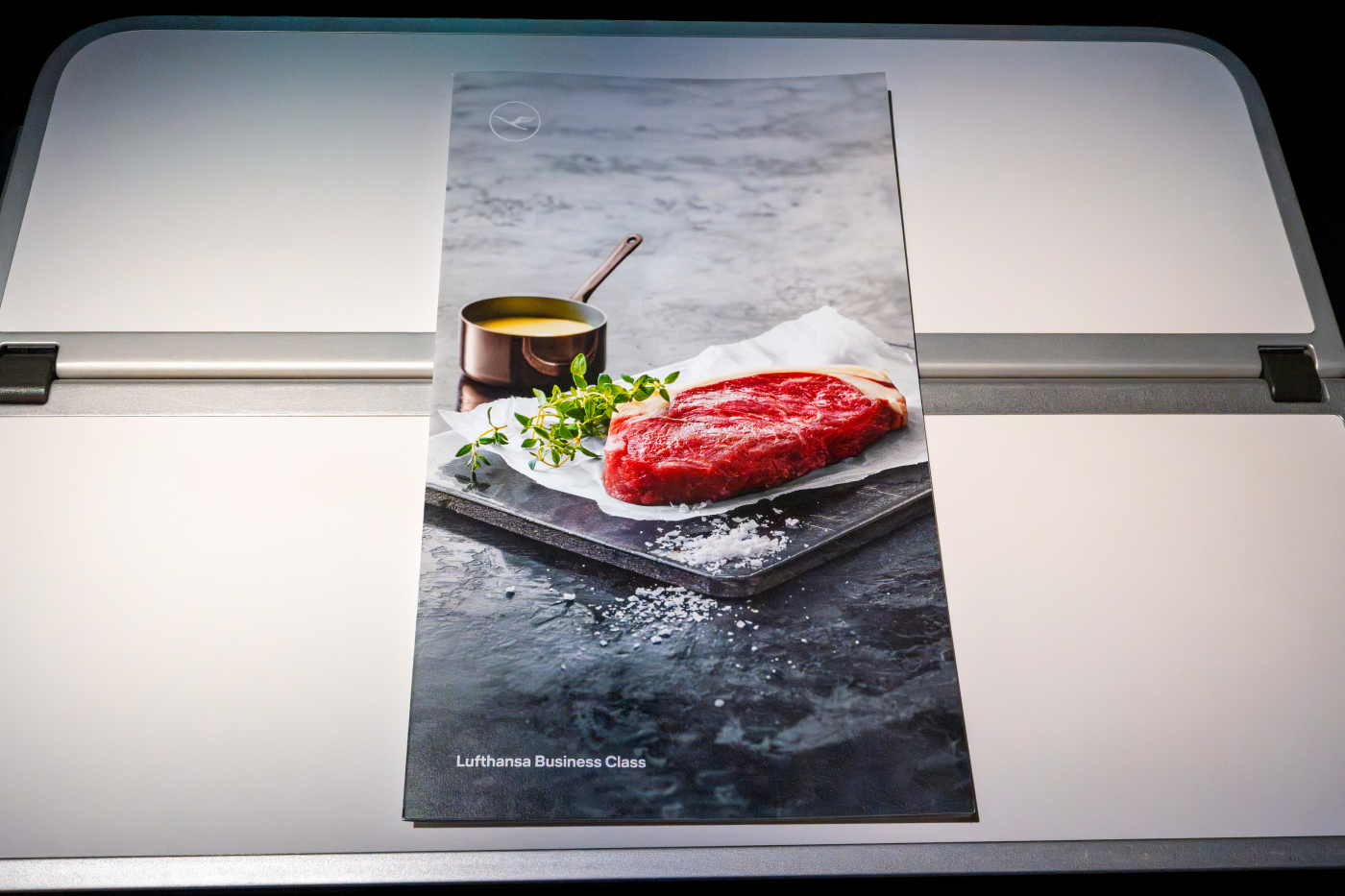


The menu also includes a comprehensive drinks list, featuring a detailed presentation of each wine.
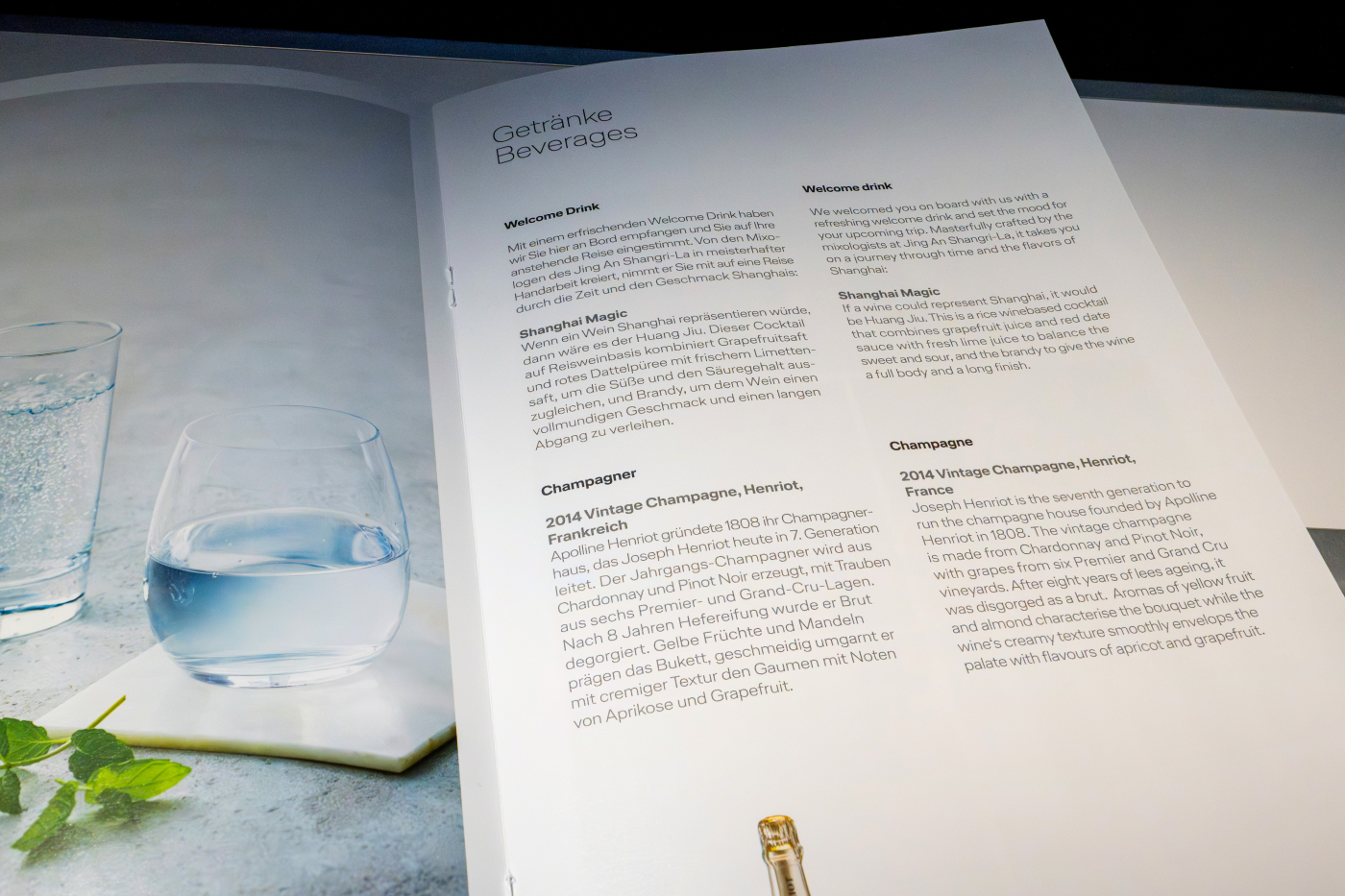
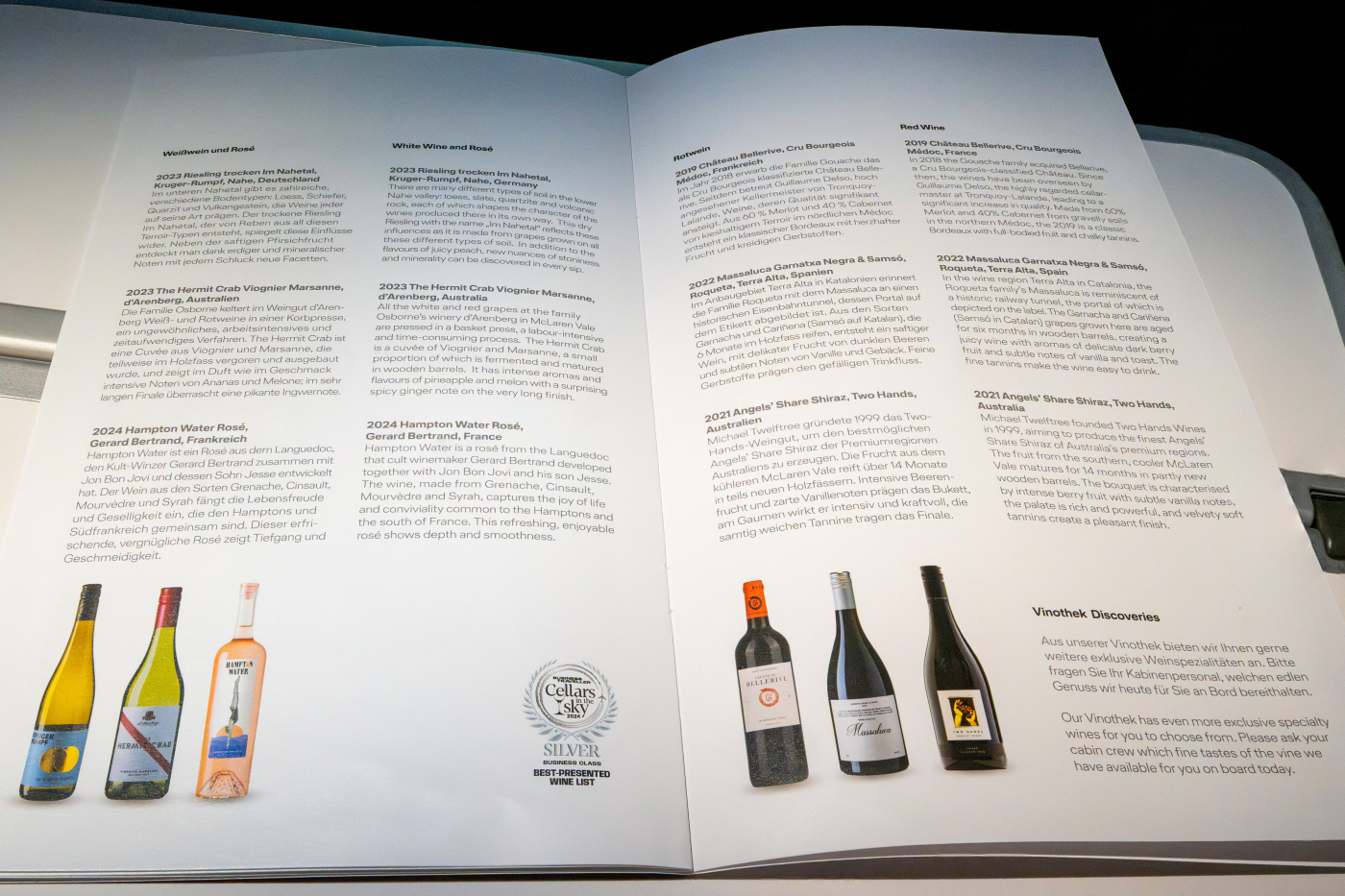
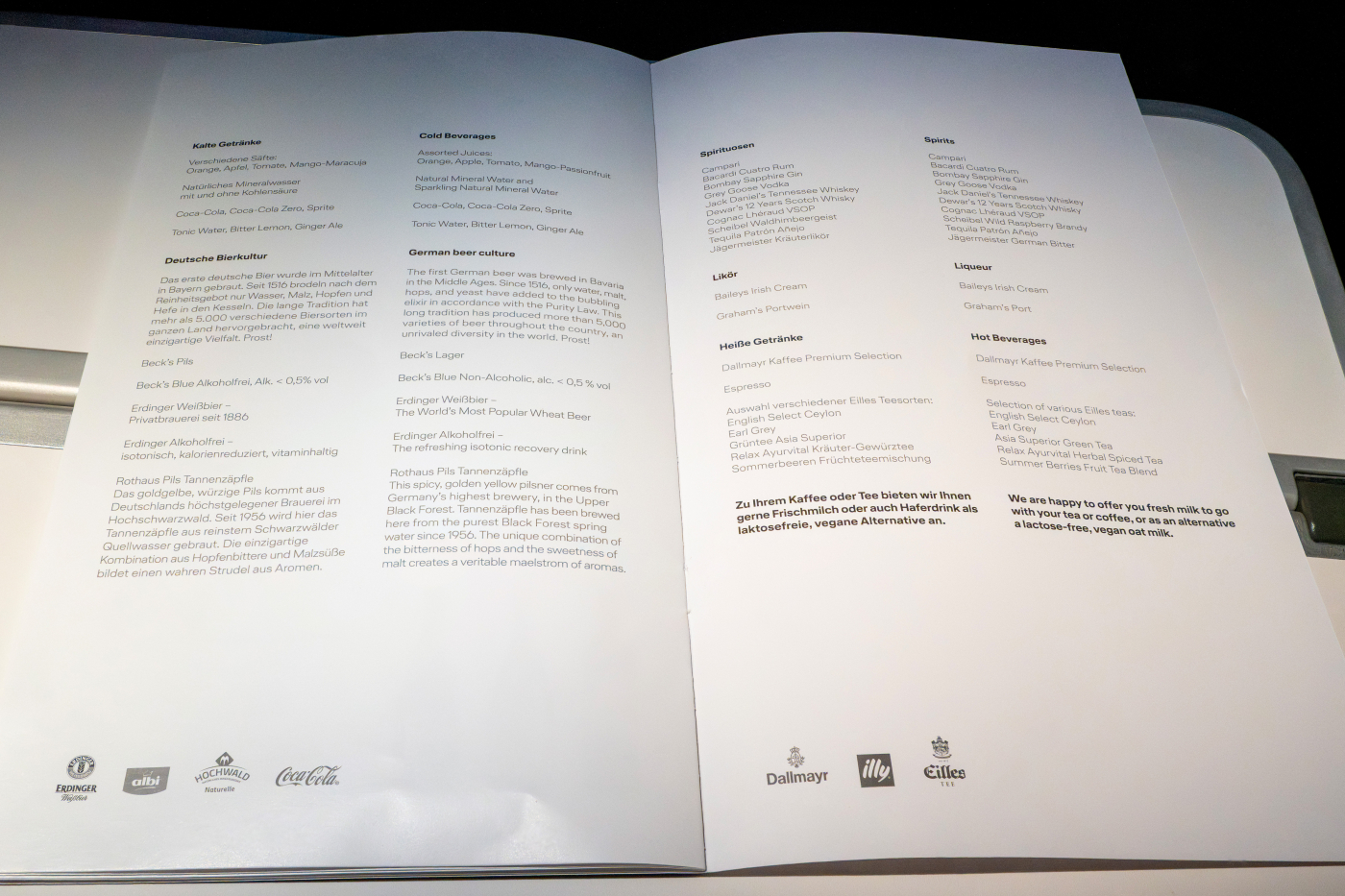
Passengers flying in the Business Class Suite receive an additional mini-menu served after takeoff. It includes a personalized welcome message as well as an extended selection of drinks and snacks, available throughout the flight, complementing the standard menu offered to the rest of the cabin.
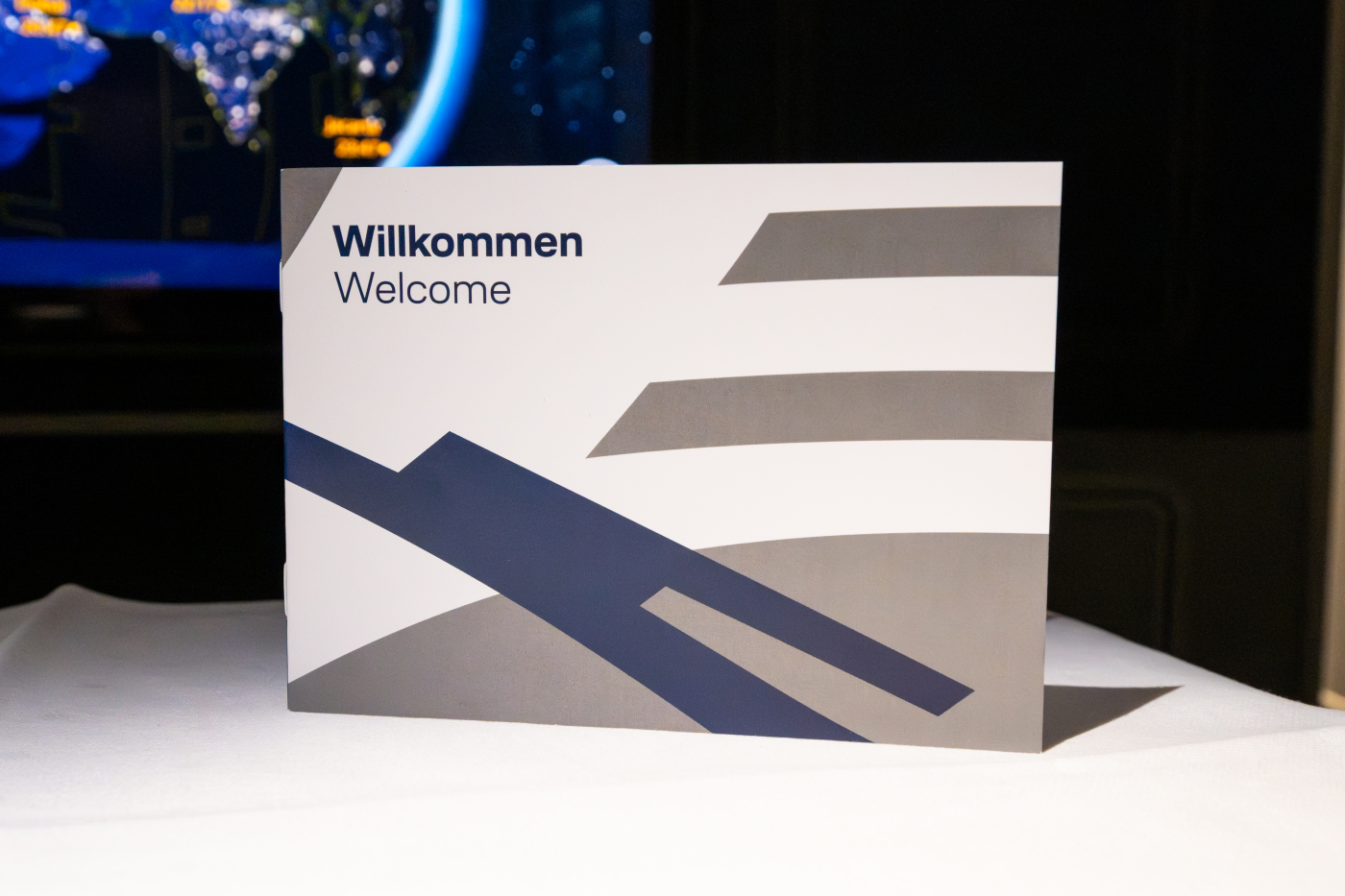
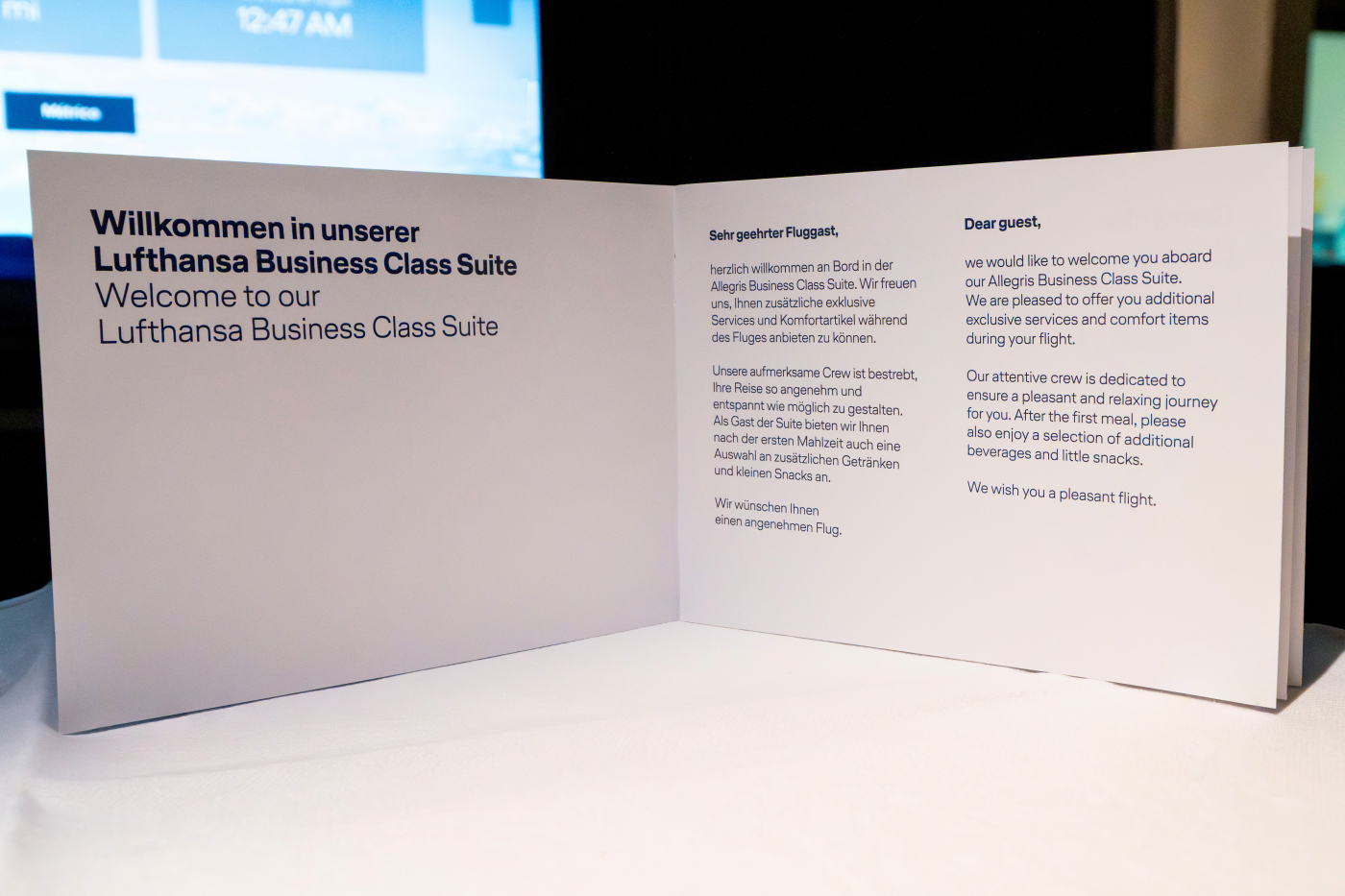
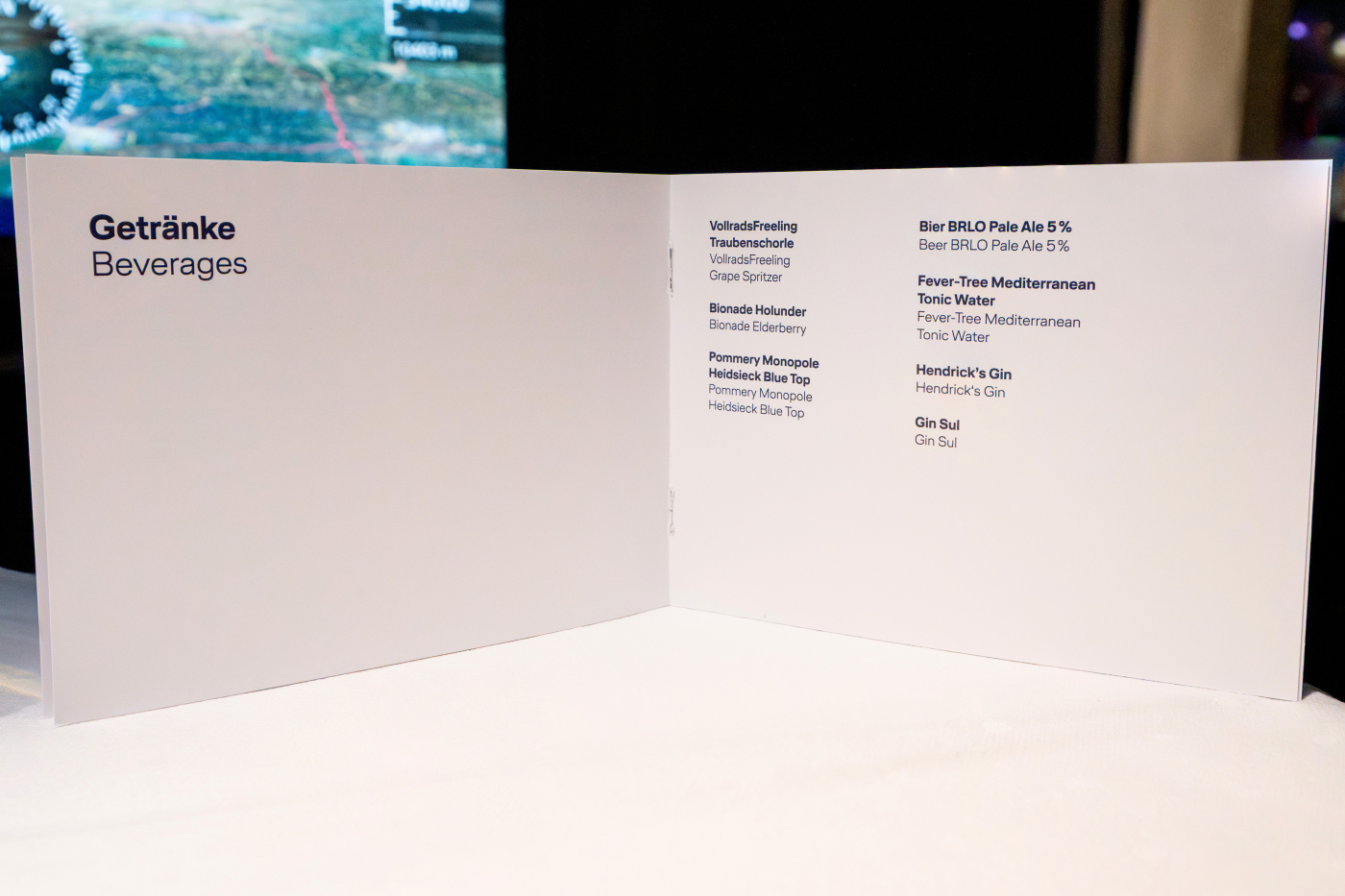

After a refreshing oshibori, the service began with an aperitif – I chose a glass of Henriot 2014 Champagne – accompanied by an amuse-bouche, although the exact details were not specified.
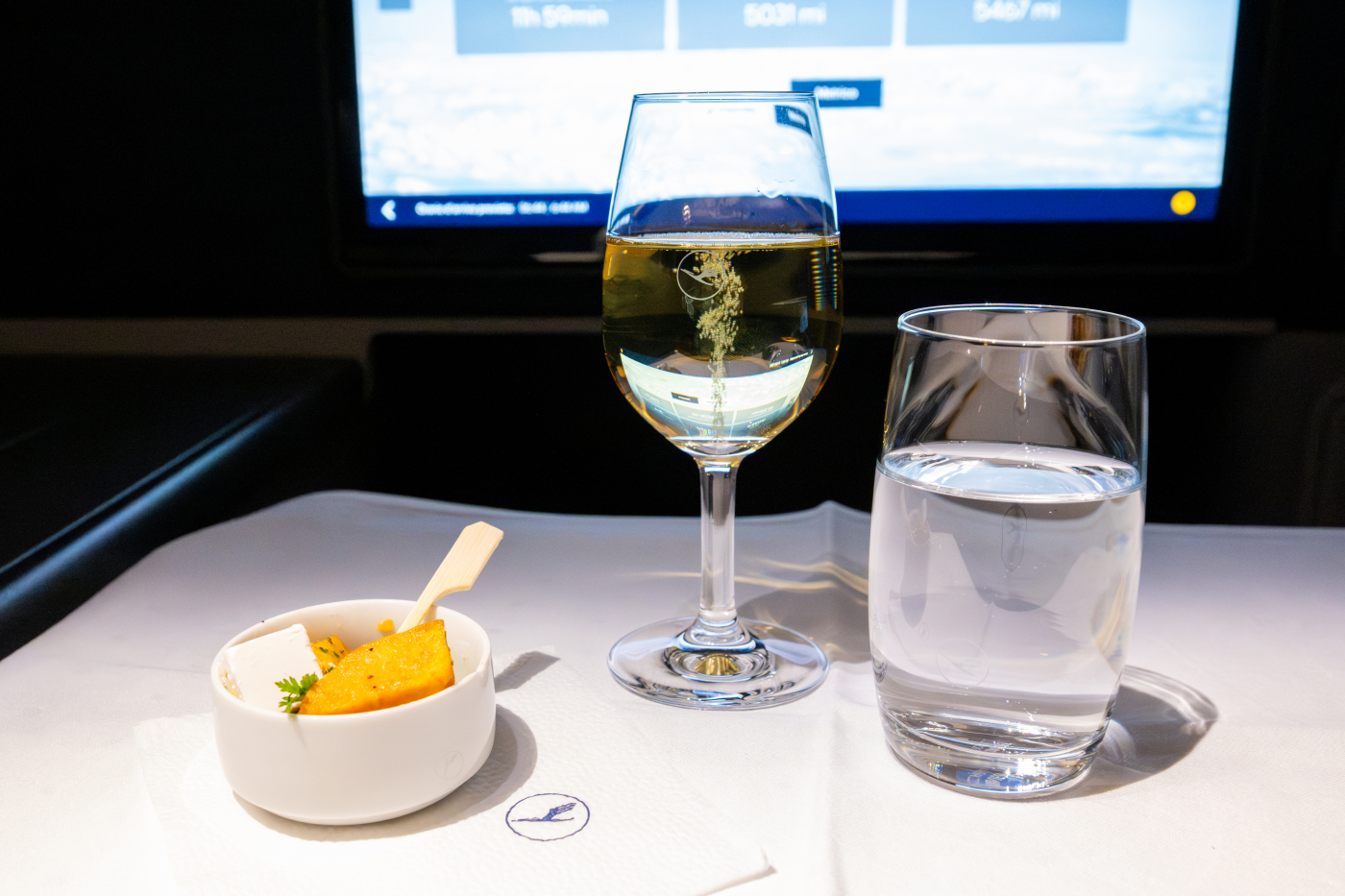
For starter, I opted for the charred prawns with ginger sriracha, served with a salad, bread, and butter. I decided to stick with Champagne for the rest of the meal. The prawns were flavorful, and the bread was perfectly baked, crisp on the outside and soft inside.
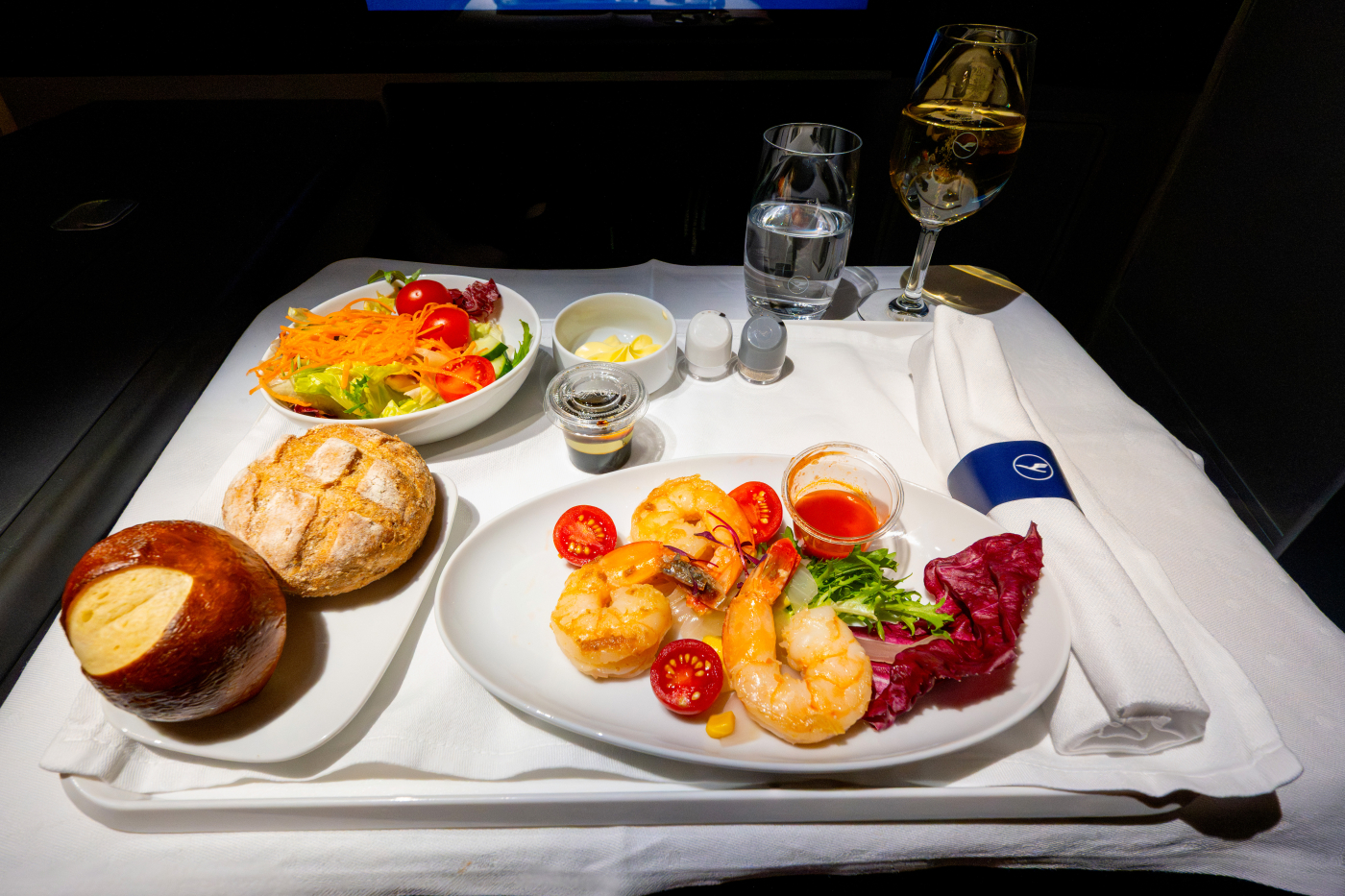
For the main course, I chose the sesame and scallion beef tenderloin. The beef was perfectly cooked and delicious, making for a very satisfying main dish.
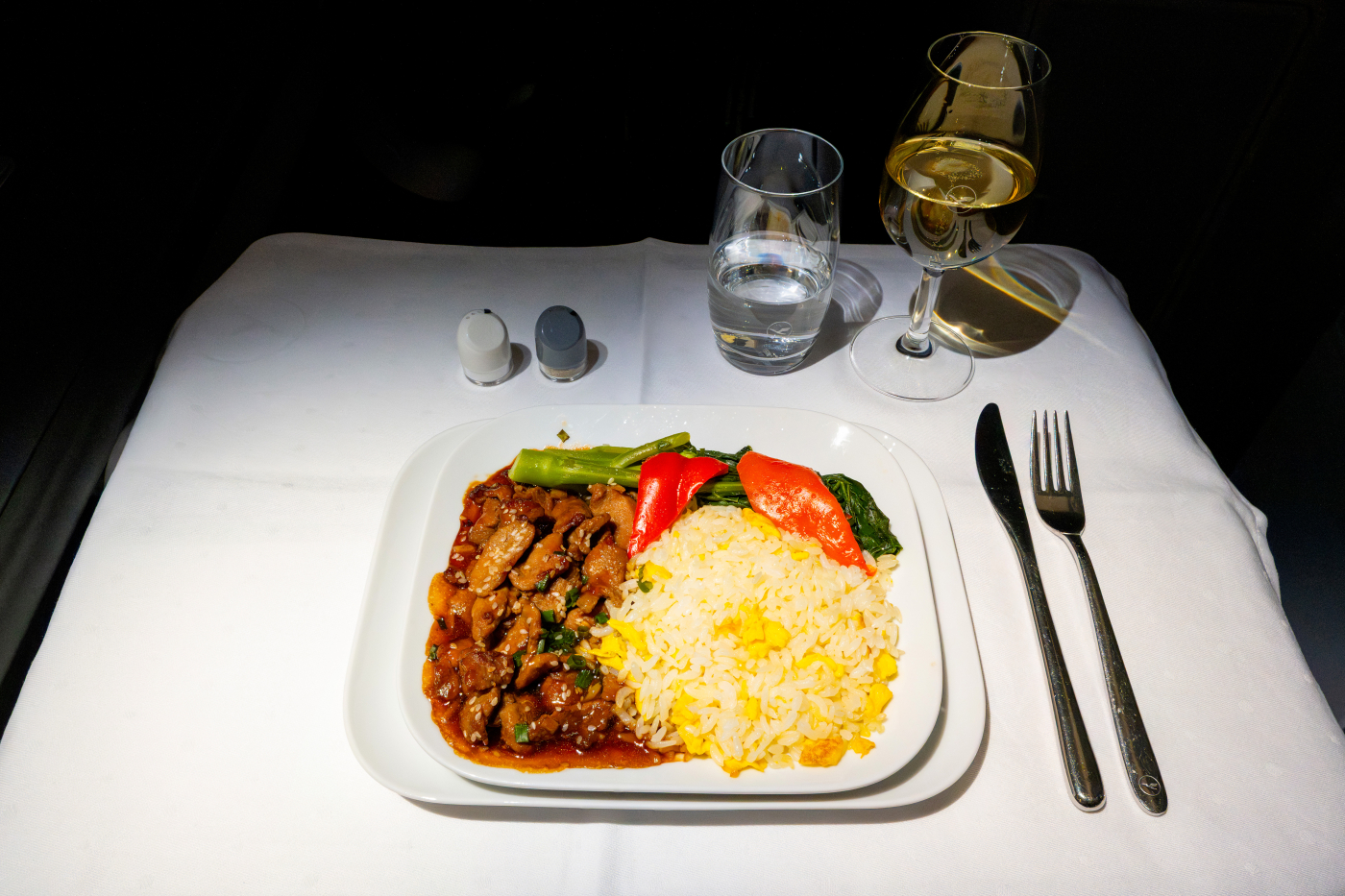
For dessert, I tried both the cheese plate and the tiramisu. As often with Lufthansa, the cheeses lacked character and depth of flavor, while the tiramisu was well executed and enjoyable.
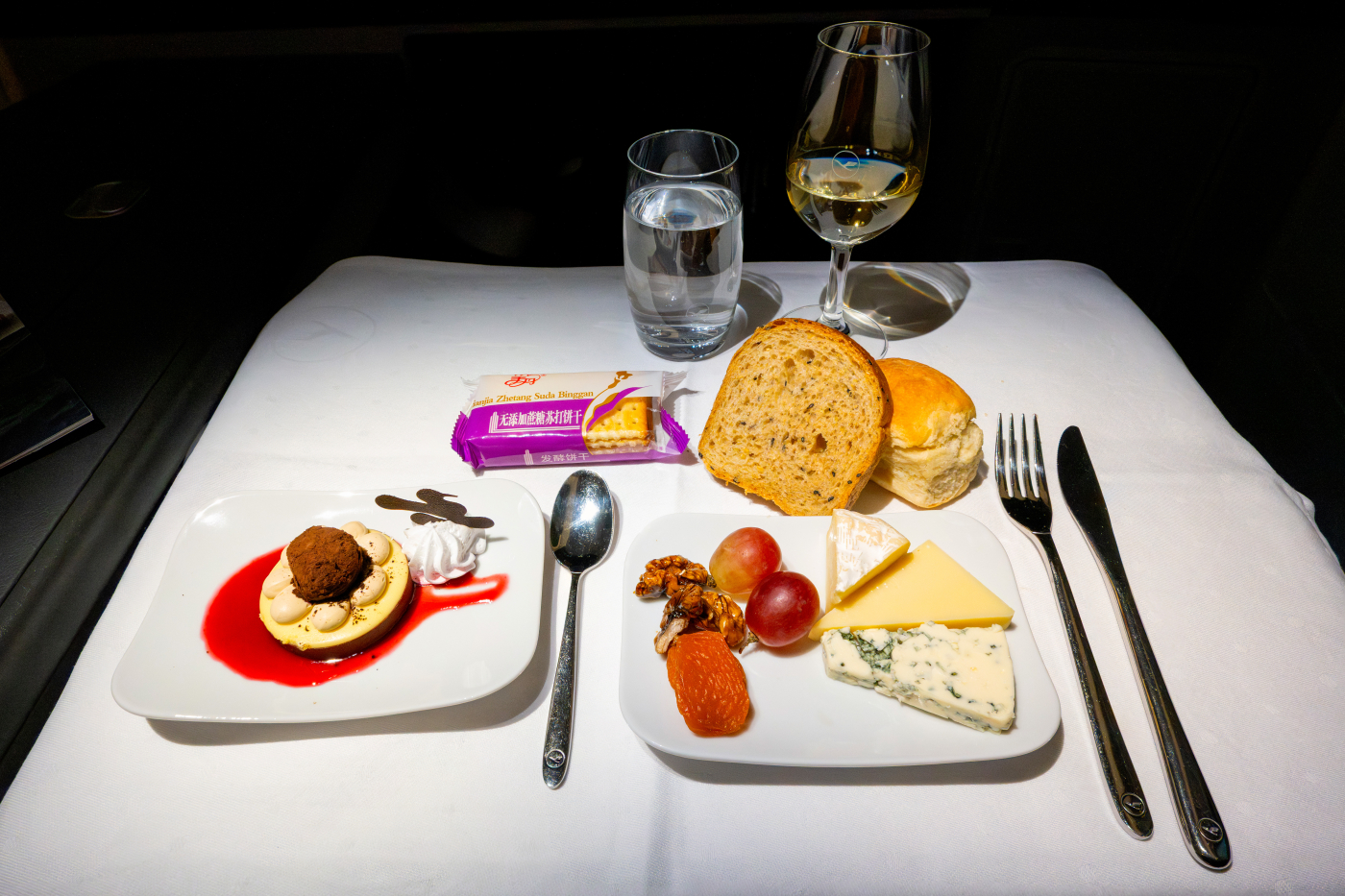
After a second oshibori, breakfast was served. I chose scrambled eggs, fresh and flavorful, accompanied by green tea and apple juice. The fruits were decent but not particularly remarkable. The croissant and bread complemented the meal well, served slightly warm and delightfully crisp.
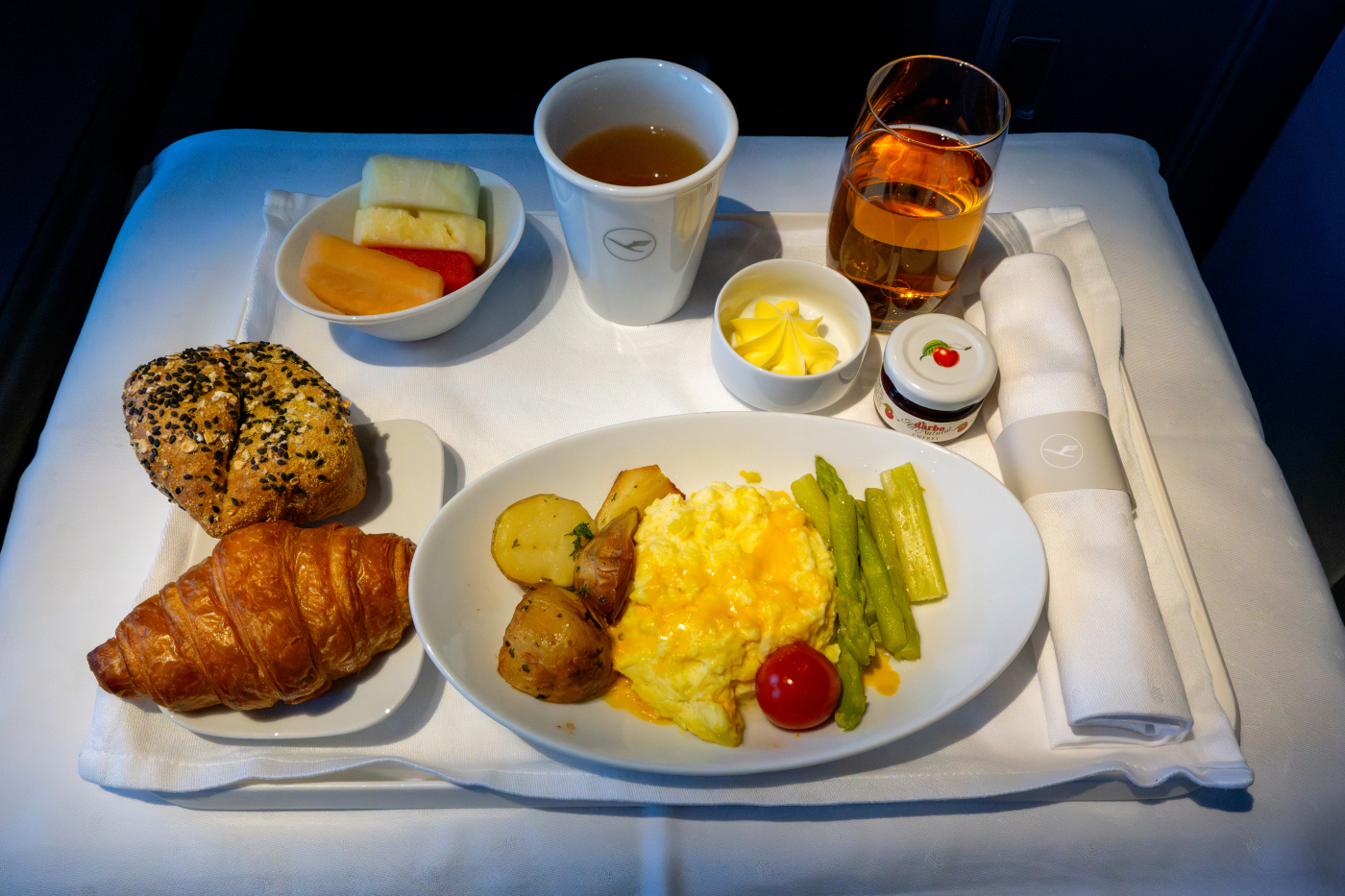
The crew was absolutely outstanding. I was mainly assisted by one particular flight attendant, who was very friendly, helpful, and proactive. She was consistently attentive, regularly offering drinks – which is not always standard on Lufthansa flights. The experience felt highly personalized and particularly pleasant.
Before landing, we briefly discussed the Allegris cabin. The flight attendant explained that this cabin presents several challenges for the crew: the compact Business Class galley, limited space for personal belongings, and the complex seat configuration can lead to misunderstandings for both passengers and staff. Crew members who do not fly exclusively on Allegris aircraft are not yet fully accustomed to this cabin and its features. She also noted that the layout is not ideal for friends, families, or young children due to the limited number of side-by-side seats. Finally, some technical features, including the Control Panel and seat management, are not yet entirely reliable. According to her, the cabin seems to have been designed without thorough consideration of the needs of both crew and passengers, resulting in certain inconsistencies. This perspective aligns with several reports I have previously heard.
The Allegris Business Class replaces the traditional remote control found on other Lufthansa aircraft with the Control Panel, a 10-inch touchscreen that allows passengers to manage the main entertainment screen, seat position, and lighting. With good resolution, it can be used in both portrait and landscape modes.
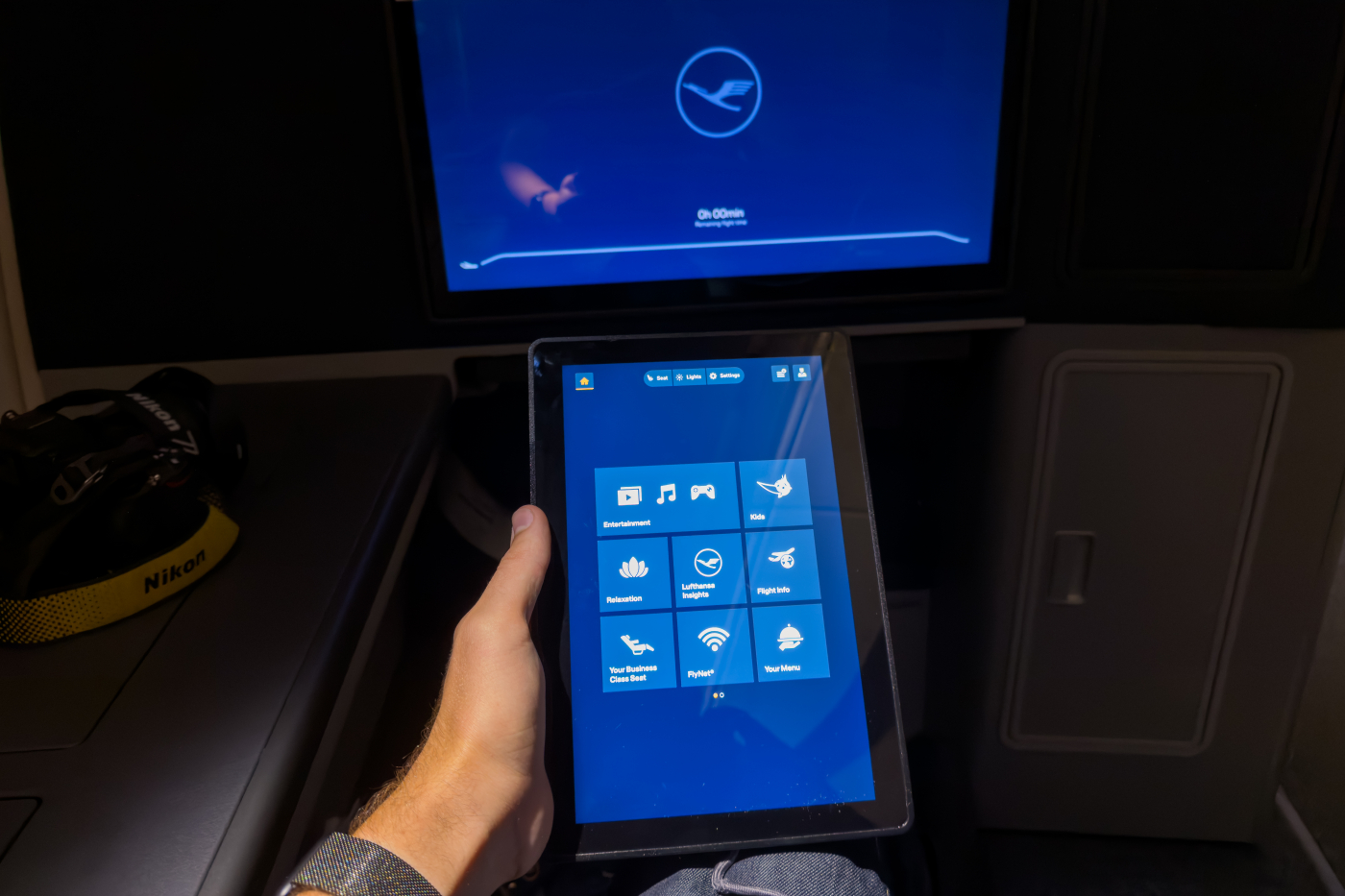
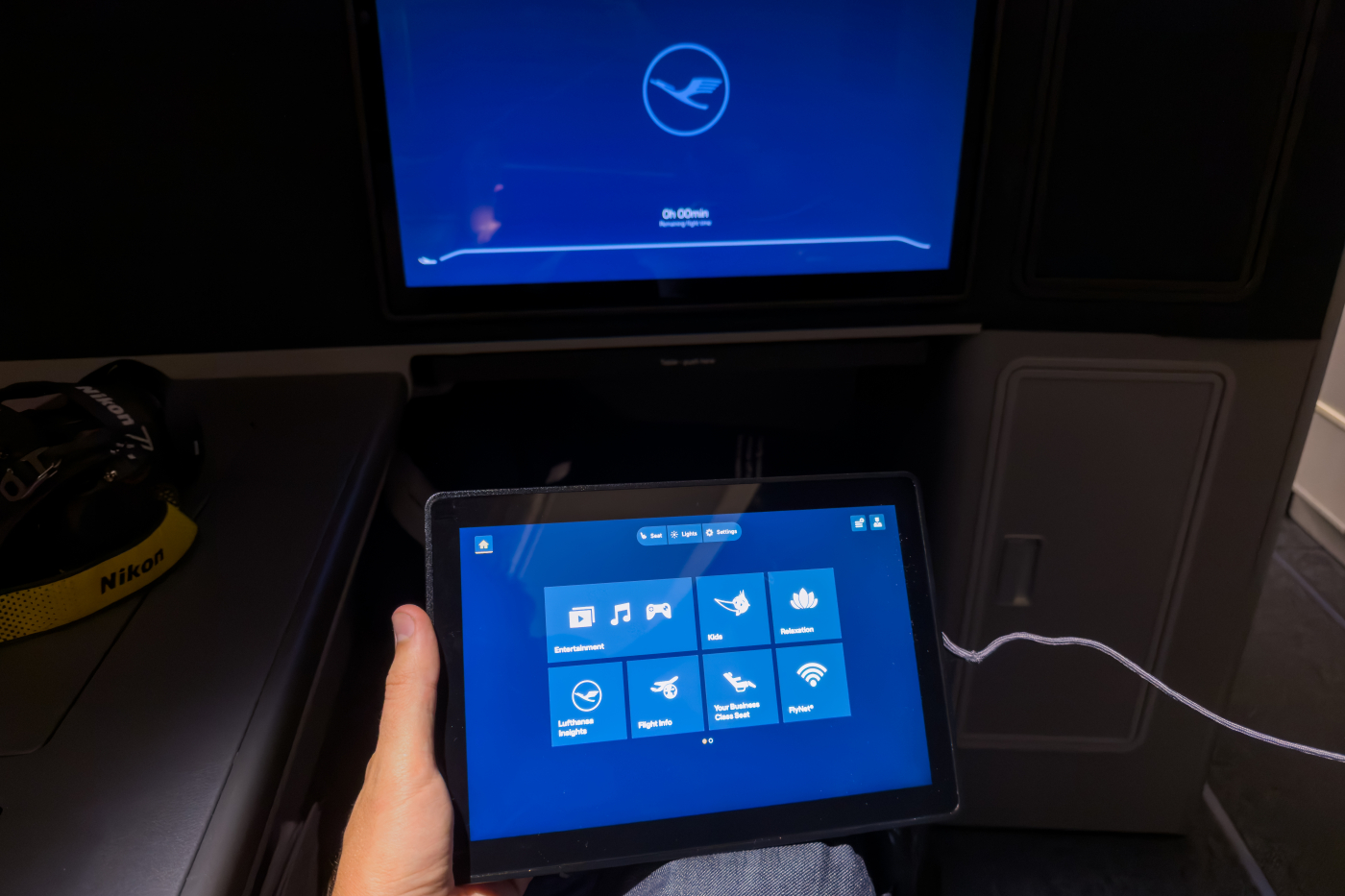
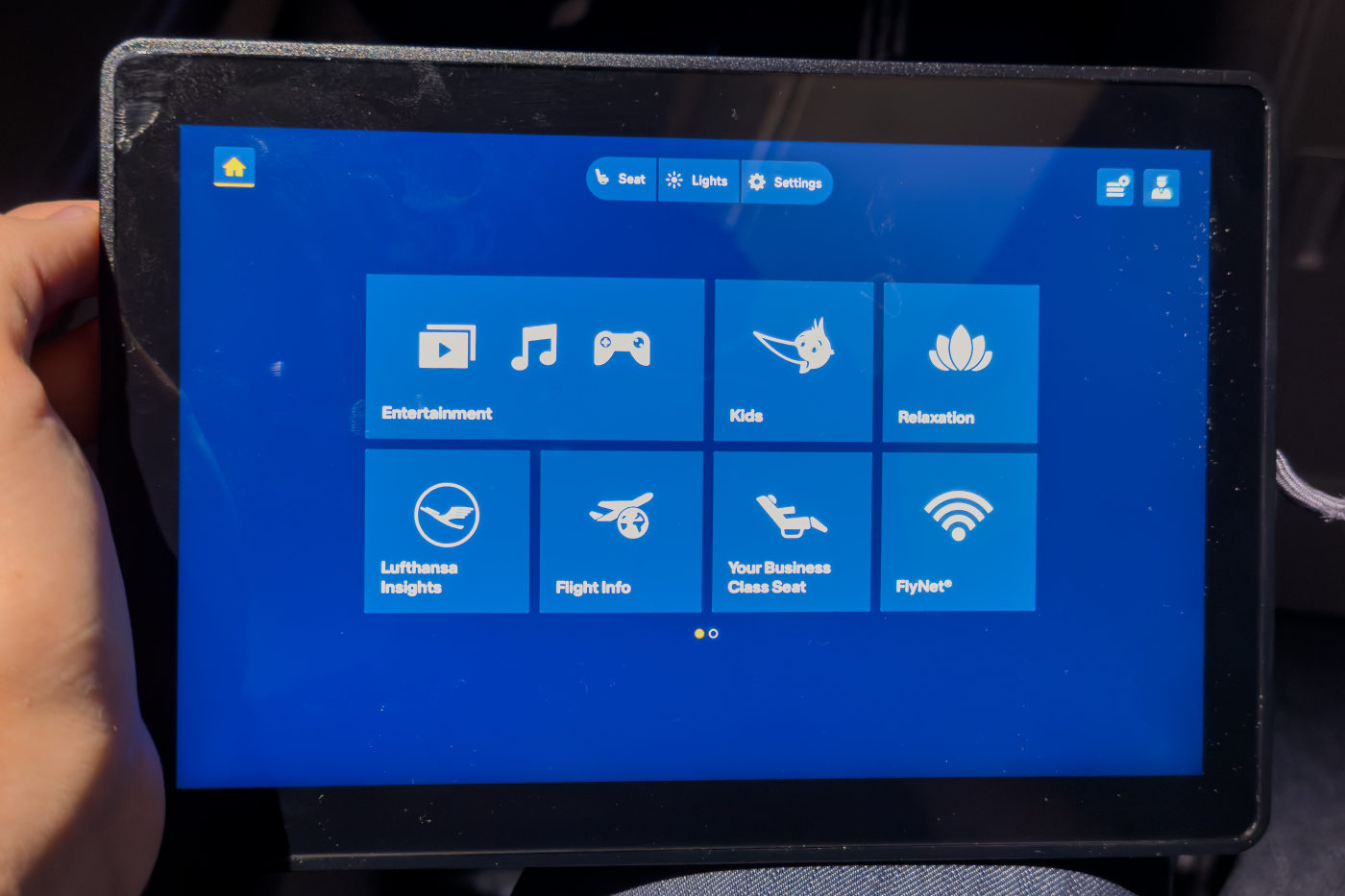
The tablet integrates the entire entertainment content: movies, series, music, games… However, Lufthansa's film catalogue remains limited, with a noticeable lack of new releases and diversity compared to competitors. Additionally, many titles are only available in English or German, even though other language versions exist.
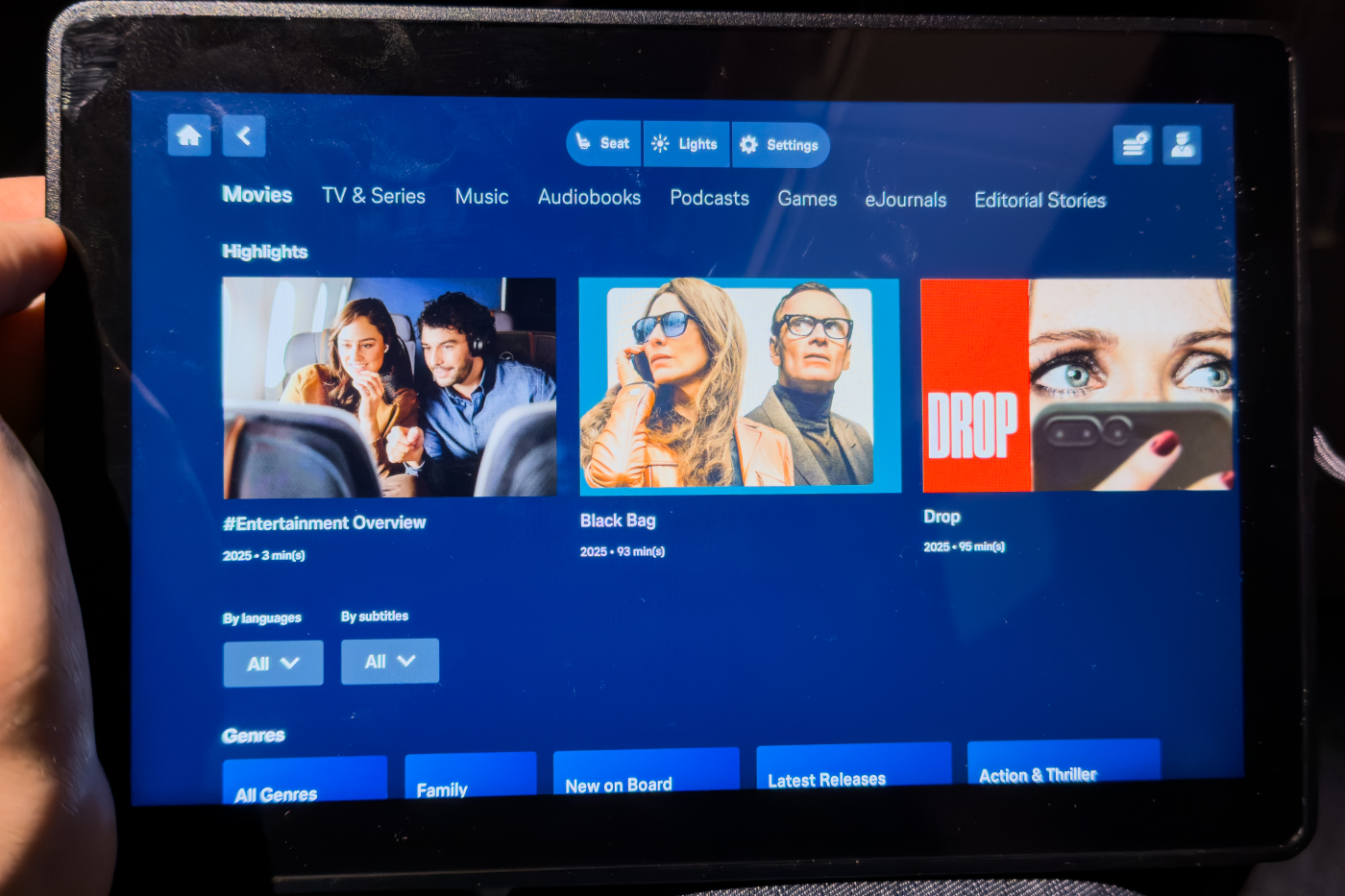
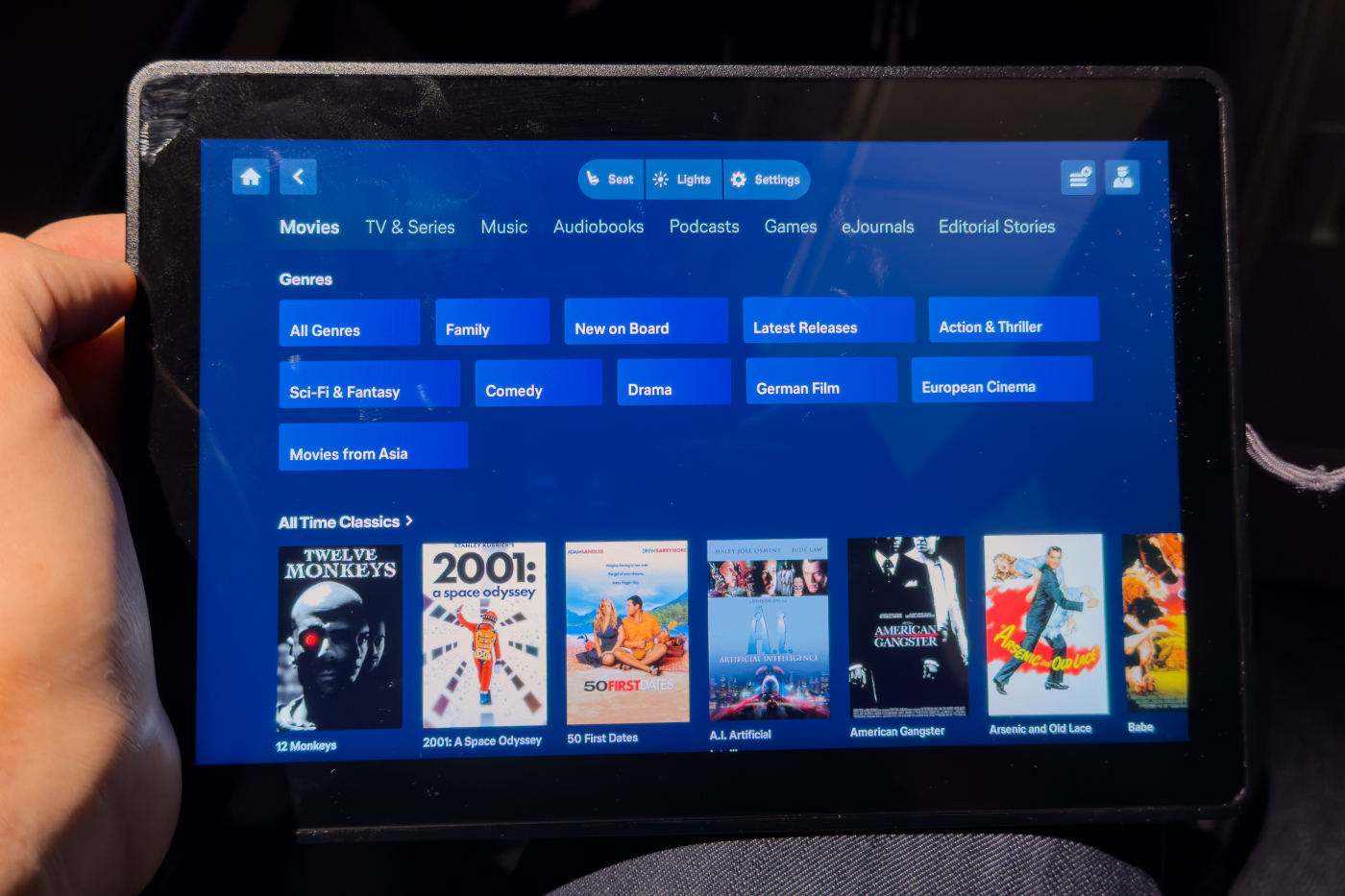
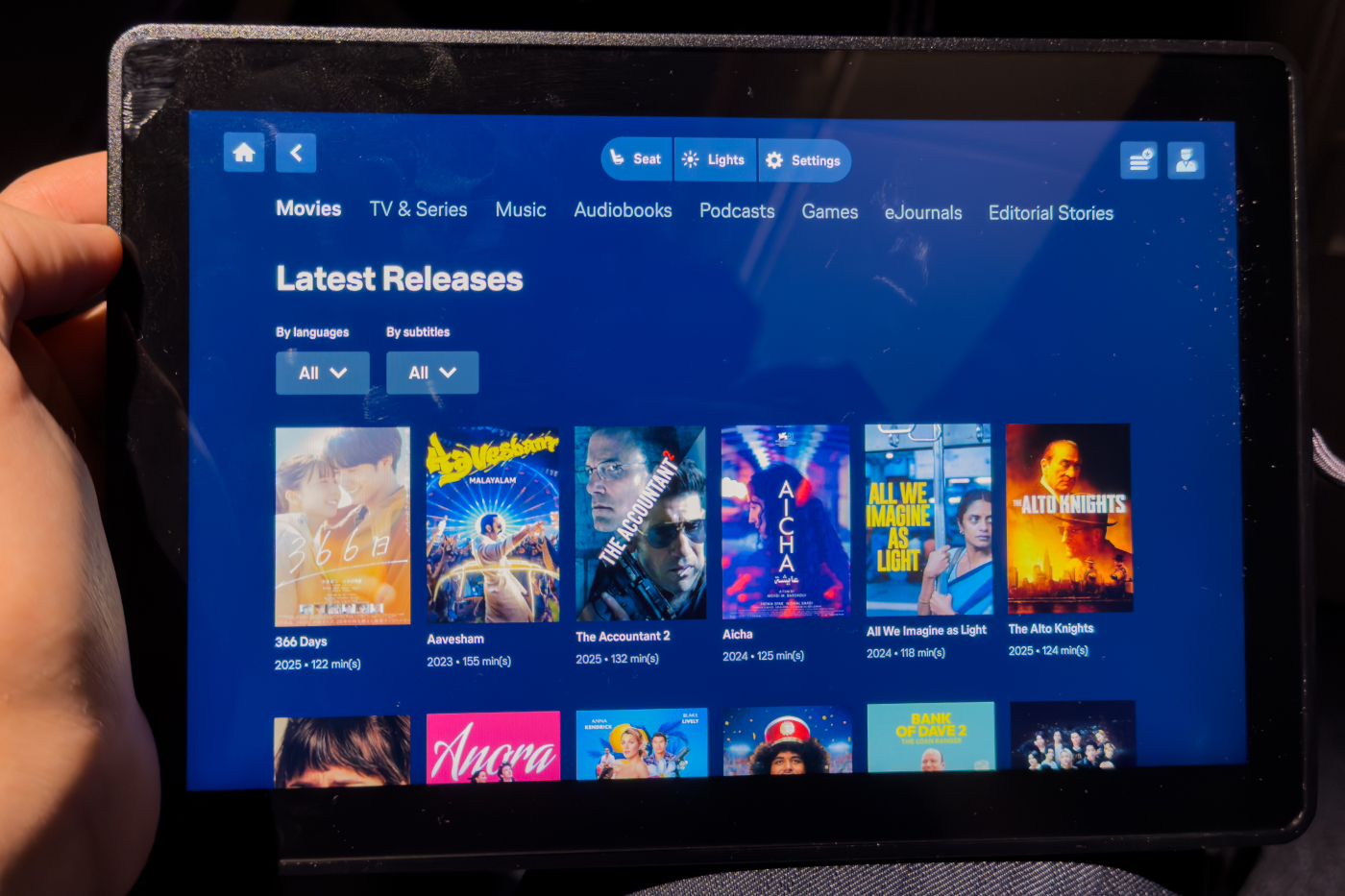
The Control Panel also provides access to an interactive map, customizable and adjustable in various views, allowing passengers to track the flight's progress in real time.
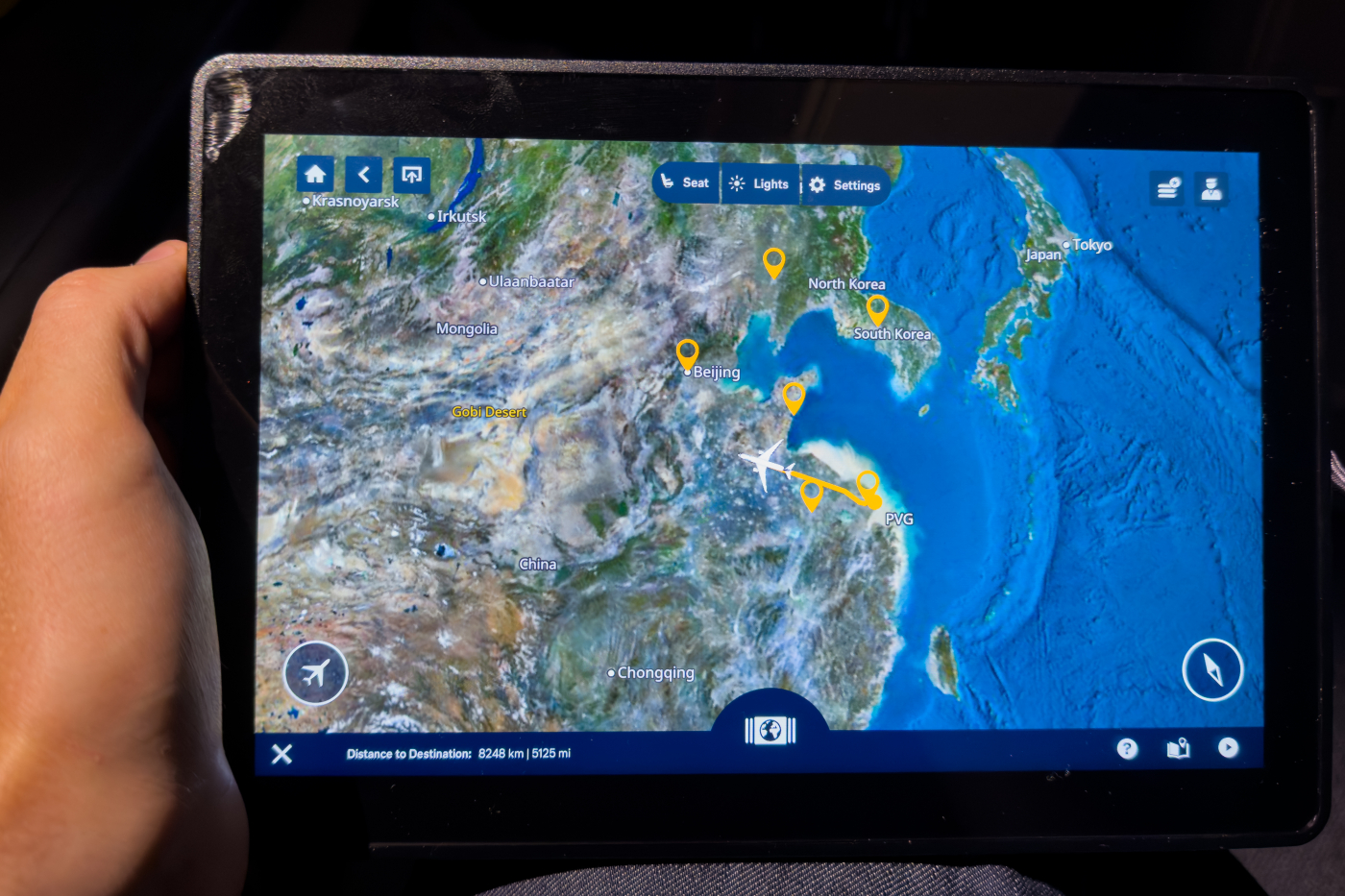
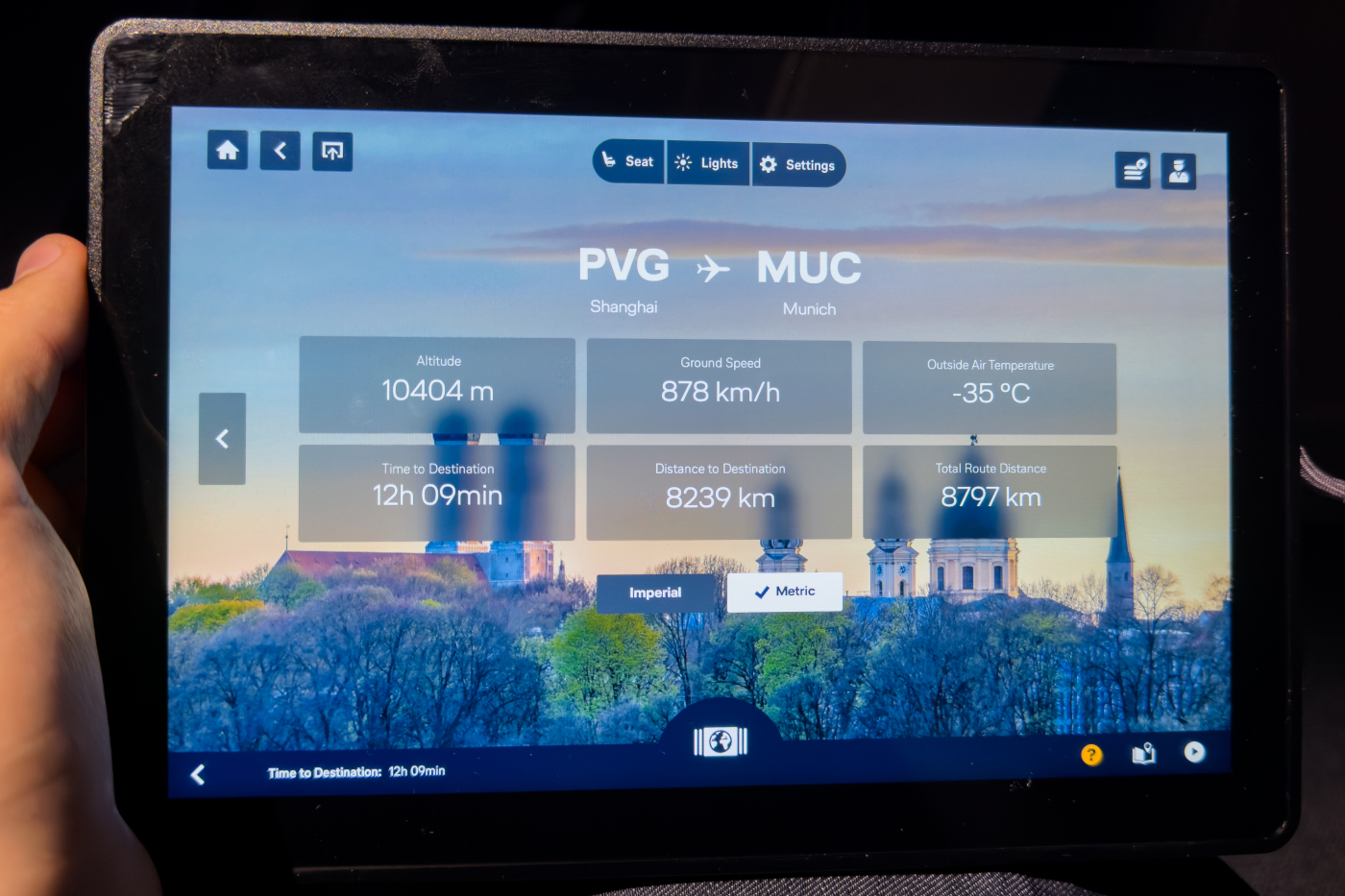
For comfort, it allows precise seat position adjustments, firmness settings, and even offers a new feature on board: seat temperature control, with both heating and cooling modes, both of which were effective during my tests.
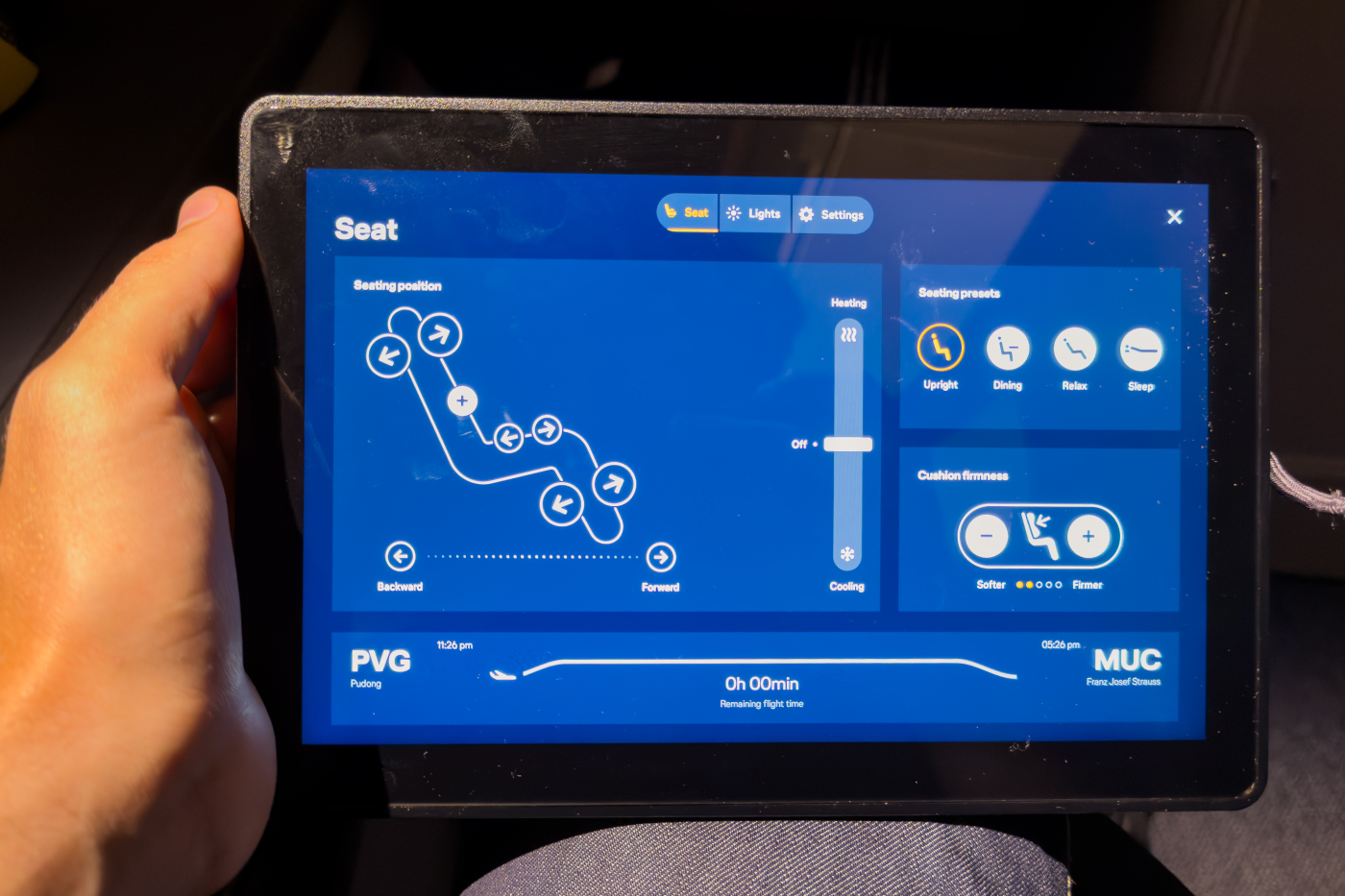
Finally, it is possible to adjust the seat lighting as well as the brightness of the screens.
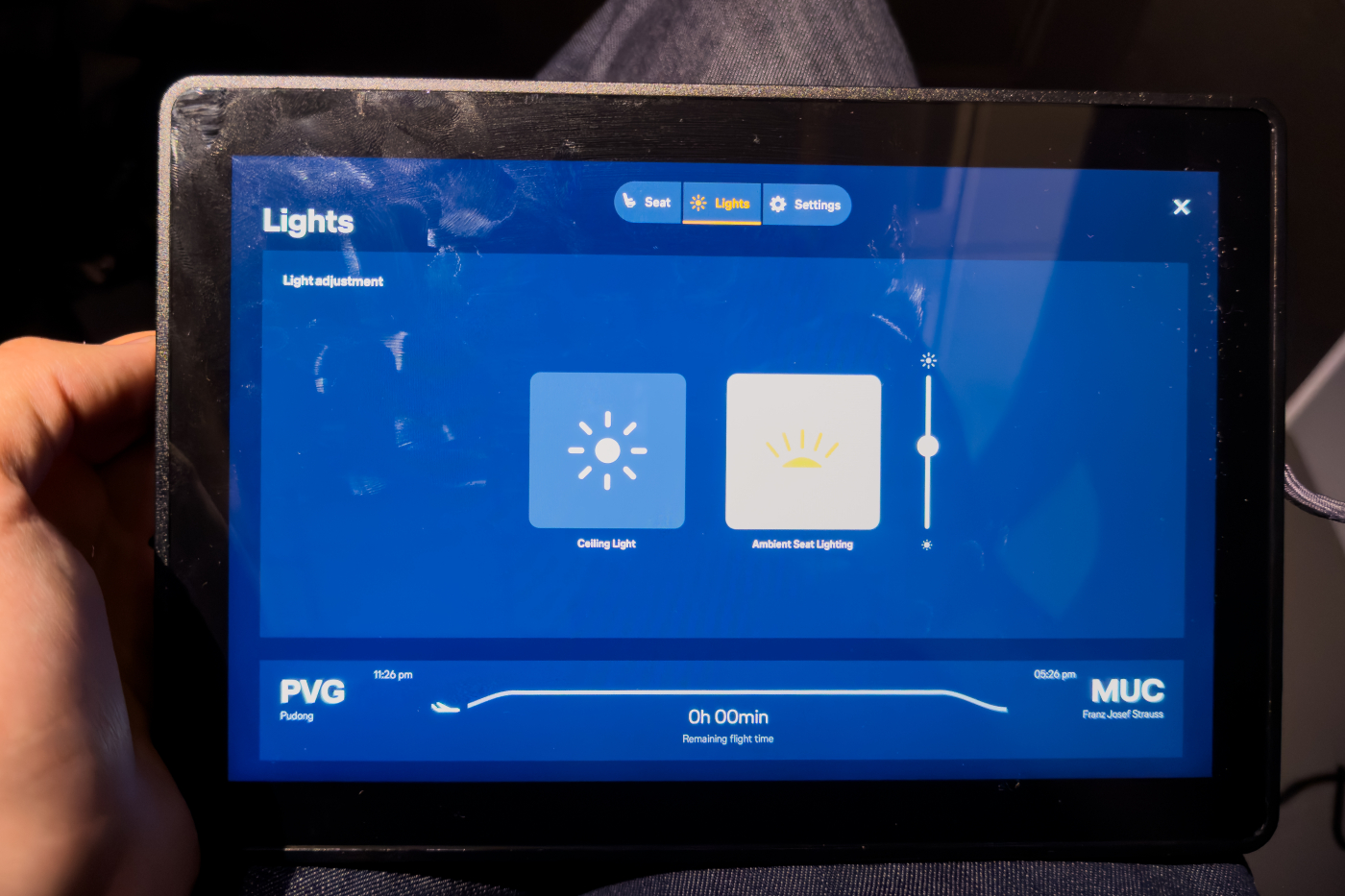
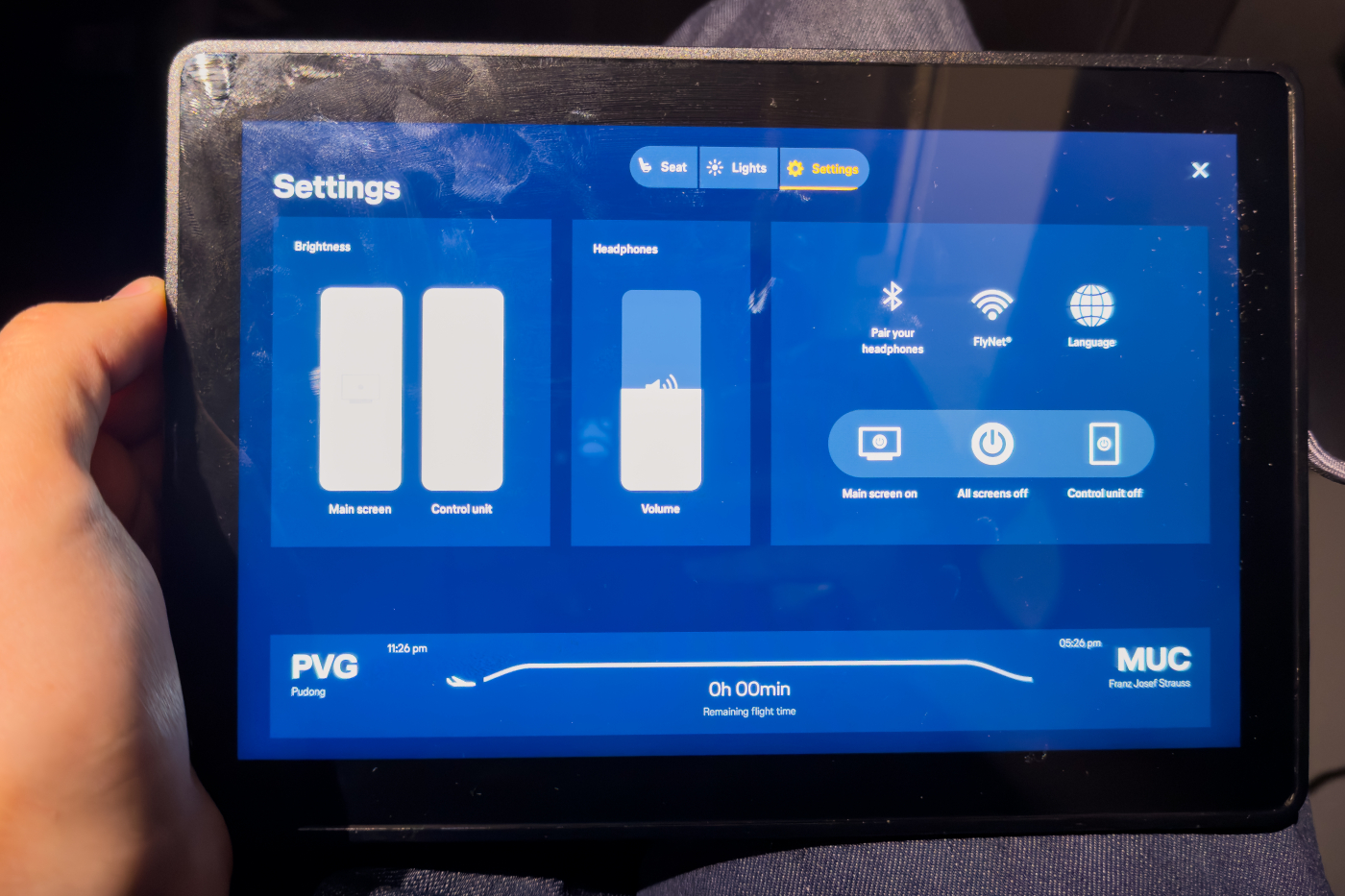
As expected, the main 24-inch touchscreen entertainment display offers the same content and features as the Control Panel.
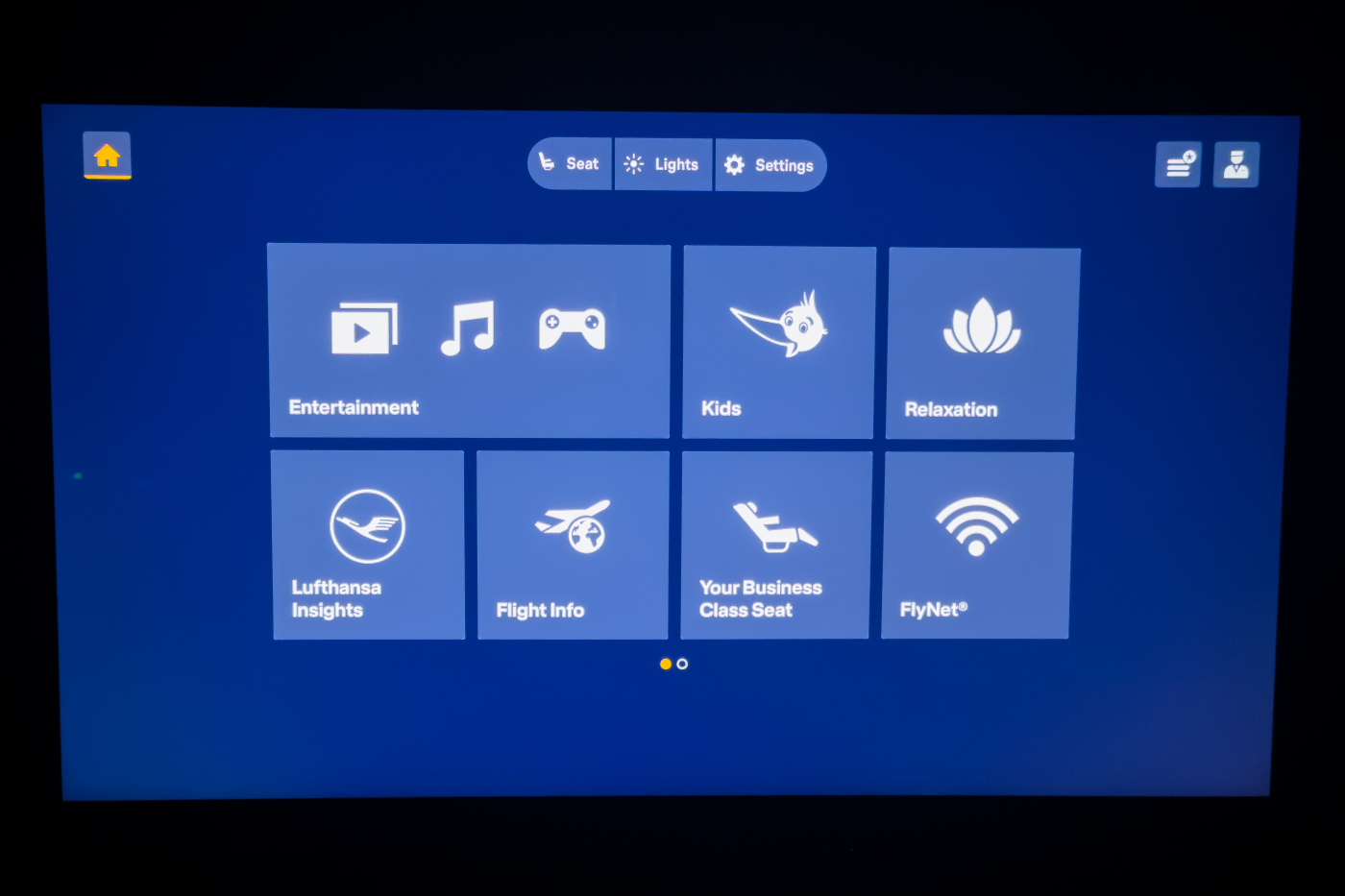
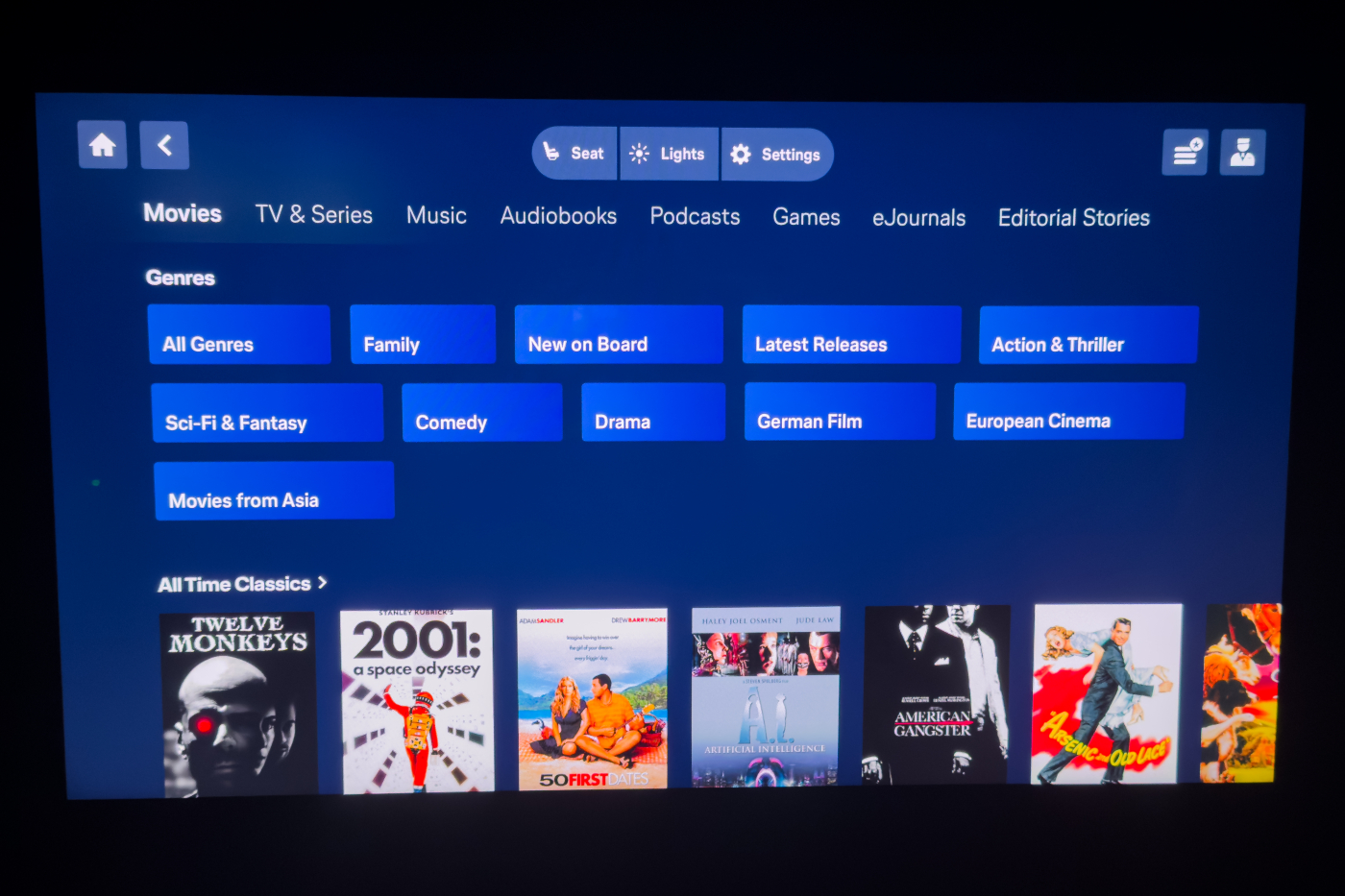
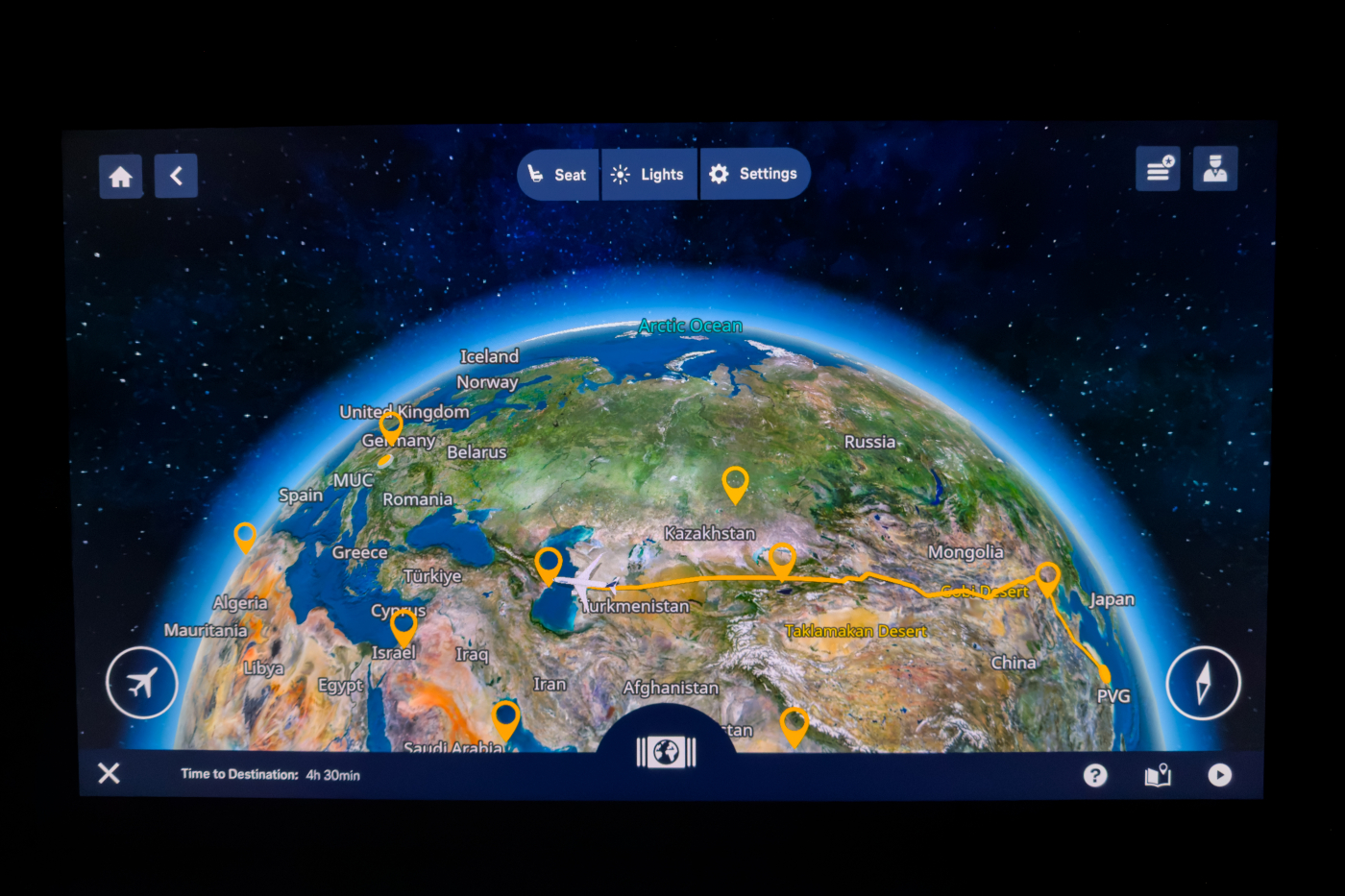
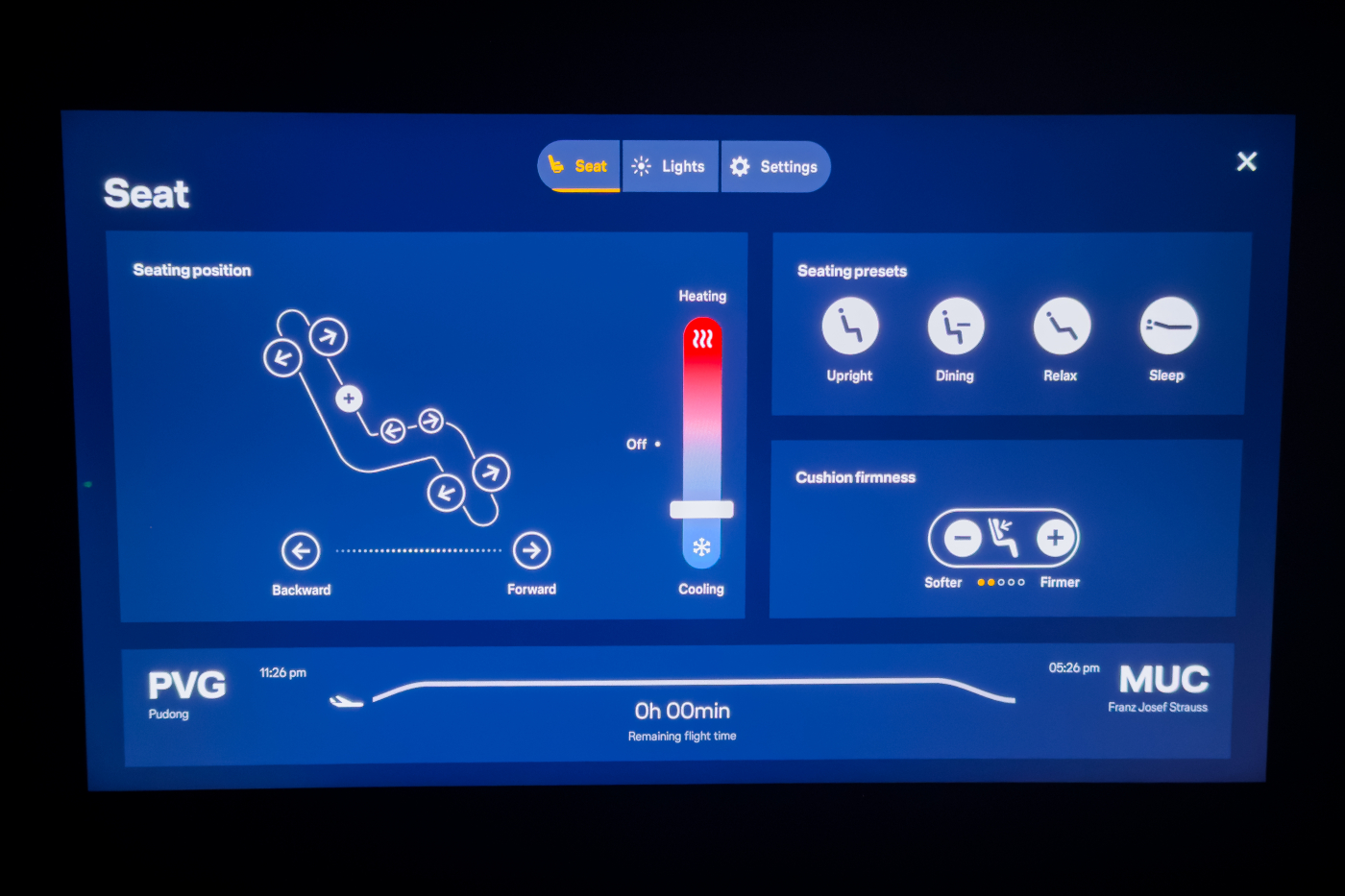
I tested the Bluetooth headphone connection, which worked perfectly with my AirPods, although the identifier displayed (likely the MAC address) was not particularly intuitive.
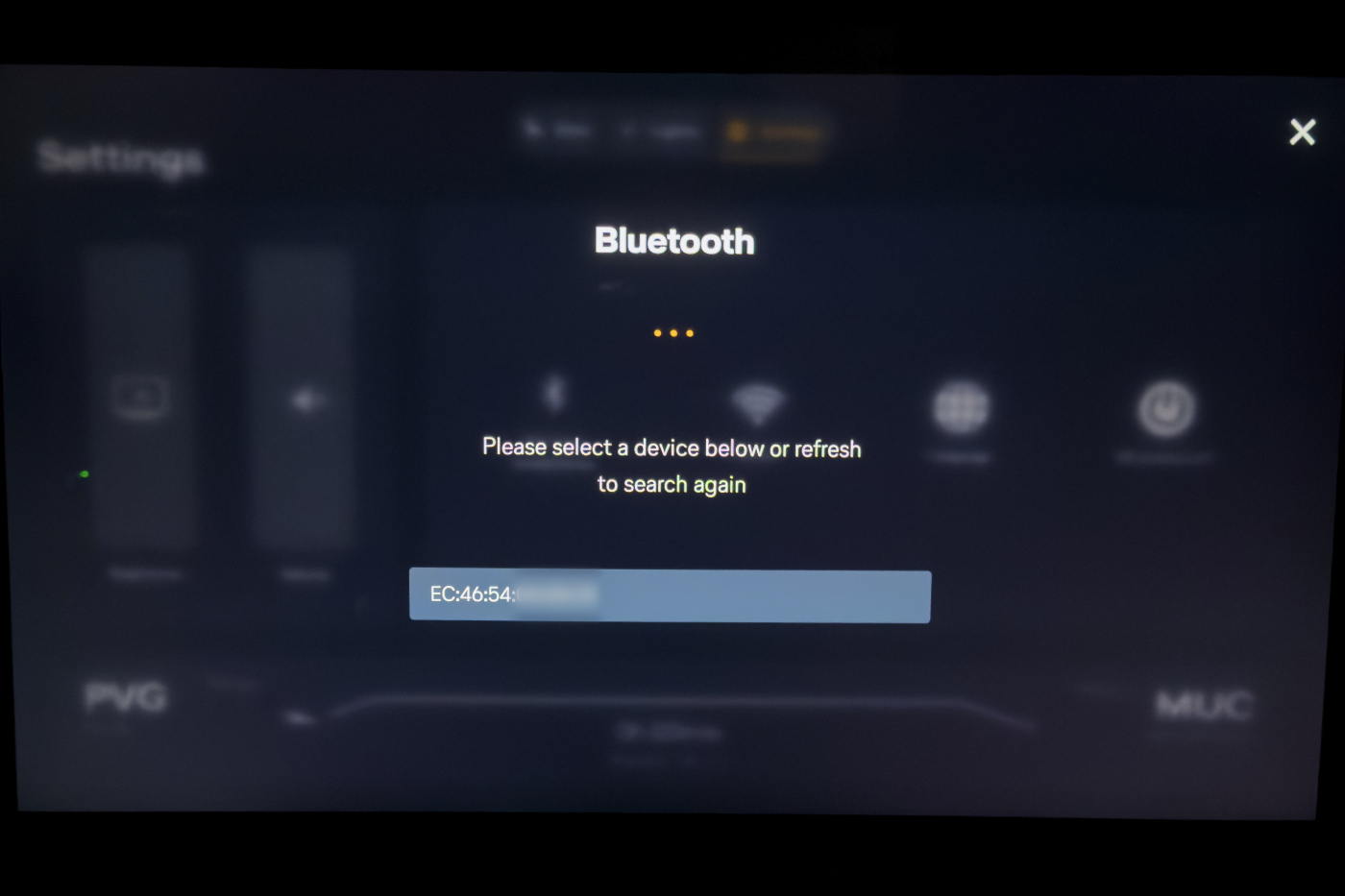
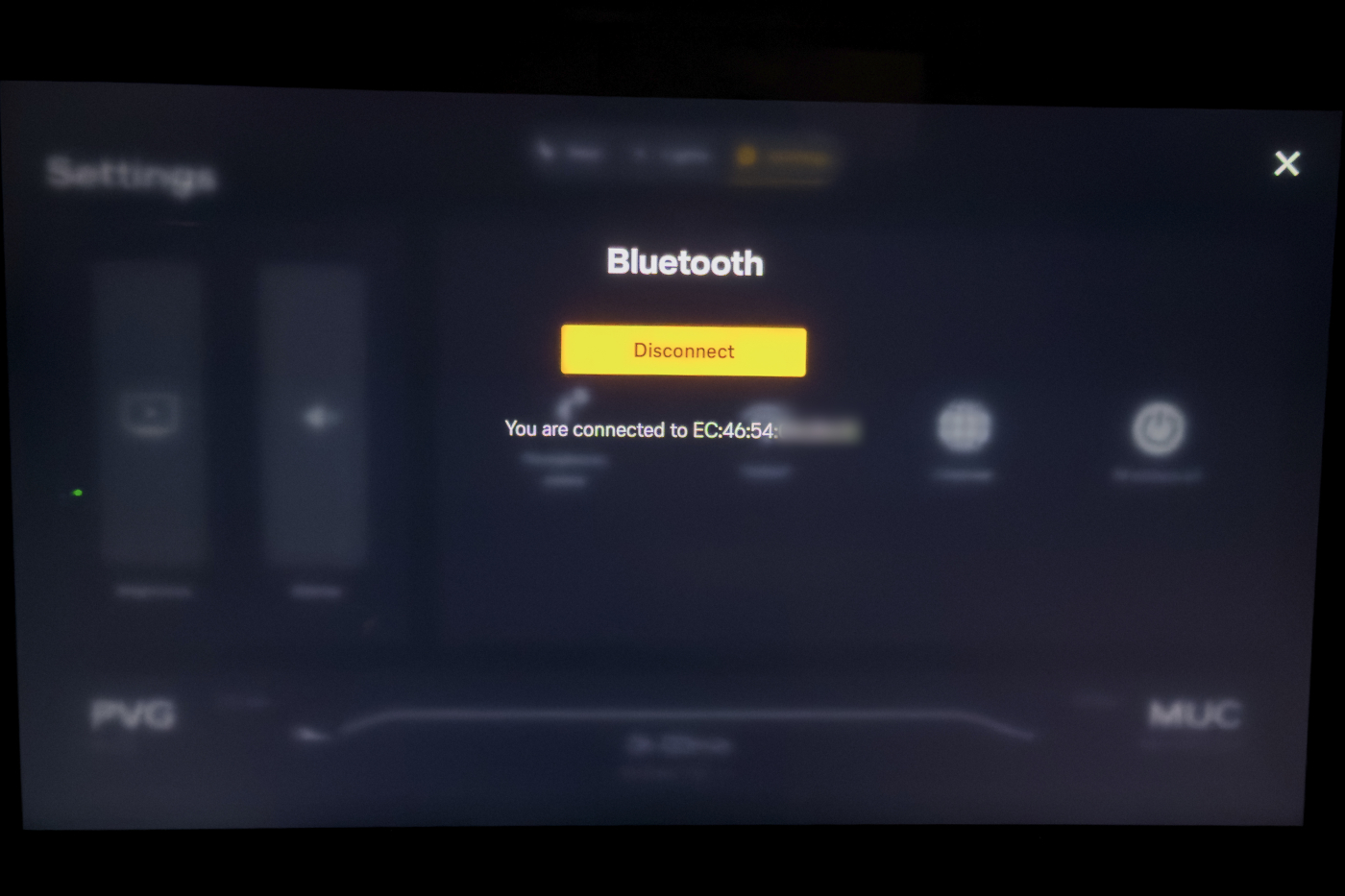
The headphones provided at the seat are AKG-branded with active noise cancellation. While not at a professional level, they are more than adequate for enjoying a movie in flight.
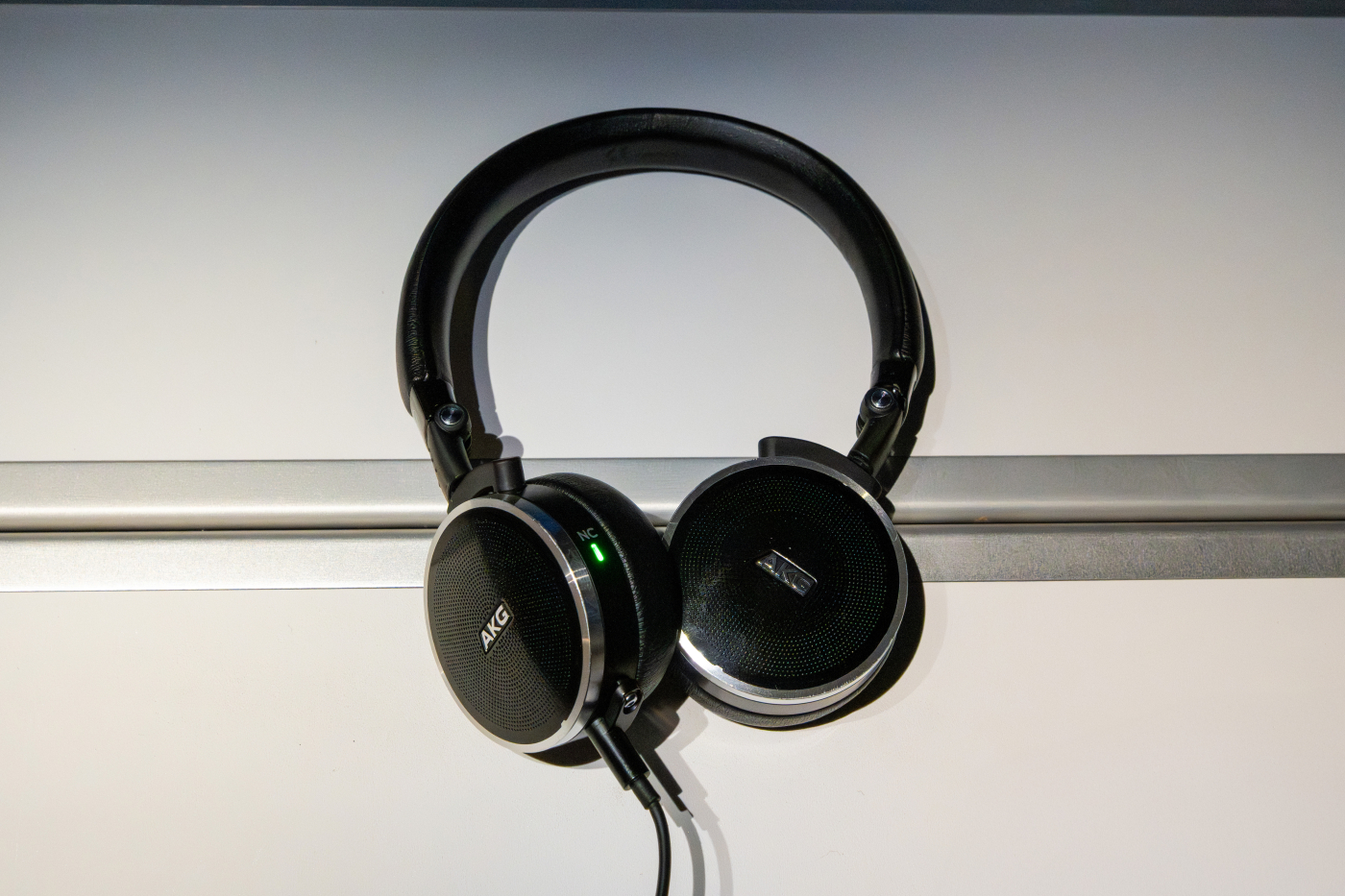
When it comes to cameras, this Airbus A350 is ahead of the game: whereas some aircraft of this type have none—or just three—Lufthansa offers five here! The two additional side views (left and right) are a real plus for passengers without a window seat.
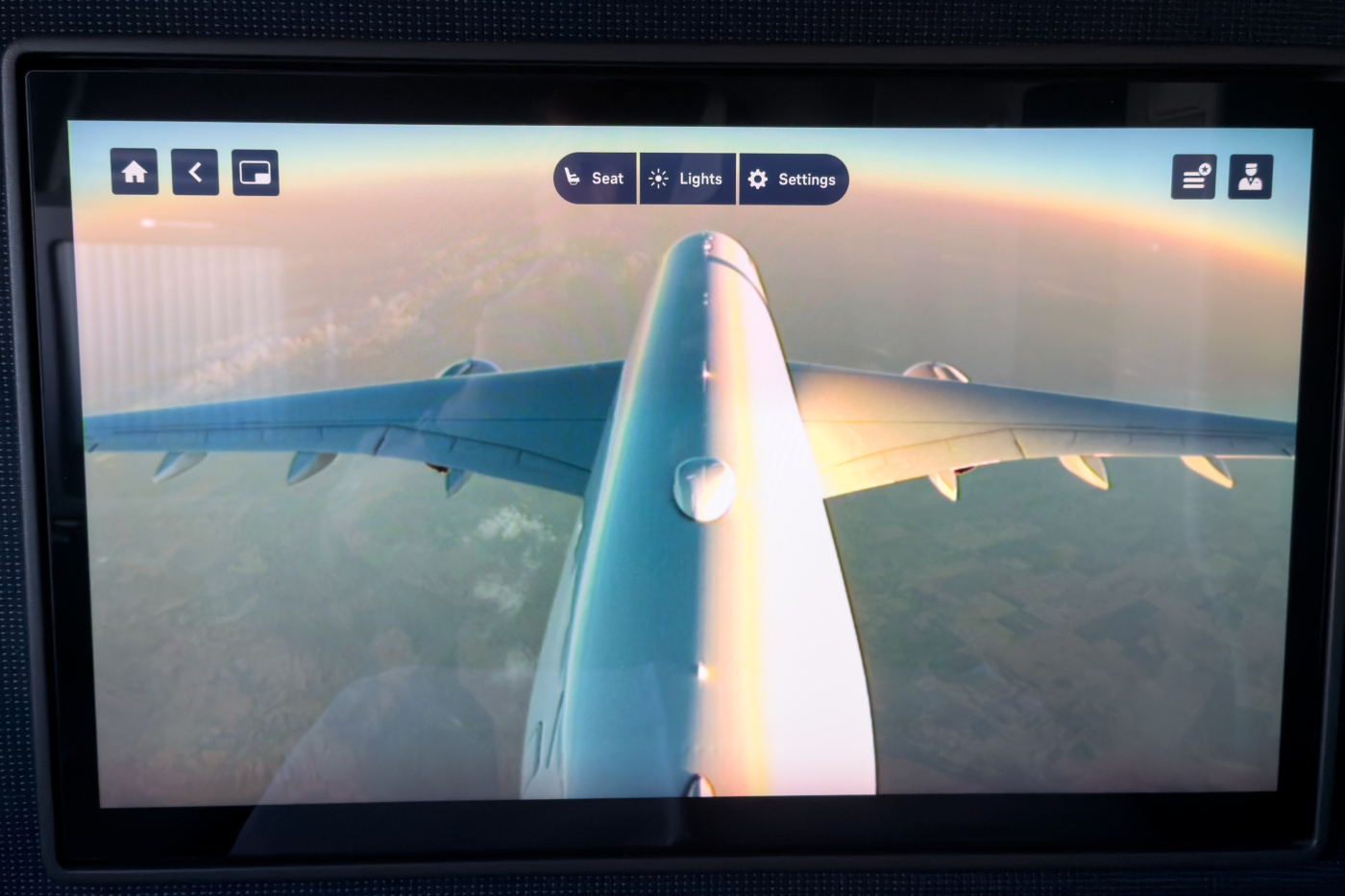
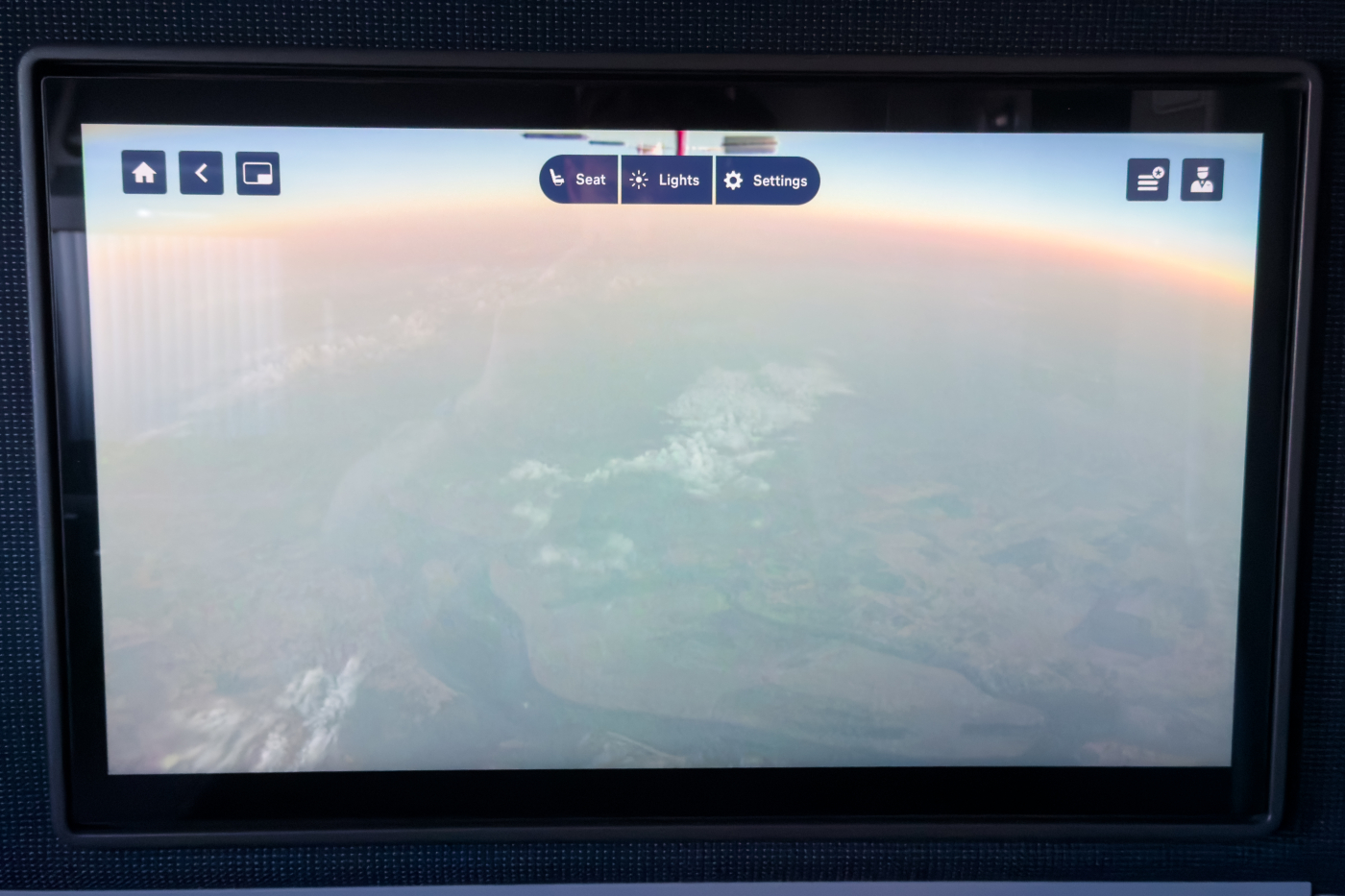
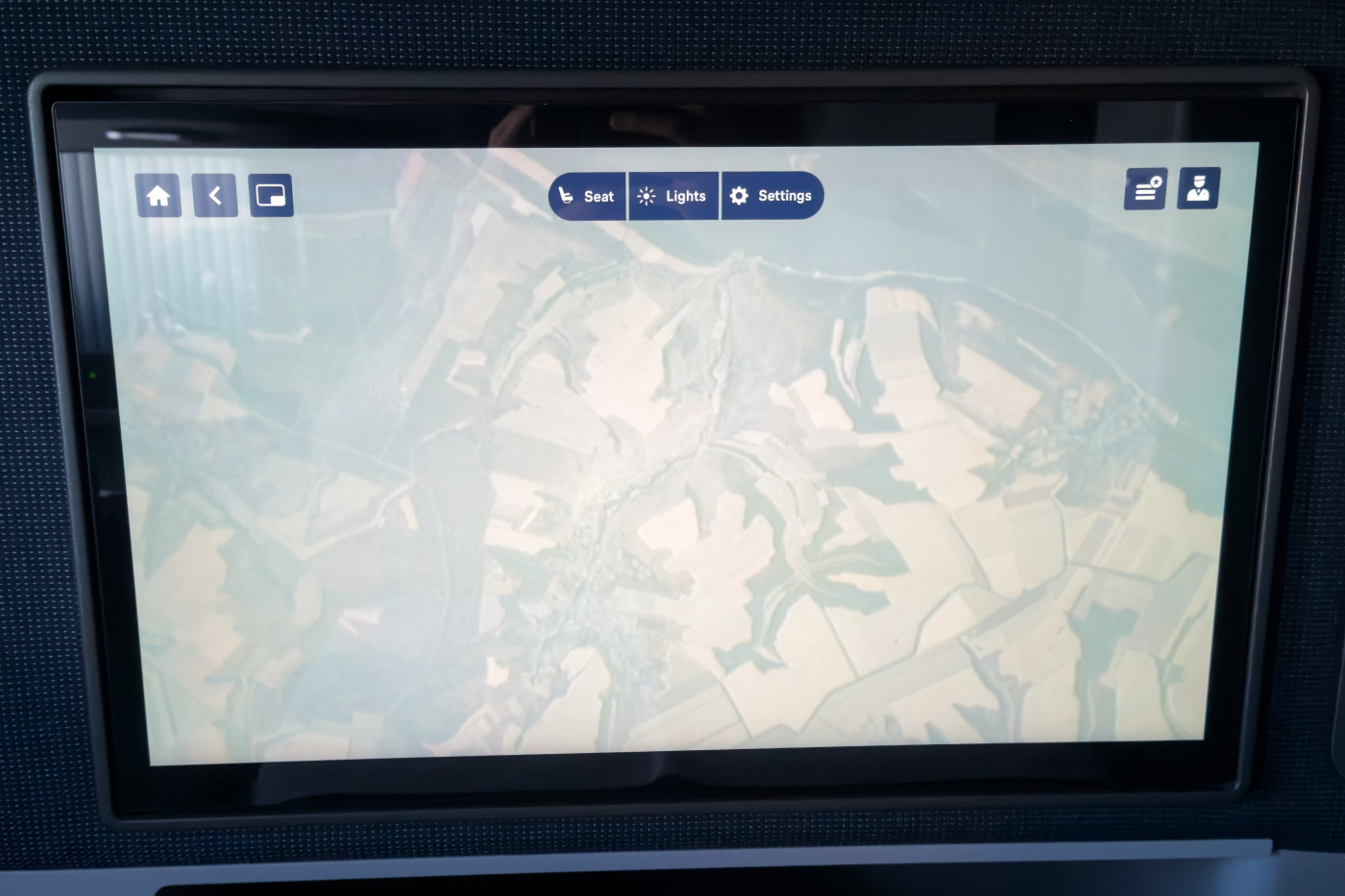

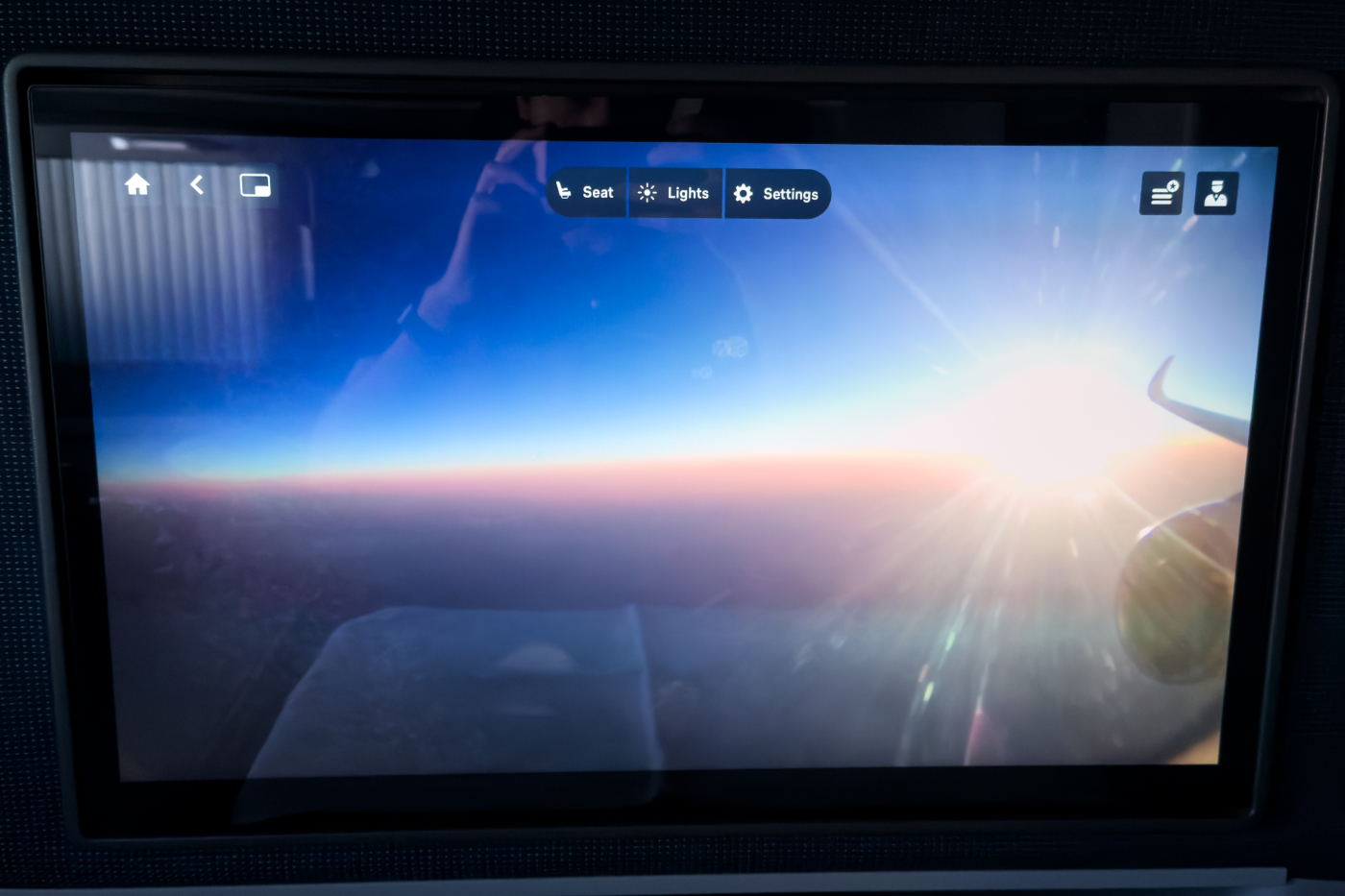
One final note: it is not possible to use the Control Panel and the main screen simultaneously. You must choose—either manage everything from the tablet and cast the content to the screen, or interact directly with the touchscreen while leaving the Control Panel aside.
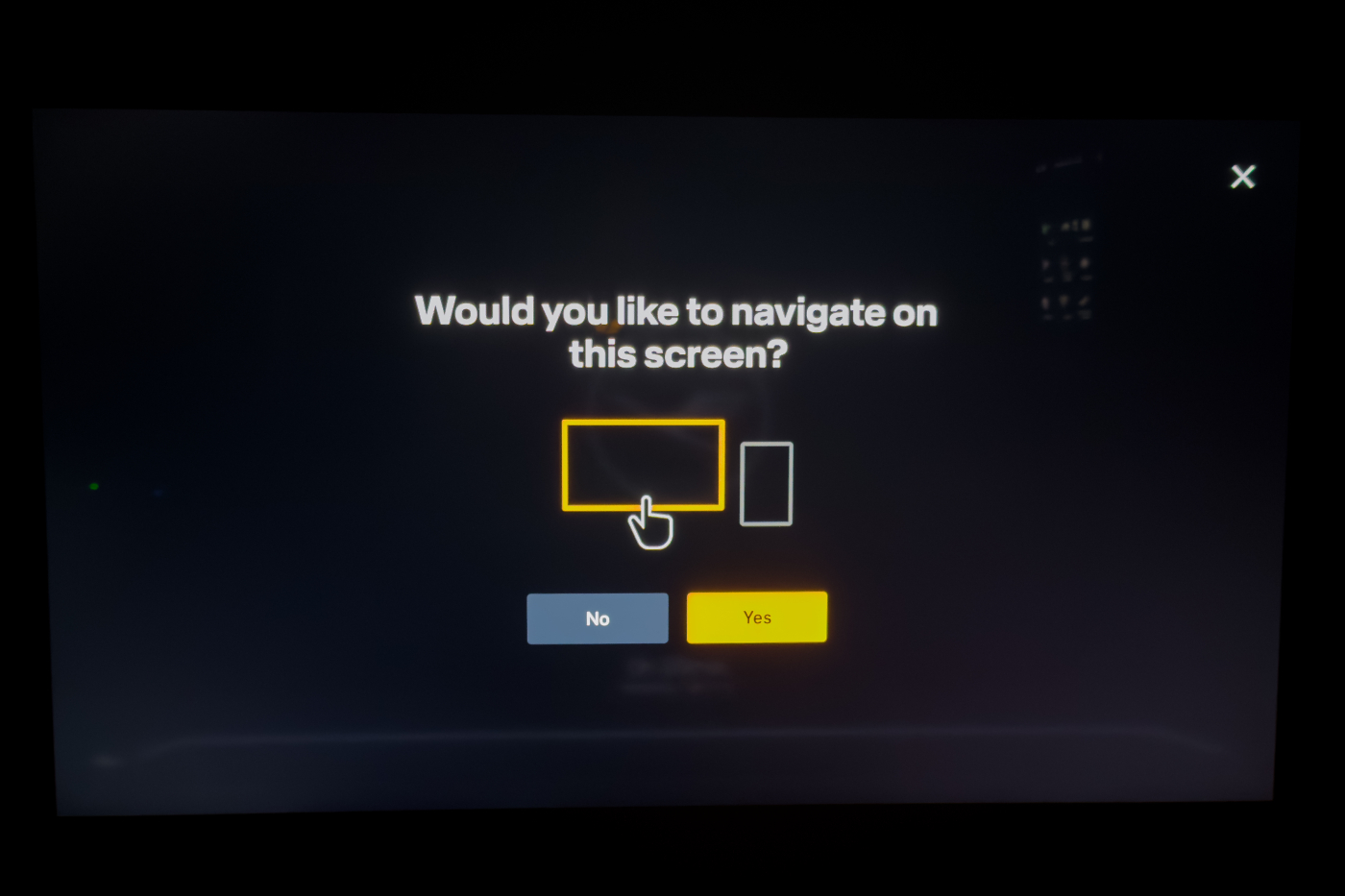
This Airbus A350-900 is normally equipped with Wi-Fi, like all long-haul aircraft in the Lufthansa fleet. However, it was not operational on this flight, with the crew confirming a technical issue.
Under normal circumstances, Lufthansa offers all passengers a free Wi-Fi package for messaging. Paid packages, providing higher speeds and full internet access, are also available. For a flight of this duration, unlimited access typically costs around €25.
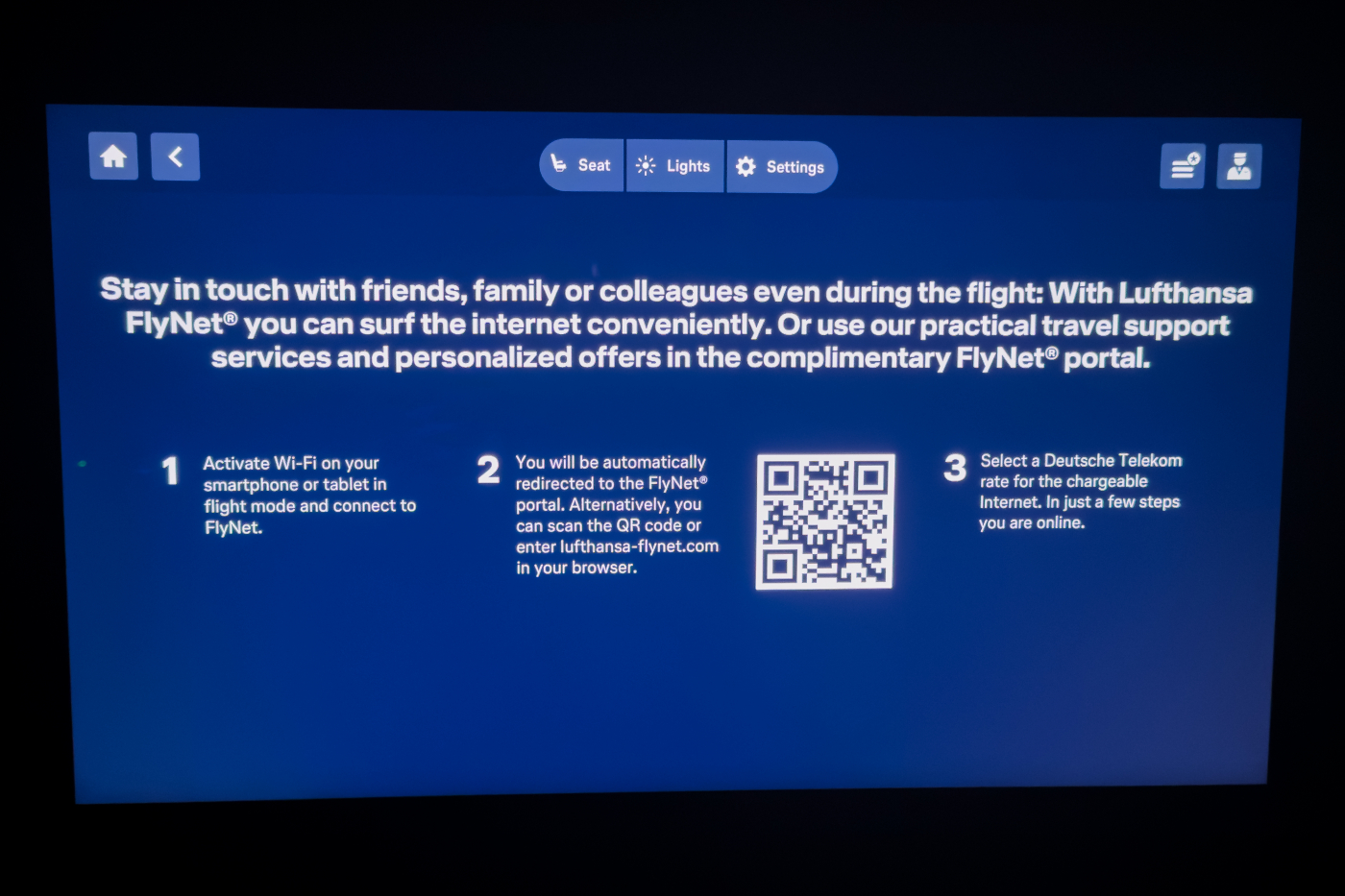
Taxiing in Shanghai
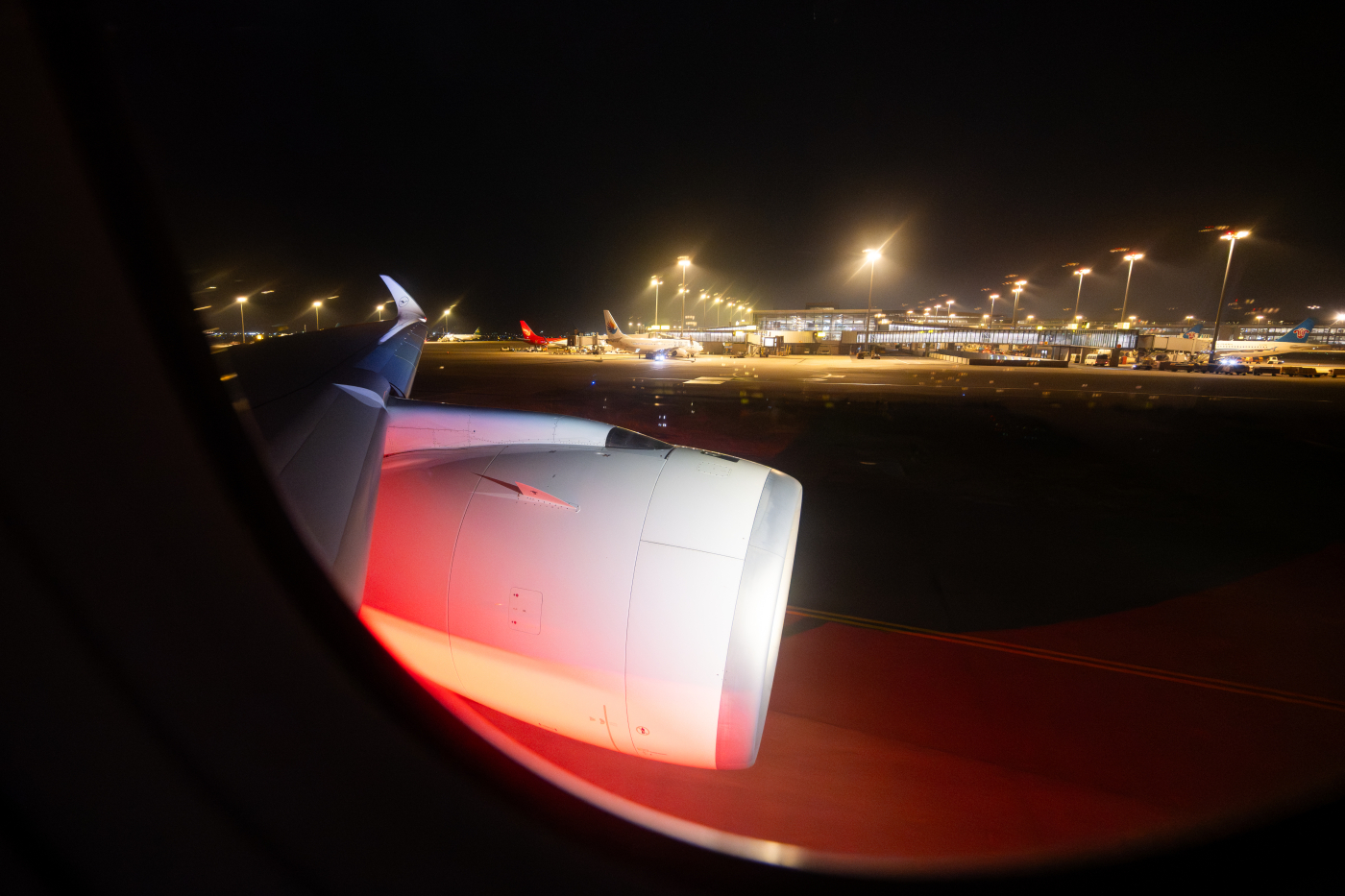
Sunrise over the Black Sea
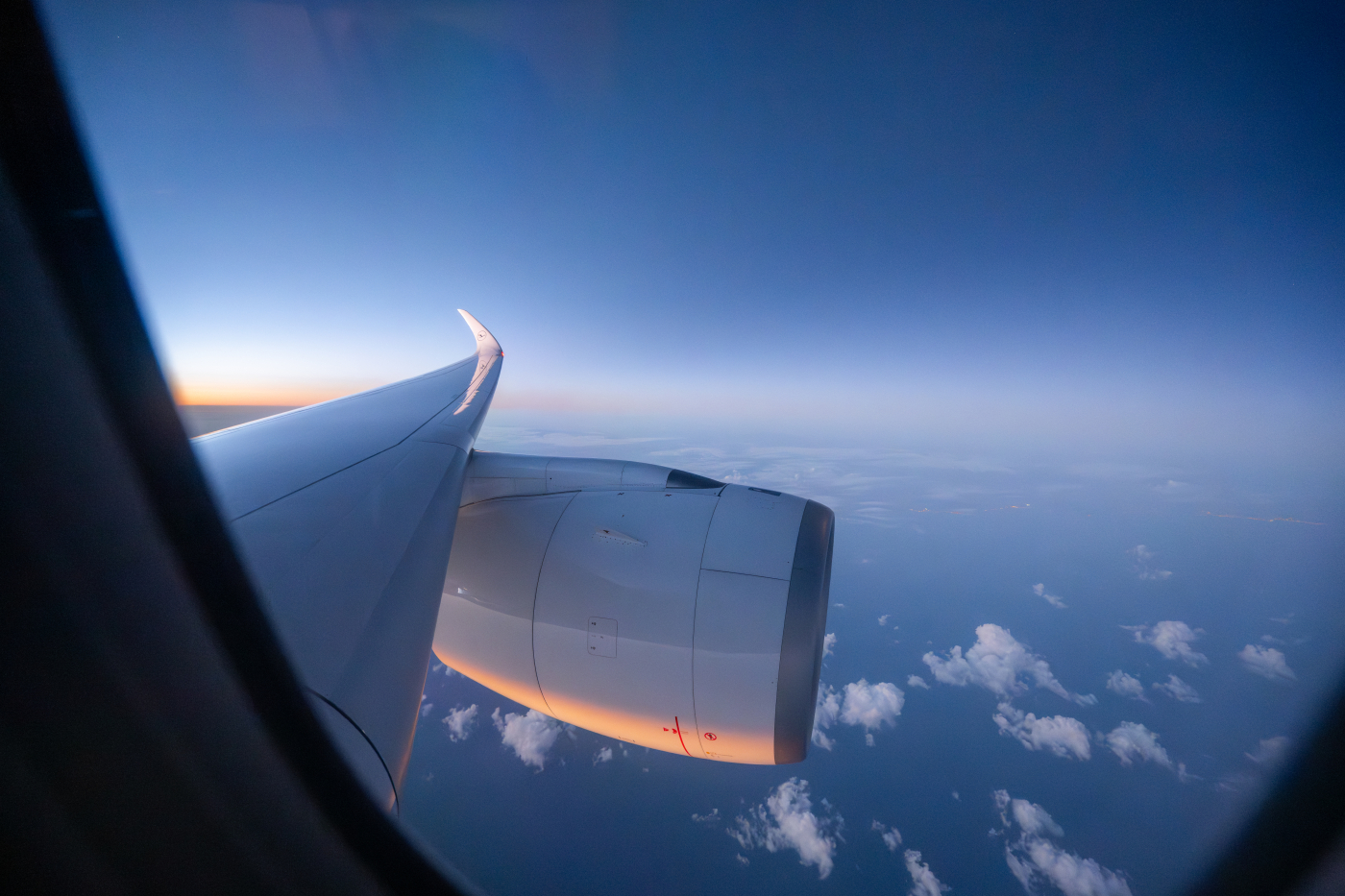
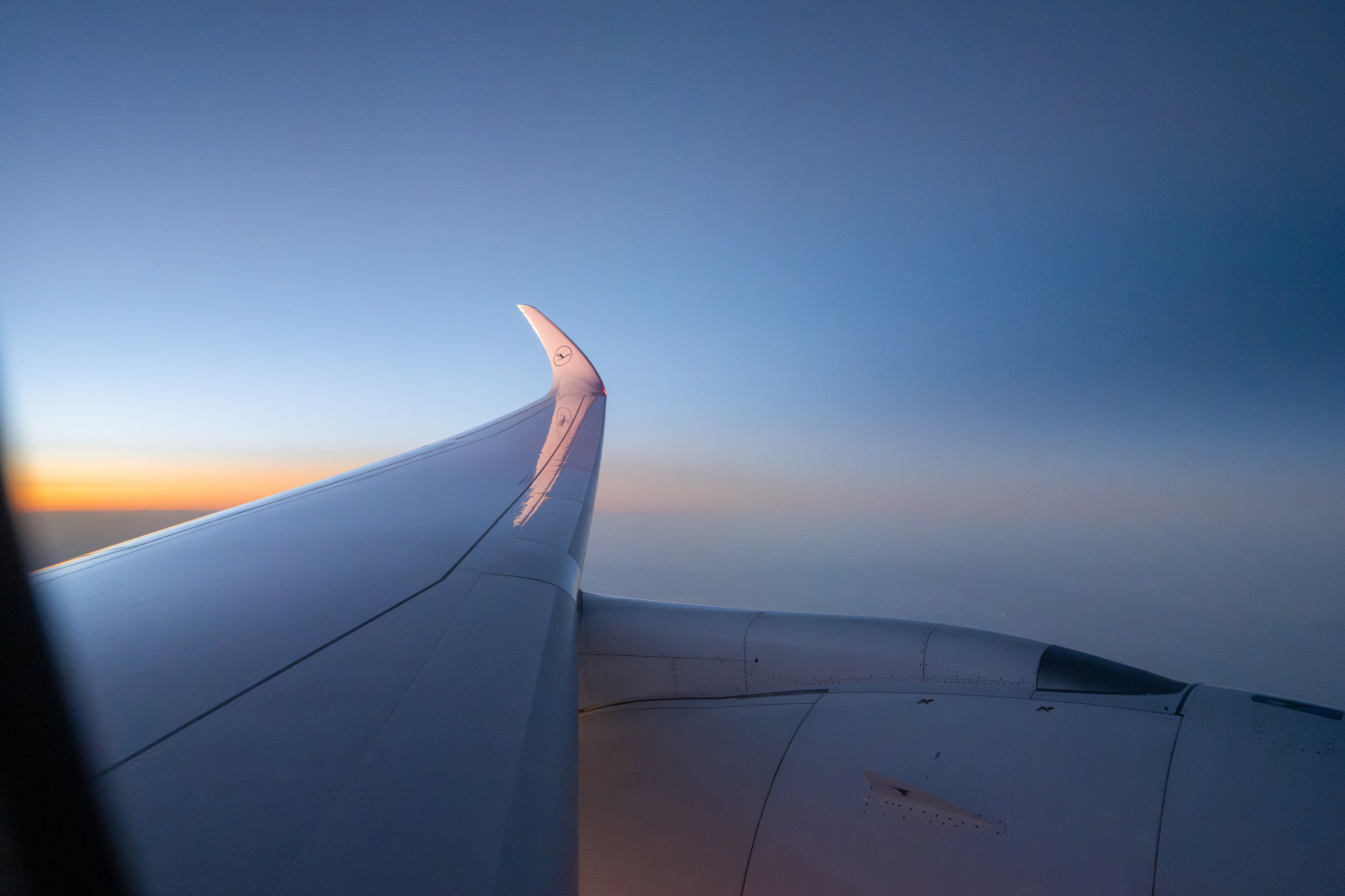
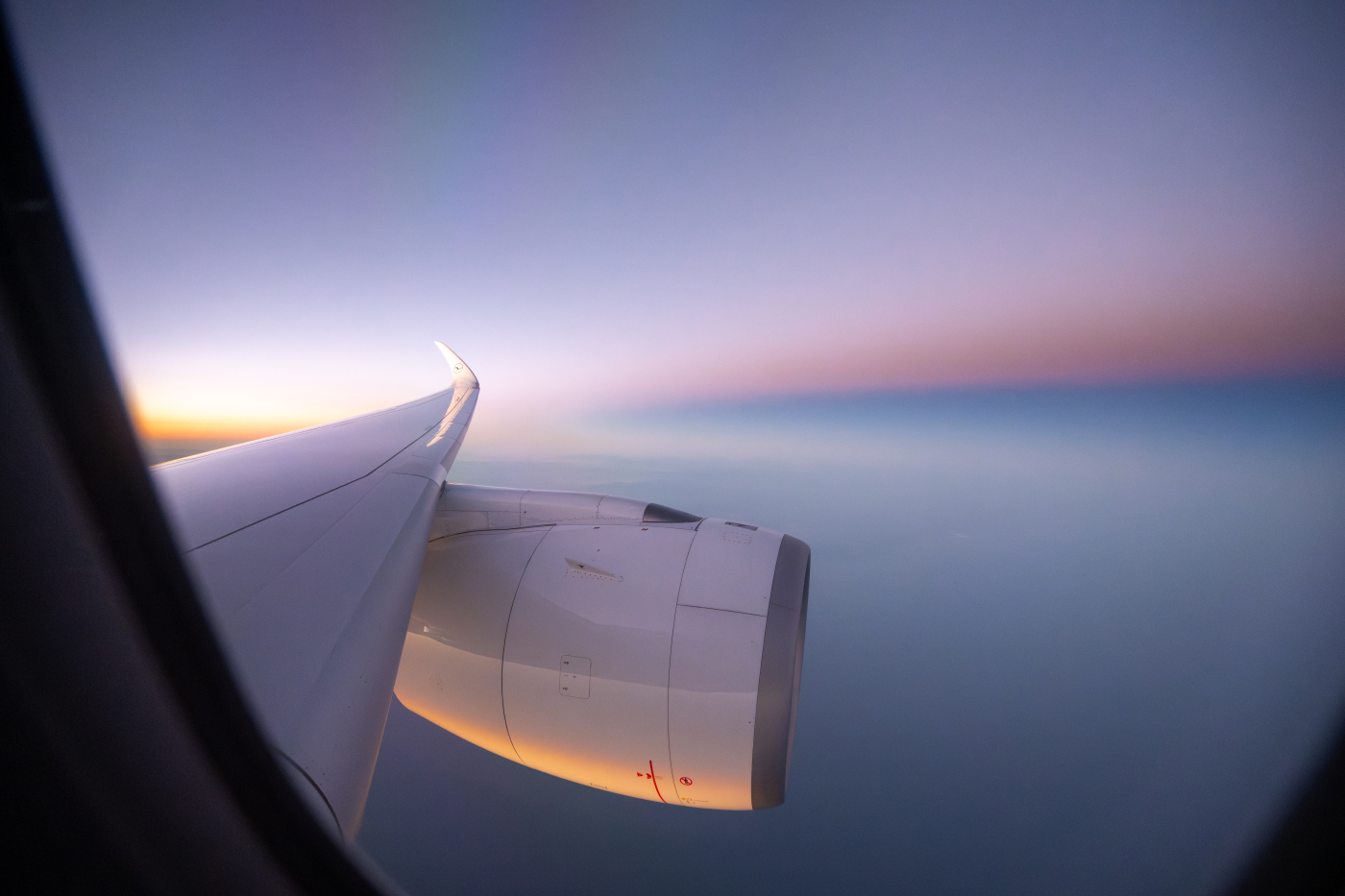
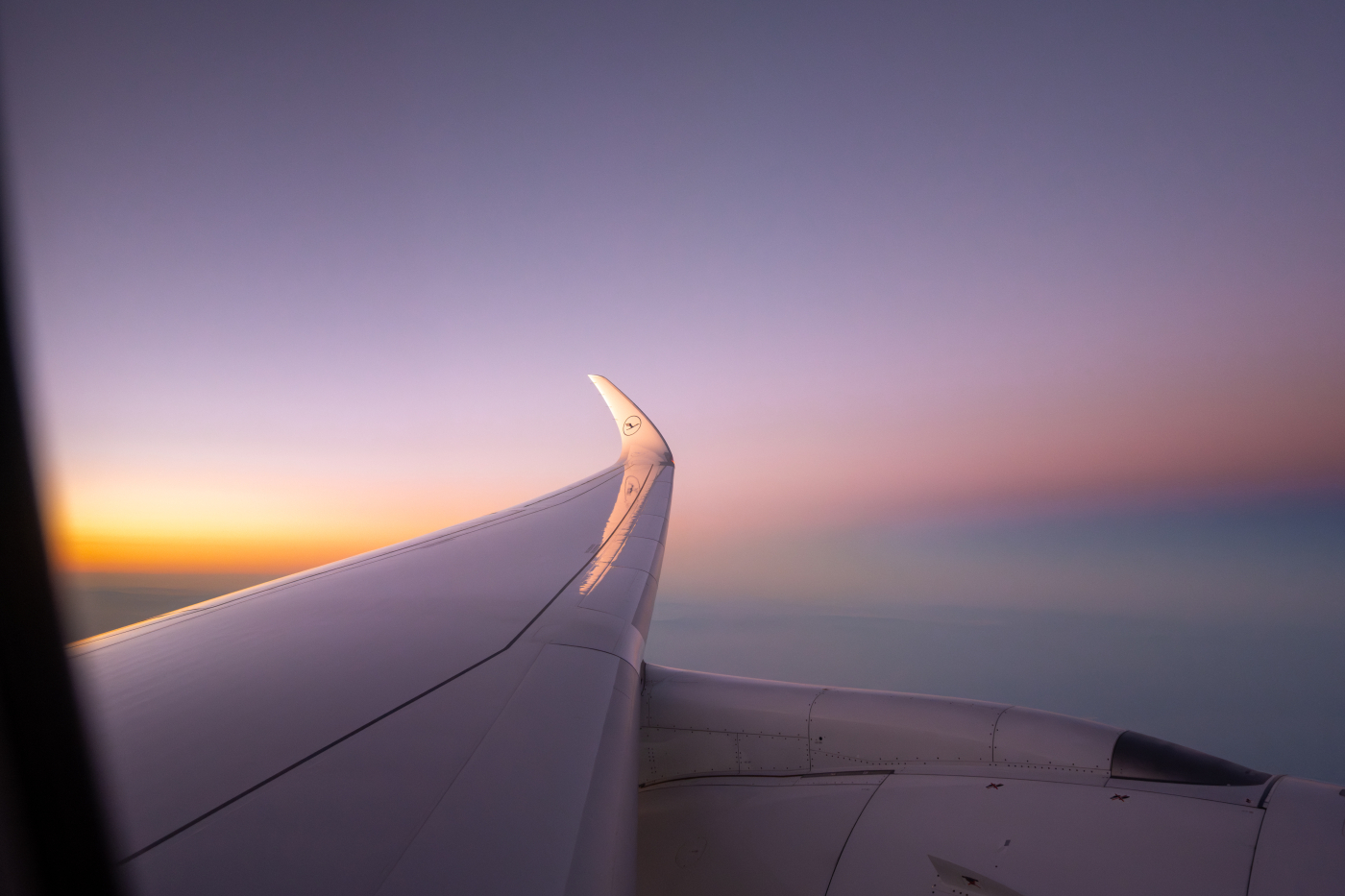
Descent and arrival in Munich
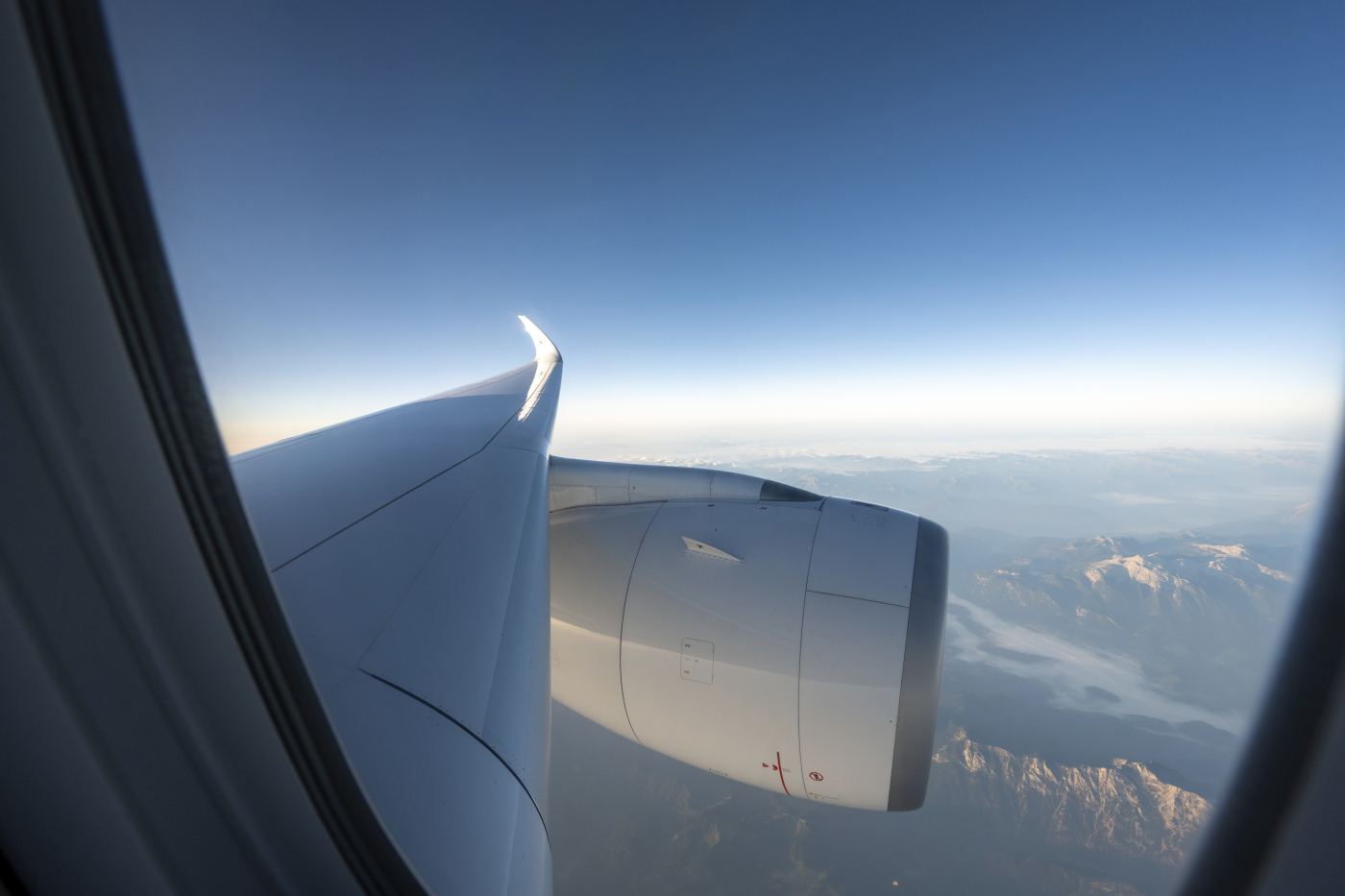
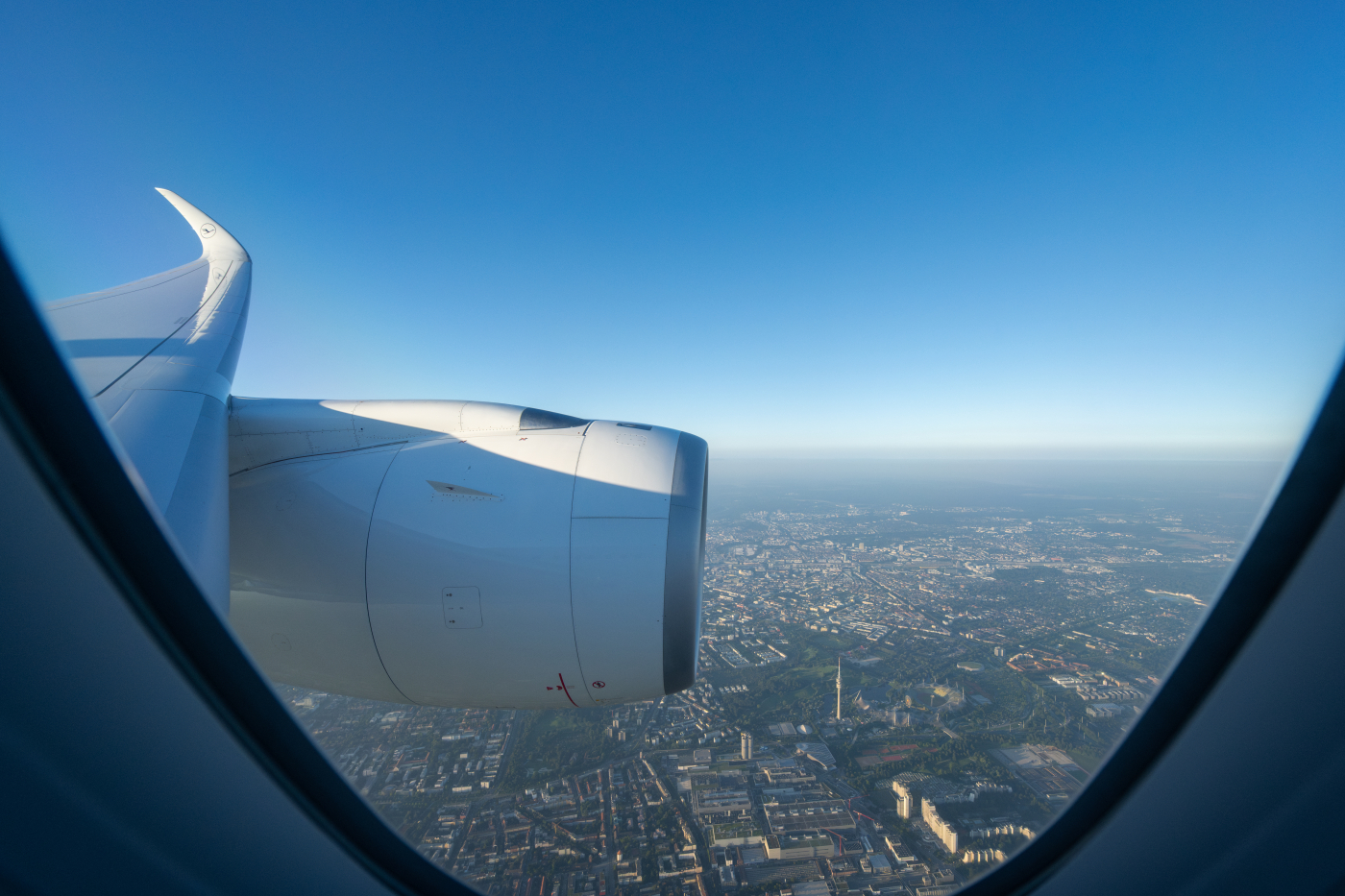
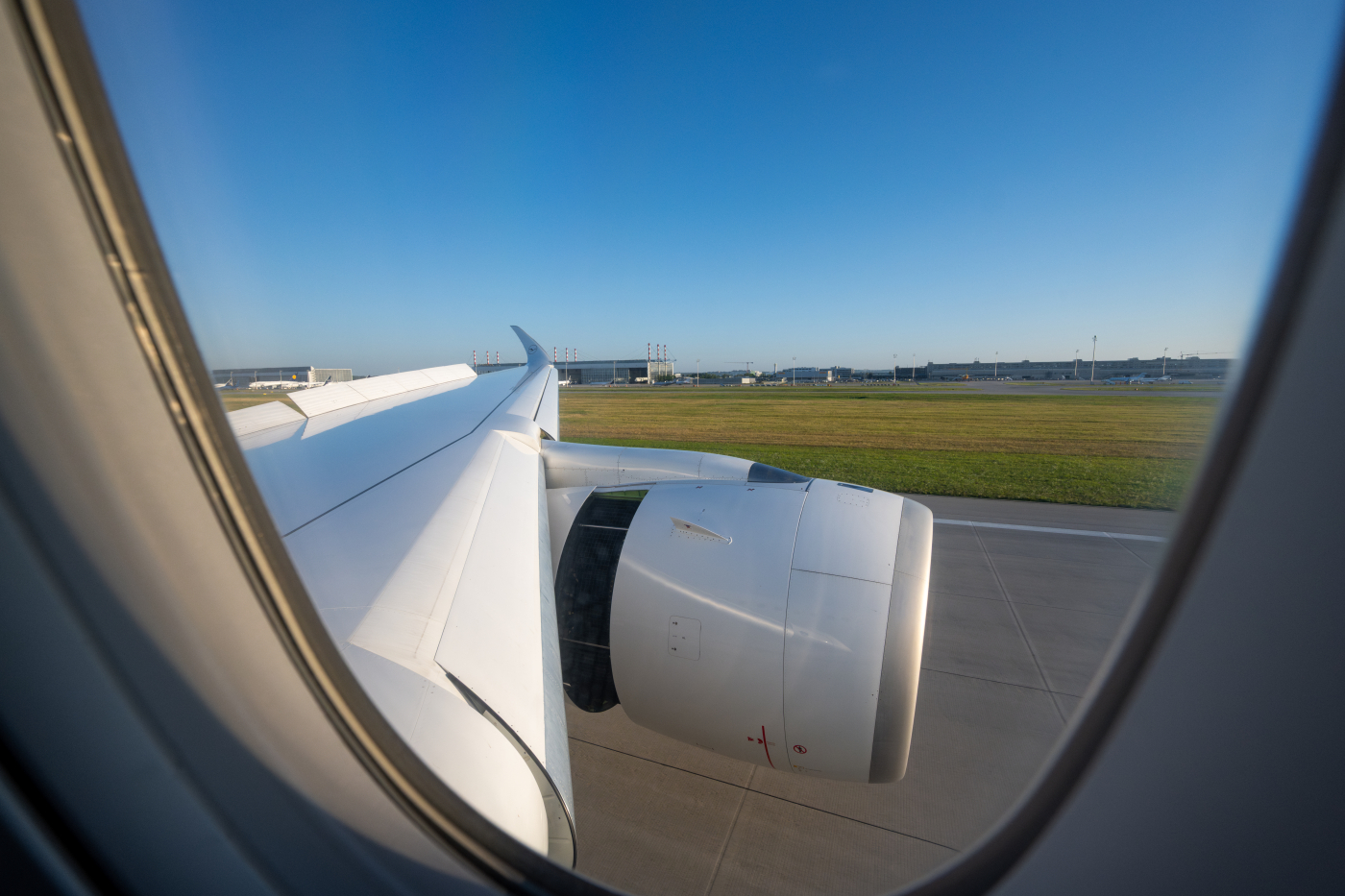
This Shanghai–Munich flight on one of the few Airbus A350-900s equipped with the Allegris cabin was a unique opportunity to experience Lufthansa's flagship product in particularly favorable conditions.
Suite 8A lived up to the hype. The generous space, cleverly designed storage areas, and—above all—the remarkable privacy provided by high walls and a sliding door created an ideal environment for sleeping, working, or enjoying a meal in peace. The seat itself offered satisfying comfort in the fully flat position—wide and long enough, with the mattress pad being a particularly welcome touch. The seat heating and cooling functions were an innovative addition, both effective and enjoyable to use.
The crew delivered an exemplary performance throughout the flight. The flight attendant responsible for my section was consistently attentive and impressively proactive, providing a truly personalized service—something that is unfortunately not always the norm with Lufthansa, making it all the more appreciated here.
As for dining, the overall quality was solid. The dishes co-created with the Michelin-starred restaurant in Shanghai lived up to expectations, especially the sesame beef tenderloin, which was full of flavor. The cheese plate, however, was underwhelming—lacking in character and taste, as is too often the case with Lufthansa.
Both the Control Panel and the main entertainment screen impressed with their user-friendliness. The interface was intuitive and easy to navigate, while the 24-inch 4K display offered outstanding visual comfort. Bluetooth headphone pairing worked flawlessly. On the downside, Lufthansa's film library remains a weak spot: limited new releases and a lack of diversity.
The absence of Wi-Fi due to a technical issue deprived this long-haul flight of a connectivity feature that has become essential for many travelers.
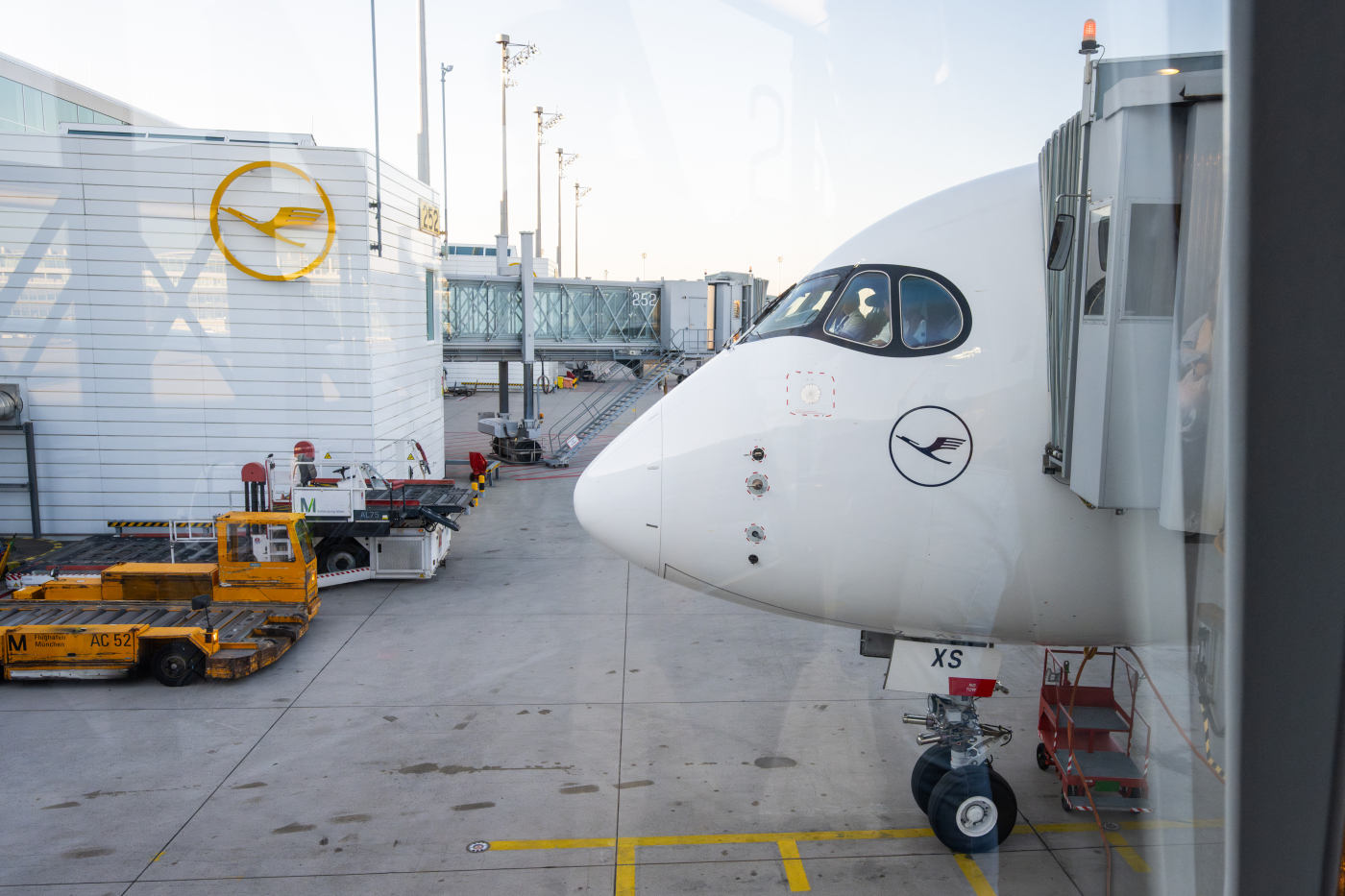
It's important to keep this enthusiasm in check. This exceptional experience was largely due to luck—being assigned a Suite without paying the extra fee. Normally, securing such a seat comes with a €600 surcharge, which can significantly increase the total ticket cost.
More concerning is the question of what the experience is like in the twelve “classic” Business Class seats in the cabin. Without the Suite's unique advantages—sliding door, extra space, exclusive services—these seats may disappoint compared to the high expectations set by Allegris marketing.
The biggest challenge for Allegris remains its limited availability. As of mid-August 2025, only ten aircraft in Lufthansa's long-haul fleet of over one hundred are equipped. This rarity is compounded by operational constraints: a single base in Munich, a limited destination network, seasonal route variations, and ongoing certification delays for the Boeing 787-9 slowing the rollout.
Feedback from the crew also highlights the operational challenges of this complex cabin: a small galley, incomplete crew training, mechanical quirks, and difficulties accommodating families with children—all reminders that Allegris is still in its shakedown phase.
Ultimately, while the Business Class Suite is undeniably an exceptional product for those lucky enough to fly it, the overall Allegris experience still depends on many variables. Passengers eager to try this cabin will need patience and flexibility, as a broader rollout could still take several years.
That said, the new product is a dramatic leap forward compared to Lufthansa's traditional 2-2-2 Business Class cabin, long familiar to frequent flyers. The improvement is striking, and it's encouraging to finally see this level of innovation and refinement from Lufthansa, which had been trailing some competitors in this segment. Despite the current deployment challenges, Allegris holds strong promise for the airline's future. This first experience in the Business Class Suite was enough to convince me that I would gladly fly it again.
